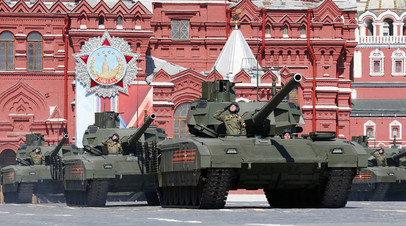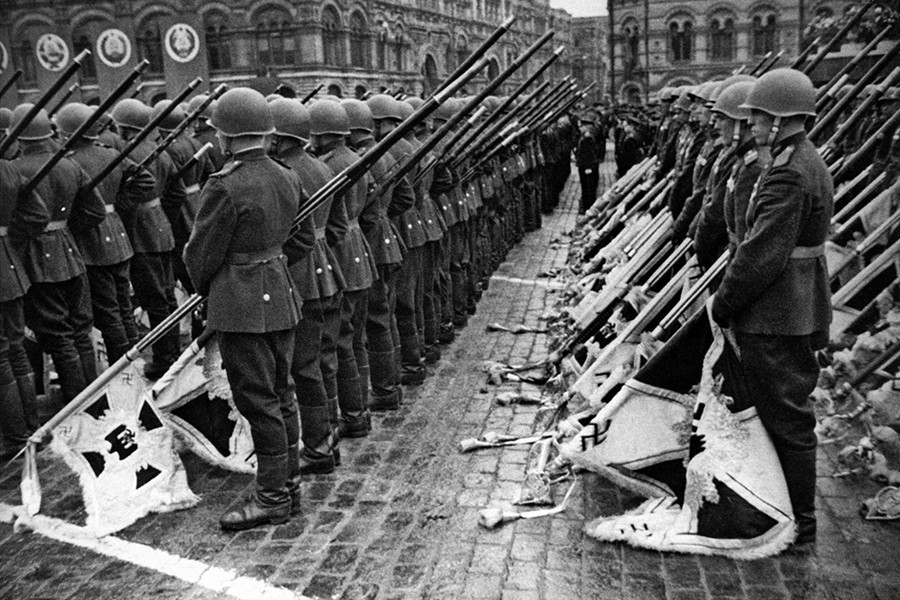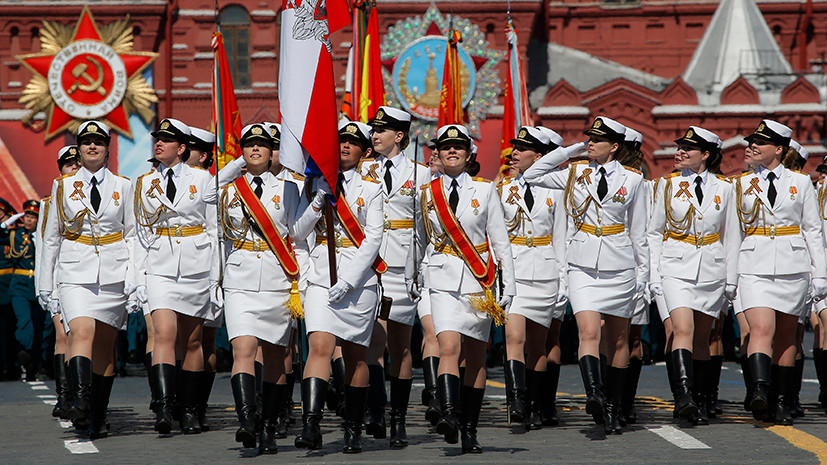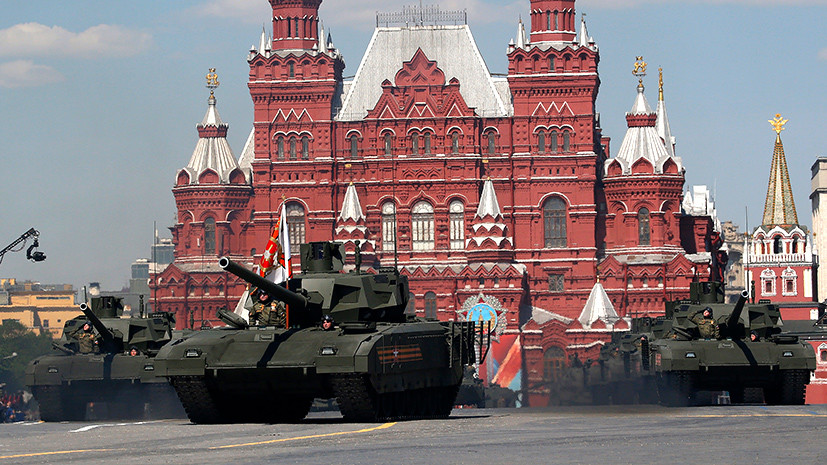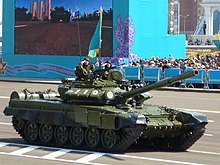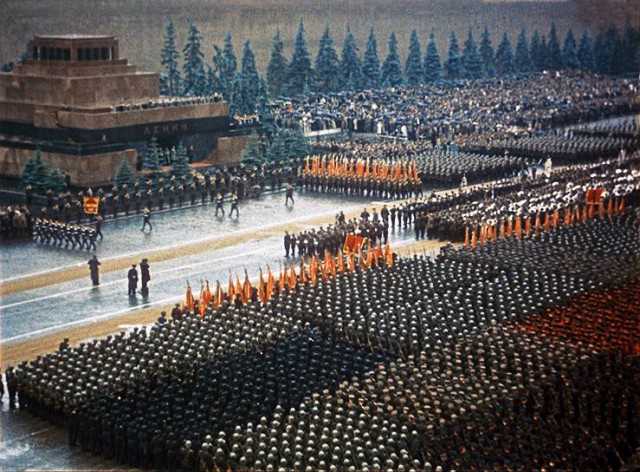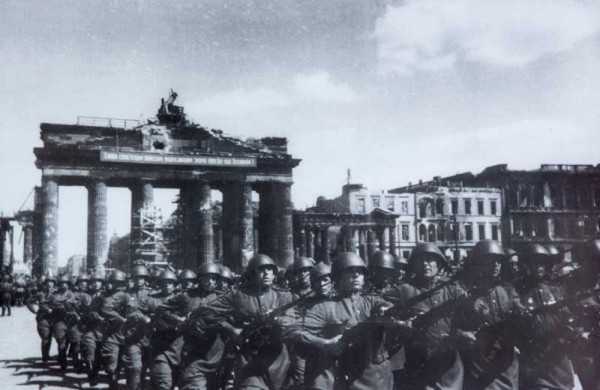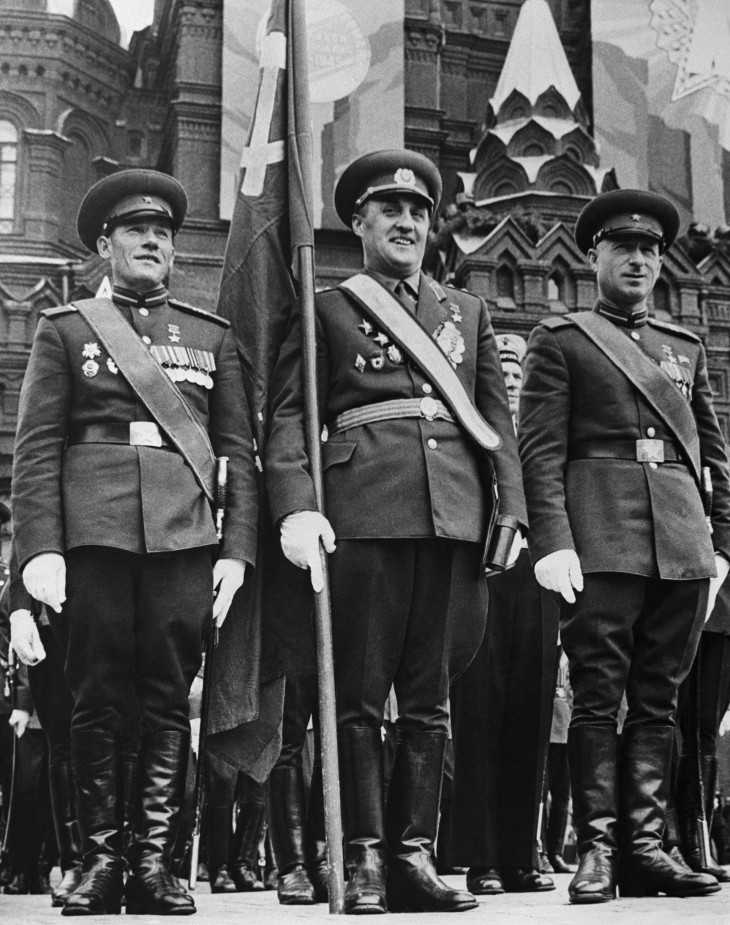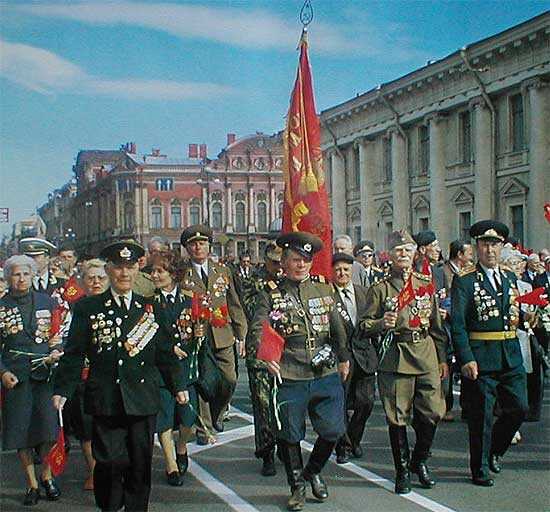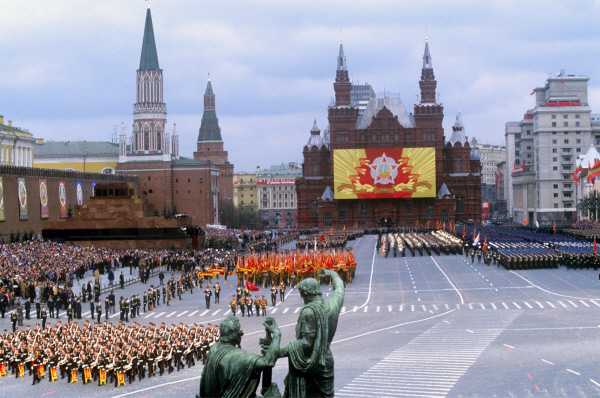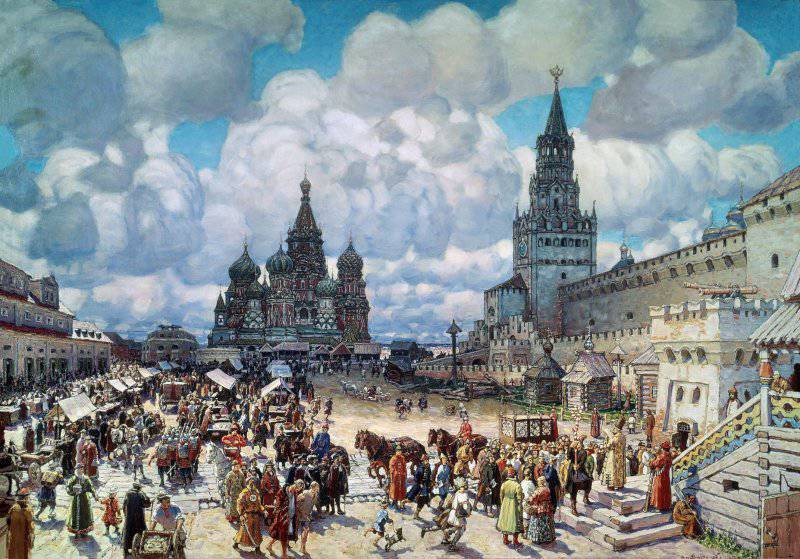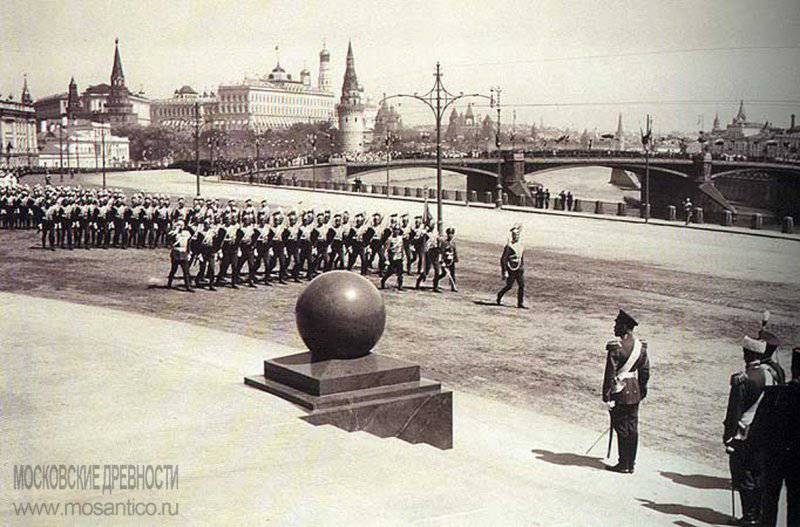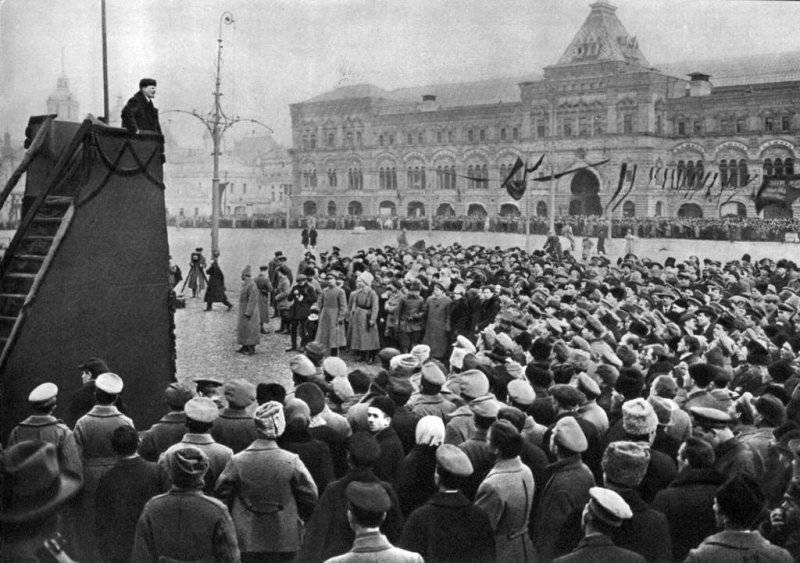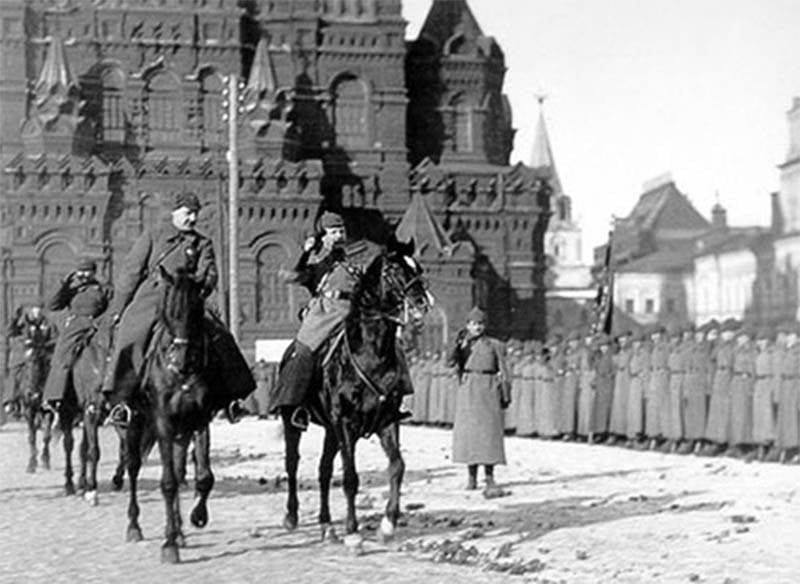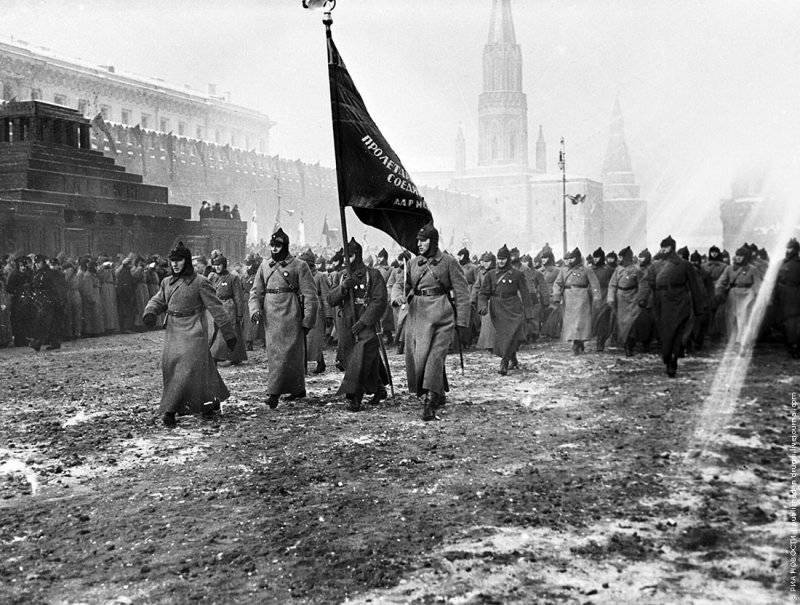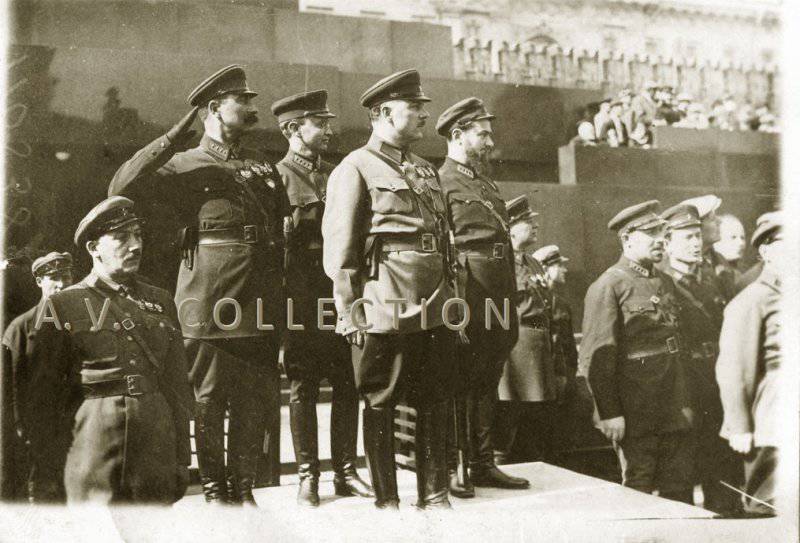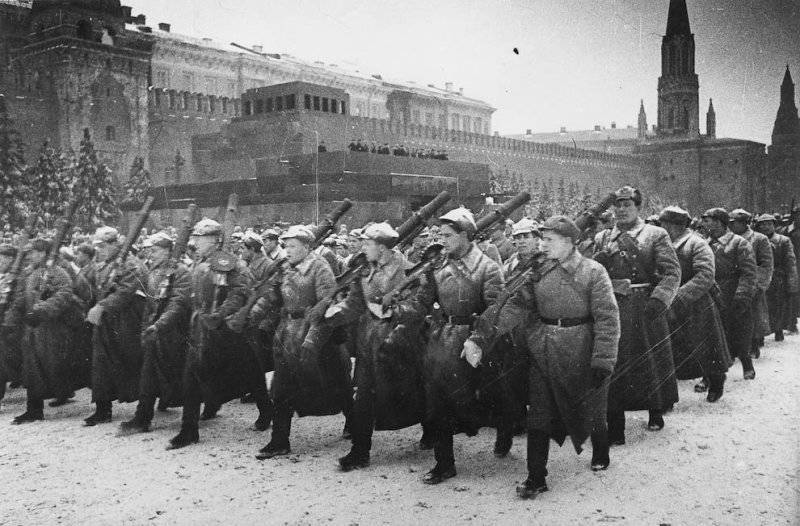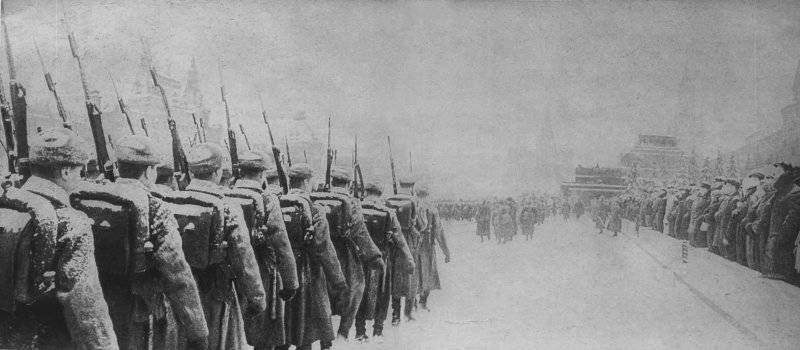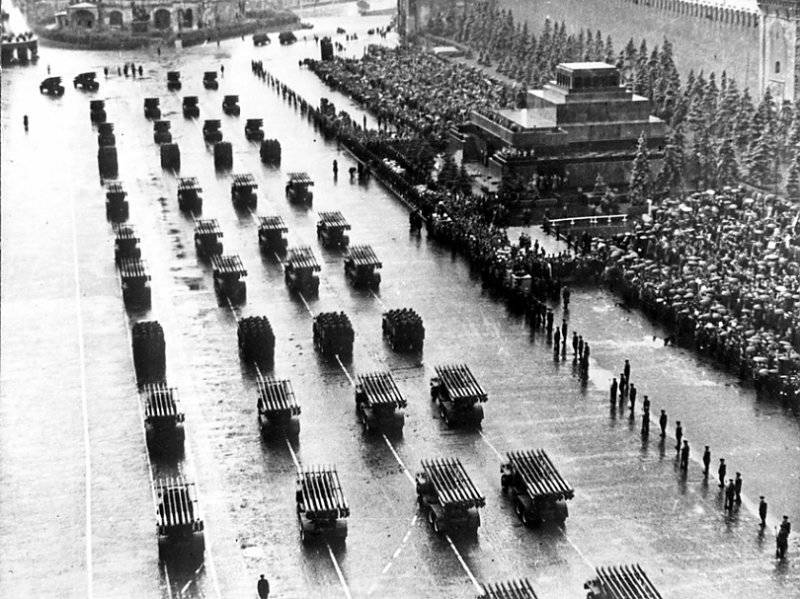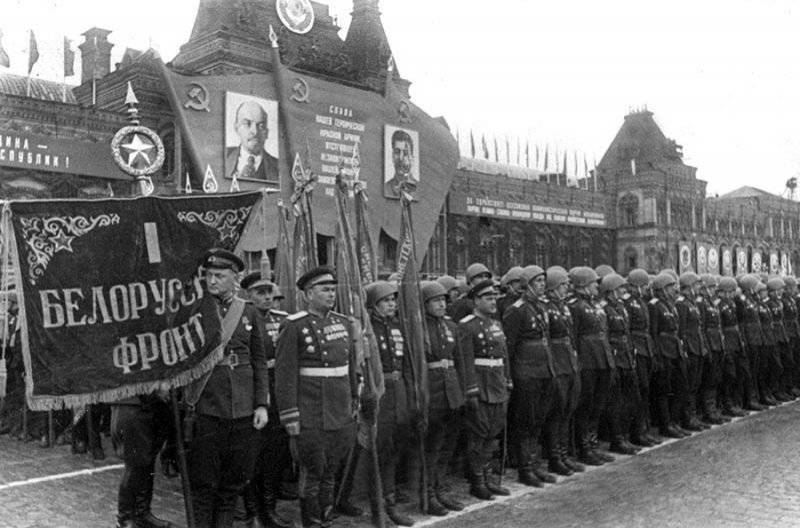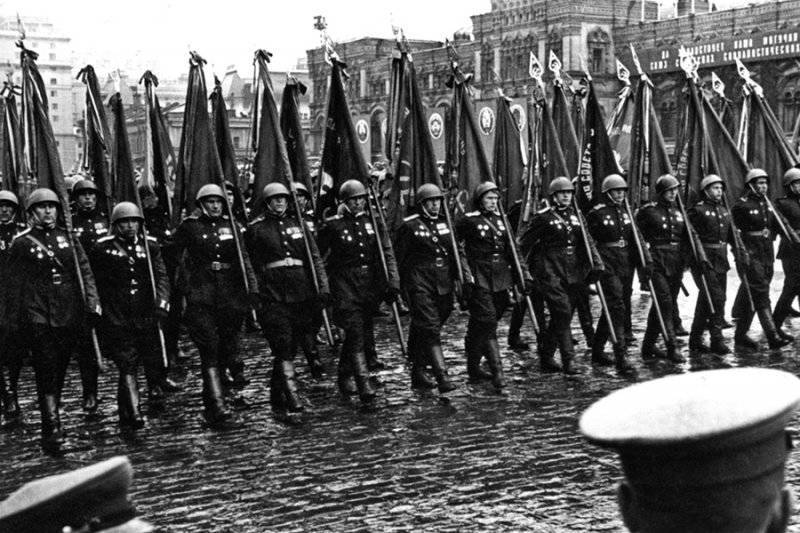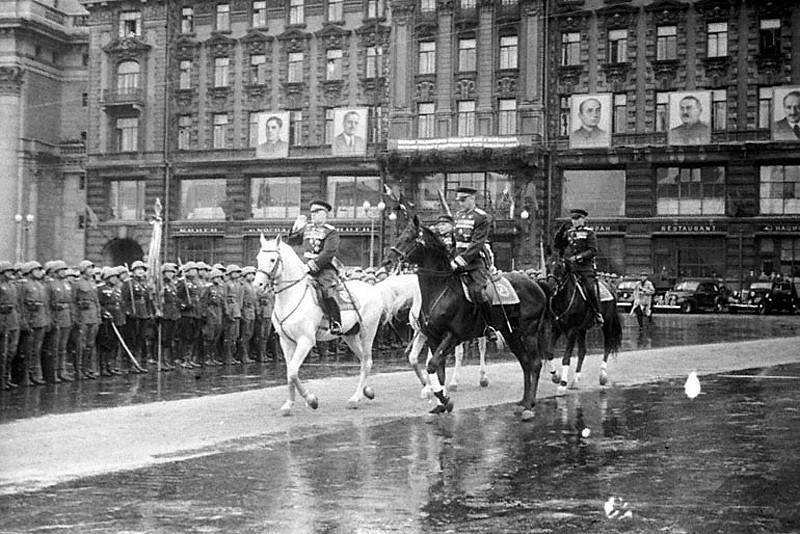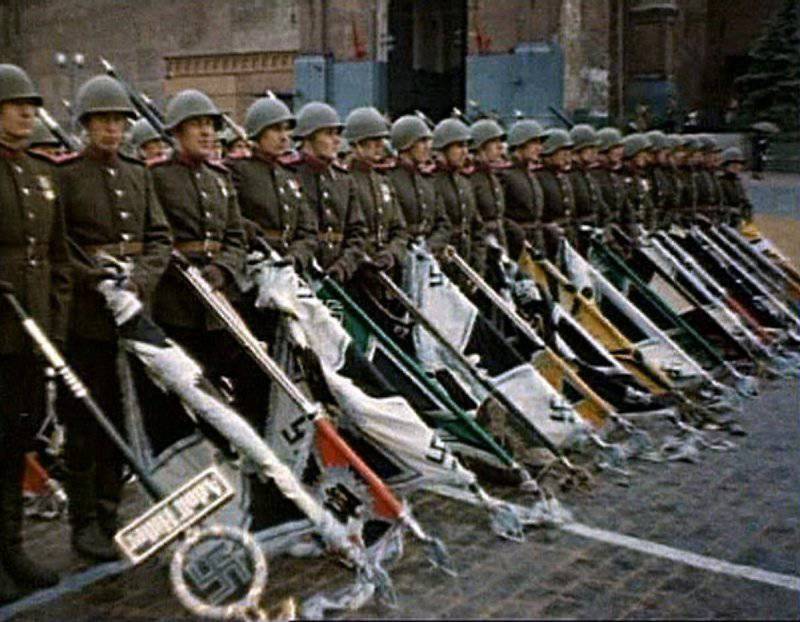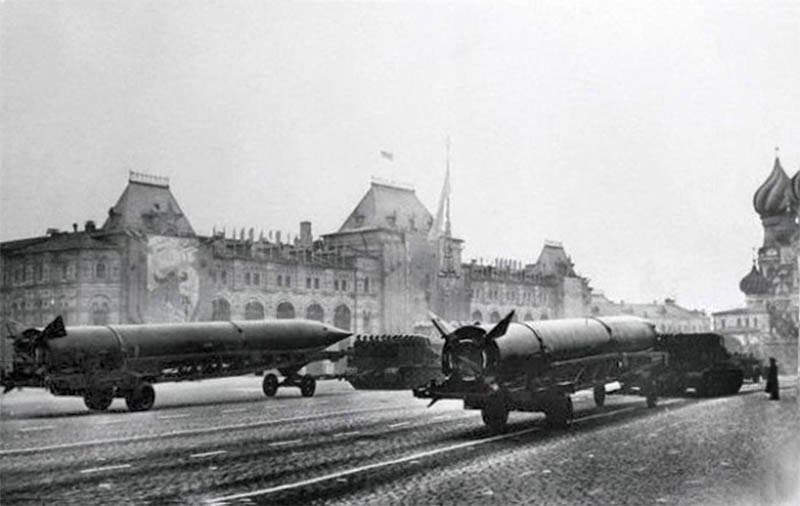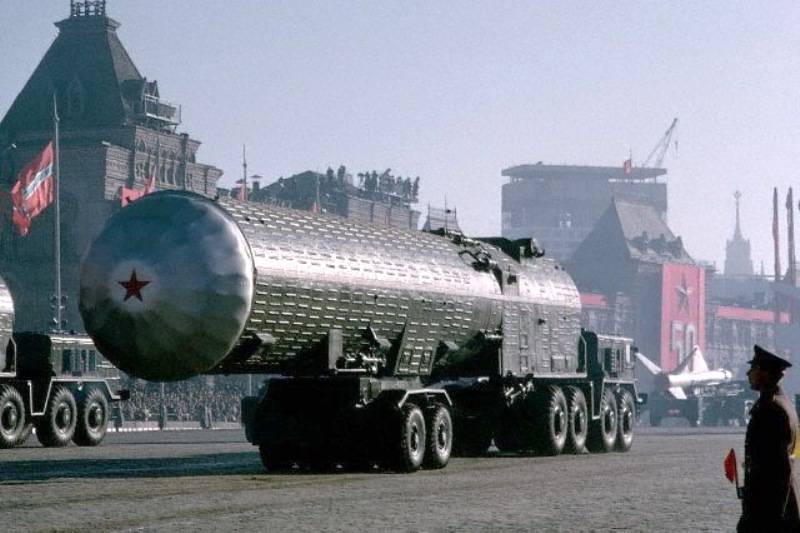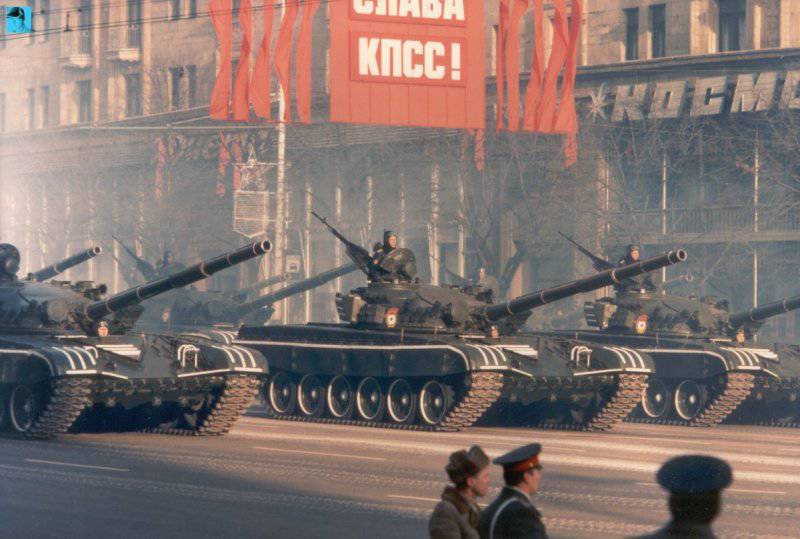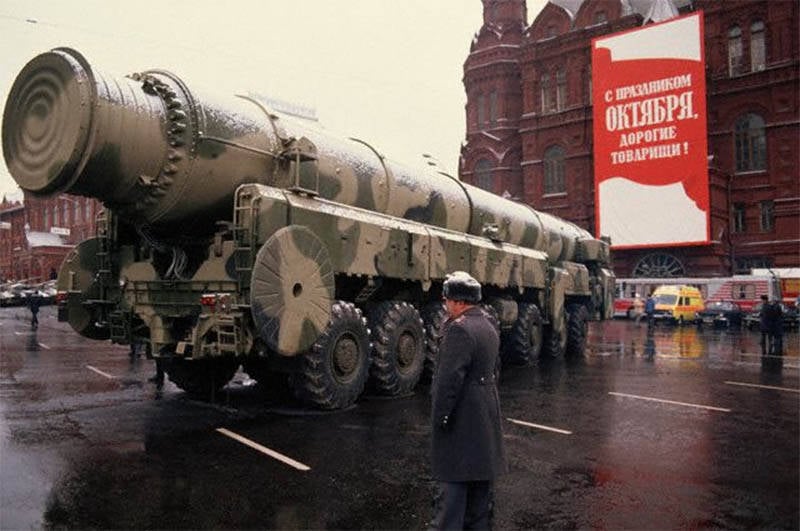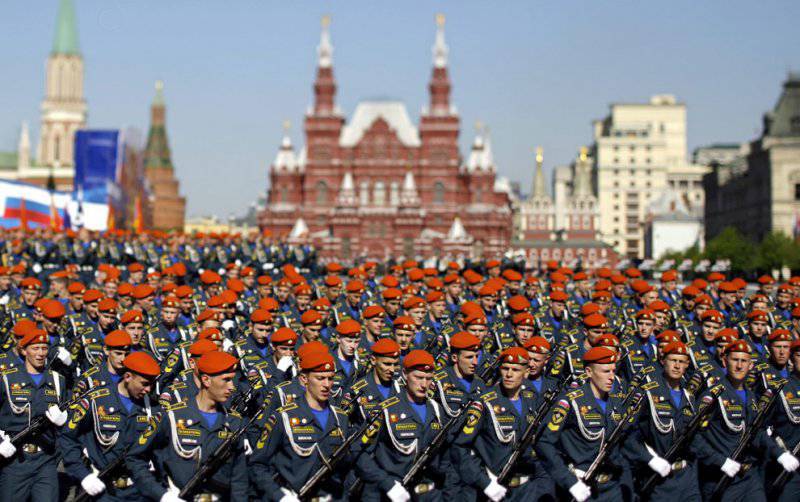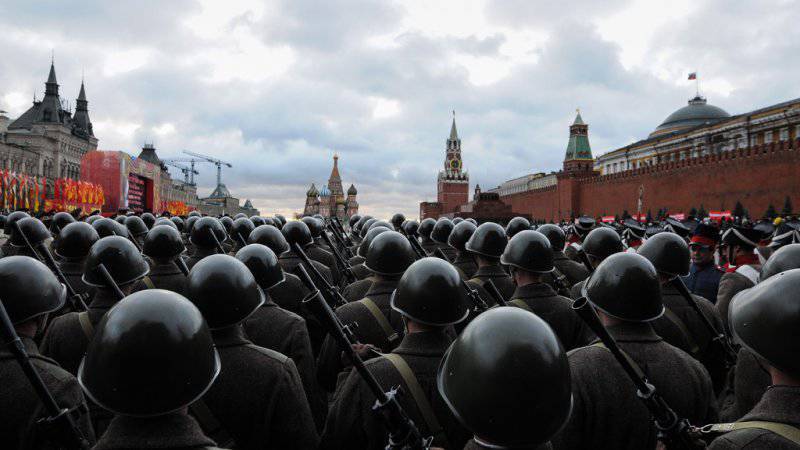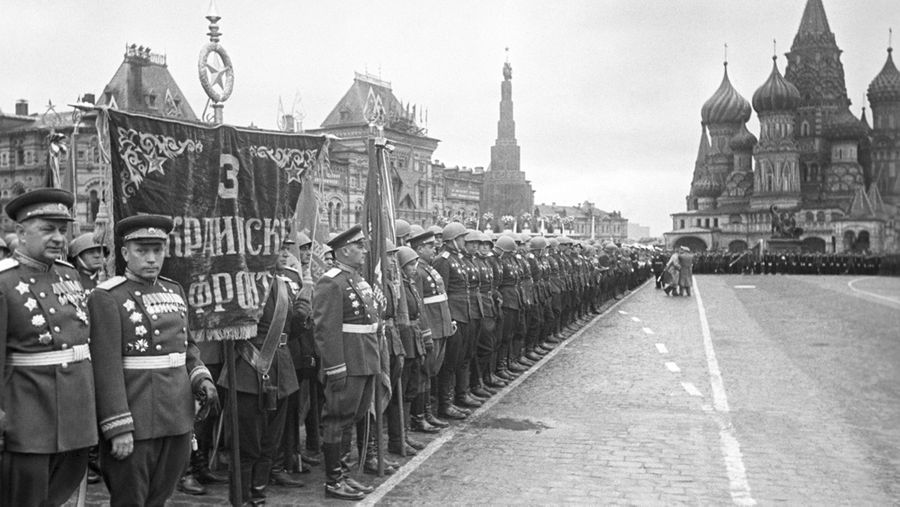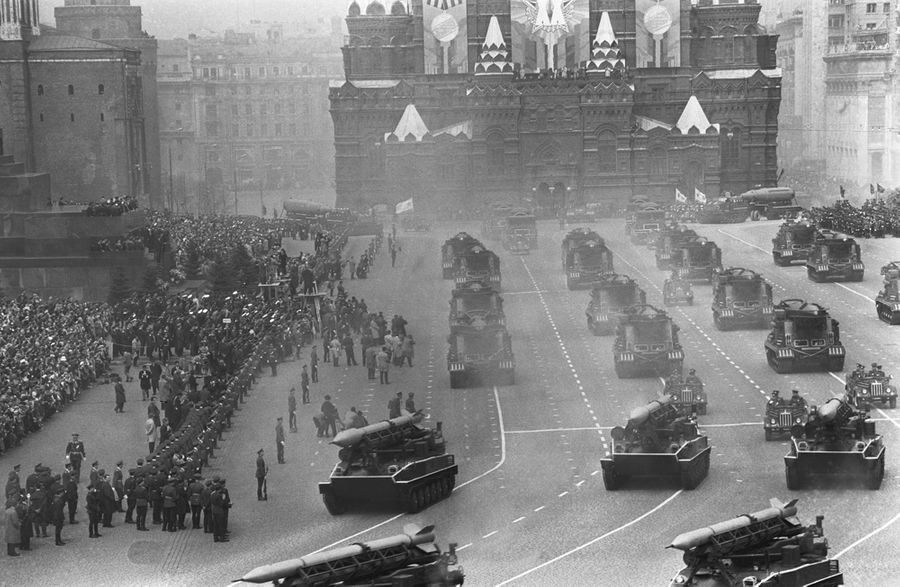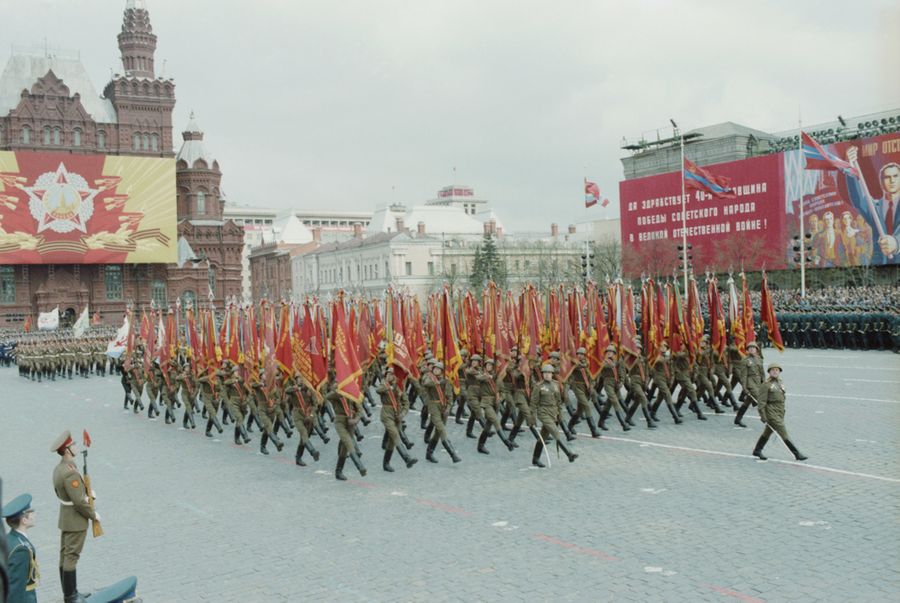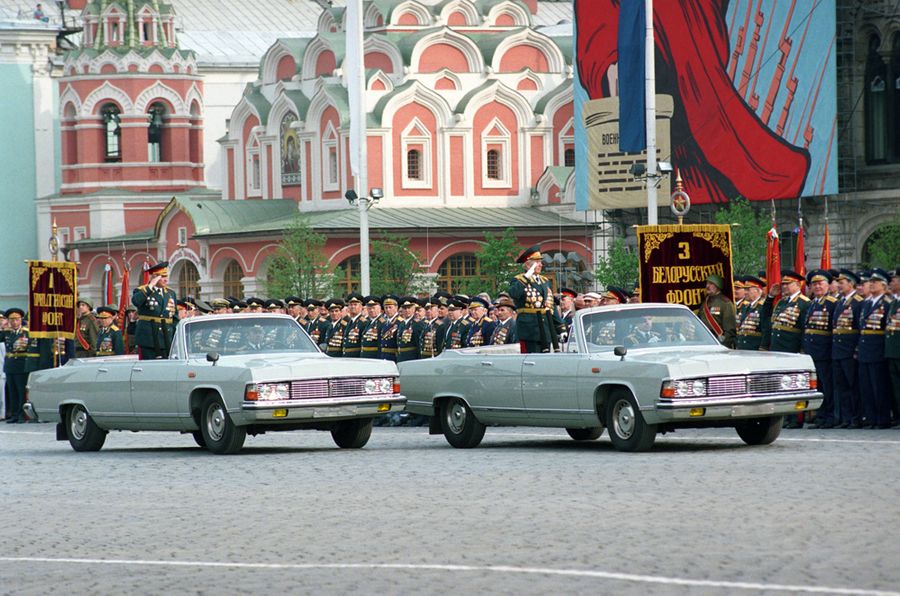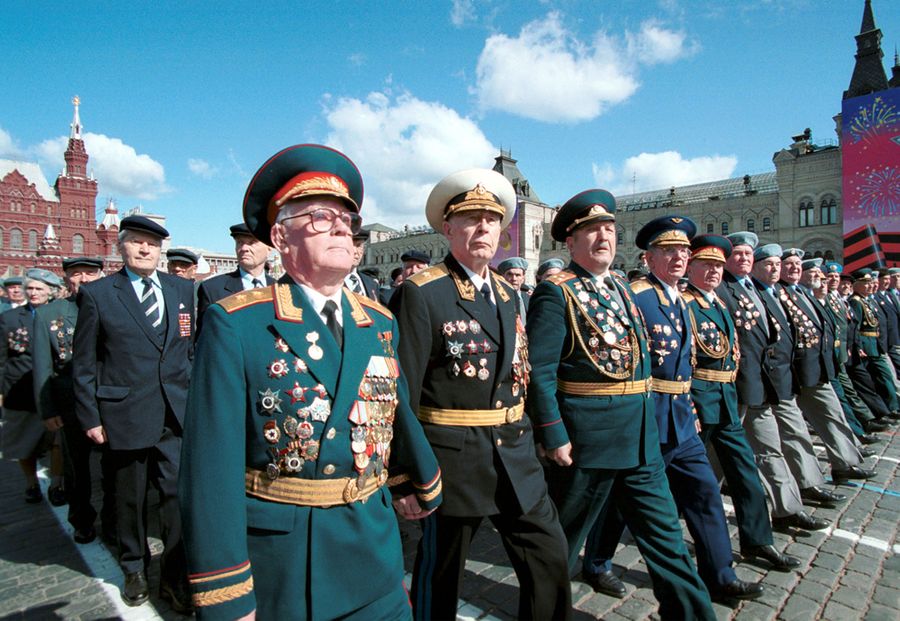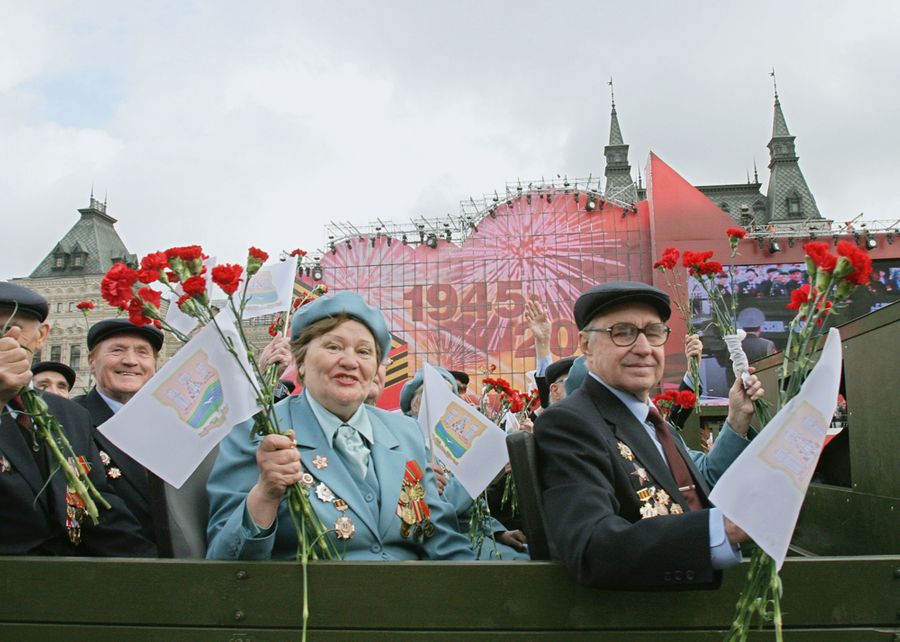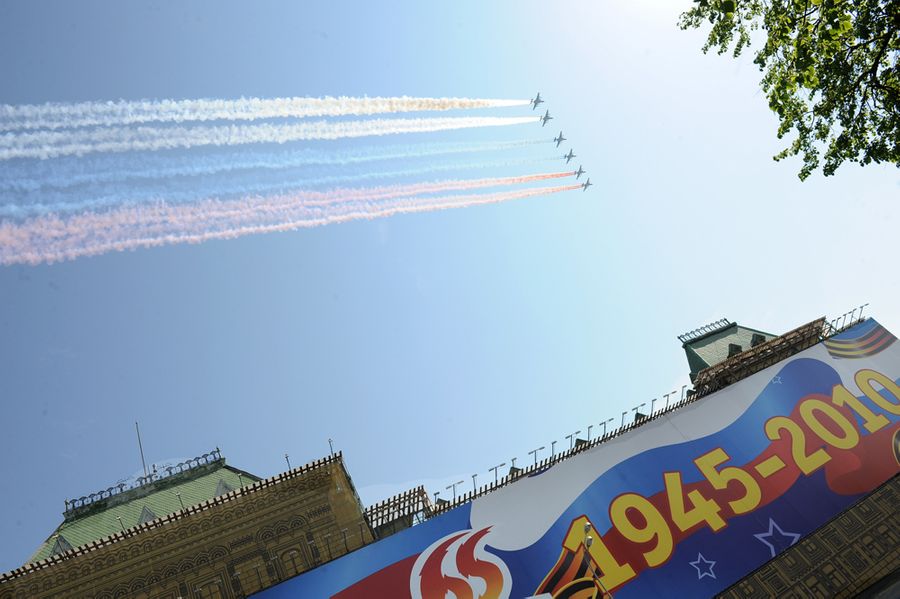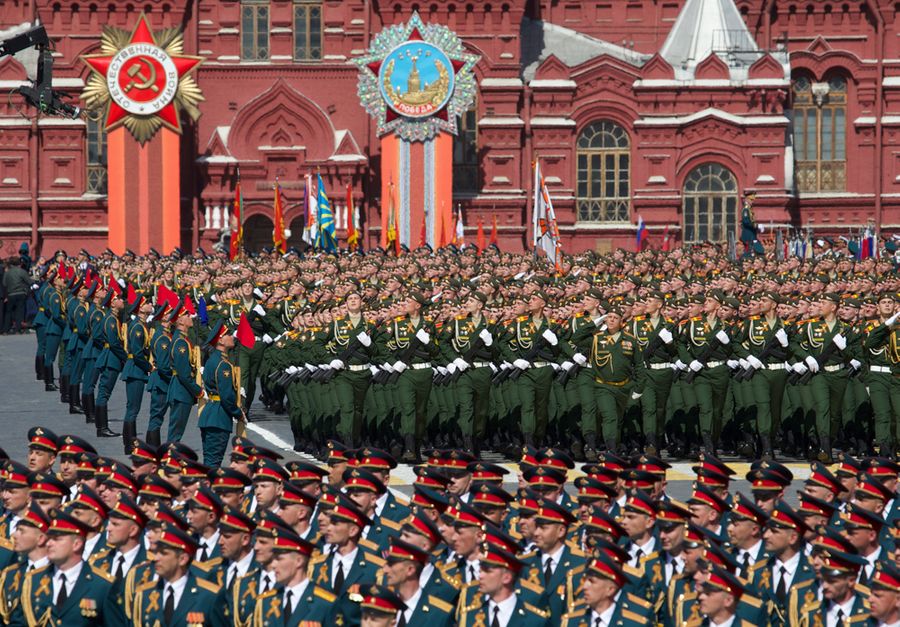Содержание
- 1 История 9 мая в СССР
- 2 Разные даты одного праздника
- 3 Традиции празднования
- 4 Парад Победы
- 5 Возложение цветов и минута молчания
- 6 Бессмертный полк
- 7 Георгиевская ленточка
- 8 Салют Победы
- 9 Празднование Дня Победы за рубежом
День Победы 9 мая – история праздника от его создания до наших дней. Чем запомнился первый День Победы, какие изменения произошли с тех пор. Какие традиции празднования Великой Победы остались сегодняшнего времени и что нового привнесло в этот праздник наше поколение.
Я помню! Я горжусь!
После победы Советского Союза во Второй Мировой войне, которая для нашего народа стала Великой Отечественной войной, День Победы 9 мая – самый желанный и в то же время самый неоднозначный праздник. Как поется в одноименной песне, «это праздник со слезами на глазах».
Иначе и быть не может. За четыре года войны советский народ лишился более 20 миллионов человек. И это только подтвержденные данные. Сейчас многие источники утверждают, что на самом деле погибших свыше 40 миллионов.
Нельзя сказать, что война осталась в далеком прошлом. До сих пор то тут, то там находят останки солдат, погибших на поле боя, оружие, осколки снарядов или даже неразорвавшиеся мины. Рана, нанесенная фашистскими захватчиками нашей стране, до сих пор кровоточит.
Как вся страна сплотилась на борьбу с неприятелем в те суровые годы, так и сейчас День Победы отмечается не как заурядный майский праздник. Для нашего народа это величайший праздник, имеющий много смыслов.
Это – день памяти павших. Это – почтение ныне живущим героям. Это – ликование освобожденного народа. Это – вечное напоминание молодым, какой ценой добывалась Великая Победа.
У него, как у всякого великого праздника, есть своя история и традиции.
История 9 мая в СССР
Празднование Дня Победы назначено в этот майский день не просто так. Именно 9 мая 1945 года немецко-фашистские войска полностью капитулировали.
Установка флага на крышу Рейхстага
В честь этого события 24 июня в Москве на Красной площади состоялся первый Парад Победы. Командовал парадом генерал Рокоссовский, а принимал его Георгий Жуков, незабвенный маршал Победы. Восседая на белом коне, он торжественно объехал почтительно замершие советские войска и доложил по всей форме Верховному главнокомандующему. Как известно, в то время армию, как и всю страну, возглавлял И.В. Сталин.
Участвовала в параде также боевая техника. Был представлен полный спектр боевых подразделений, ковавших победу на всех фронтах. В их числе:
- Т-34 – легендарный танк
- БМ-13 «Катюша» — получивший широкую известность гвардейский реактивный миномет
- Пушка ЗИС-3 – один из символов победы
- ГАЗ М-1 — «полуторки», известные фронтовые трудяги, были широко представлены в различных модификациях.
Закончился парад низвержением к подножию мавзолея В.И. Ленина фашистских штандартов. Эта почетная миссия досталась солдатам Дзержинского полка.
Понятно, что это был самый скоропалительный парад в истории России. Не удалось избежать технических сбоев и неувязок. В частности, не успели разработать новую форму для солдат и офицеров, а в полевой проводить парад не хотелось. Не было достаточного количества хорошей материи в стране, лежавшей в послевоенных руинах.
Поэтому форму разработали и пошили наспех из плохо прокрашенного материала. Как назло, во время парада пошел дождь, и фронтовики стоически терпели, стоя в цветных лужах, с потеками краски на лицах.
Вот так прошел первый парад, посвященной Великой Победе. Несмотря ни на что, это было первое празднование Дня Победы.
Интересно, что на протяжении многих лет, начиная с 1948 года, этот праздник не отмечался помпезными мероприятиями и даже не являлся «красным днем календаря». Он был памятным днем, но не выходным.
Официально День Победы стал праздничным днем в 1965 году. Тогда сошлись два знаменательных события – генсеком стал Л.И. Брежнев и, кроме того, год был юбилейным со дня победы в Великой отечественной войне.
Благодаря этому этот праздник возродился во всем его величии и стал таким, каким мы знаем его по сей день.
Разные даты одного праздника
Многие задаются вопросом, почему День Победы в России празднуют 9 мая, а в других странах – 8 мая. Есть две основные версии, объясняющие это расхождение.
Не всем известно, что до капитуляции Германии вначале был подписан предварительный протокол. Это событие имело место в ночь на 8 мая 1945 года в Реймсе в ставке Эйзенхауэра. Его подписывал с немецкой стороны фельдмаршал Йодль, с советской – генерал Суслопаров. Протокол гласил, что с 8 мая германская армия полностью прекращает боевые действия на всех фронтах. Сразу после этого американские и британские газеты поспешили раструбить о том, что германская армия капитулировала перед союзниками с указанной даты. Это – первая версия события.
Планировалось, что акт о капитуляции будет подписан там же. Однако Сталина не устроило такое положение дел. Его мнение заключалось в том, что настолько значимое событие в мировой истории должно быть, во-первых, официально обставлено и, во-вторых, состояться в столице поверженной фашистской Германии.
Таким образом, при участии представителей средств массовой информации, войск союзников и советских войск в Берлине ночью с 8 на 9 мая 1945 года был подписан Акт о безоговорочной капитуляции Германии. С немецкой стороны его подписал фельдмаршал Кейтель, с советской – маршал Г.К. Жуков. Церемония началась ровно в полночь 9 мая, а закончилась в 0.43.
Парадокс заключался в том, что указанное в акте время капитуляции – 8 мая 23.01 по берлинскому времени. Получается, что он был подписан «задним числом». Но, поскольку московское время опережает берлинское на один час, по нашему времени окончательная победа над фашистской Германией состоялась 9 мая.
А в Европе и многих зарубежных странах День Победы отмечают 8 числа.
Традиции празднования
На протяжении десятилетий День Победы, оставаясь великим праздником и символом подвига советского народа, подвергался изменениям. Точнее, что-то менялось, а что-то оставалось в неизменном виде как дань традициям.
Никогда не забывали в нашей стране и о ветеранах. Для них устраивают концерты, организуют праздничные чаепития, ветеранам посвящают стихотворения о войне. В честь Дня Победы в средствах массовой информации появляются фото с ветеранами, а дети рисуют для них картинки, посвященные войне и празднованию Дня Победы.
Одним из неизменно любимых символов праздника остается Парад Победы на Красной площади в Москве.
Парад Победы
БМ-13 «Катюша», Парад Победы 1945 год.
Однако парады на 9 мая проводились не всегда. После учреждения выходного дня и проведения парада 9 мая в 1965 году следующий прошел на Красной площади только в 1985 году. Этот год тоже был юбилейной датой Великой Победы. А вот после него очередной парад состоялся в 1990, затем в 1995 годах. Между ними День Победы отмечали другими мероприятиями, но без парадного прохода войск.
Традиционный ежегодный парад, каким мы его знаем, был возобновлен в 1996 году, а с проездом техники – с 2008 года. С тех пор ни одно празднование 9 мая не обходится без этого монументального события. Меняется только количество и состав боевой техники, демонстрируемой на Красной площади.
Традиционно парад Победы состоит из трех частей:
- Пешая часть
- Моторизованная часть
- Воздушная часть.
В пешей части принимают участие войска Московского гарнизона, слушатели военных академий, курсанты военных училищ, а также сводные полки ВМФ и воспитанники суворовских и нахимовских училищ. Они торжественным маршем проходят по Красной площади.
Моторизованная часть включает в себя проезд военной техники.
В нем участвуют более чем 100 единиц техники. Парадом проходит техника мотострелковых и танковых подразделений, подразделений ПВО, ракетных войск и артиллерии, воздушно-десантных войск, а также РВСН. Представлены новейшие образцы боевой техники и вооружения, включая модернизированные ракетные комплексы стратегического назначения «Тополь-М».
Воздушная часть представляет собой пролет боевой авиации над Красной площадью. В нем принимают участие более 70 летательных аппаратов. В их составе такие виды авиации, как:
- Стратегическая – самолеты Ту-160, Ту-95
- Фронтовая – бомбардировщики Су-24, Су-34
- Истребительная – самолеты Су-27, Су-30, Су-35
- Штурмовая — самолет Су-25
- Армейская – вертолеты Ми-24, Ми-17, Ми-8, Ми-27, Ка-50, Ка-52.
А какое зрелищное представление каждый раз дают пилоты самолетных групп «Стрижи» и «Русские витязи»!
На протяжении всего парада звучат строевые марши разных поколений и эпох, а также известные песни военных лет в инструментальном исполнении.
Парад Победы 1945 год.
Смотр боевой техники, Парад победы 1945 год.
Ветеран ВОВ
Возложение цветов и минута молчания
Праздничное утро обычно знаменуется скорбным шествием. Происходит официальное возложения цветов на самые известные мемориалы: Могилу неизвестного солдата у Вечного огня в Москве и к памятнику Родины-Матери на Пискаревском мемориальном кладбище в Санкт-Петербурге, где покоятся миллионы жертв блокады. В этом шествии принимают участие, как правило, первые лица государства.
В остальных городах тоже проходит возложение цветов. Каждый город возлагает цветы к памятникам своим героям, погибшим во время войны.
Отдельно стоит сказать о Минуте молчания. Объявляется она в 18 часов по московскому времени. На протяжении этой скорбной минуты в теле- и радиоэфире устанавливается тишина, чтобы люди по всей России могли почтить память павших.
Светлой памяти павших в борьбе против фашизма
Бессмертный полк
Как ни странно, акция, проходящая под одноименным названием и охватившая миллионы людей по всей стране и за рубежом, очень молода. Она ведет свою историю с 2007 года.
Тогда в г. Тюмень группа активистов одной из ветеранских организаций во главе с Геннадием Ивановым решила почтить память погибших предков. Они прошли с черно-белыми фотографиями своих родных по улицам города.
Акция была замечена и освещена в средствах массовой информации. В течение нескольких лет она проходила под разными названиями, пока не получила современное наименование в 2011 году в г. Томске. А в 2013 году народный артист Василий Лановой организовал этот марш памяти в Москве на Поклонной горе. Тогда в первый раз под его эгидой собрались более тысячи человек. Примечательно, что в 2014 году участников было уже более 40 тысяч, а в 2015 – свыше 500 тысяч.
С тех пор ни один День Победы не обходится без шествия Бессмертного полка. Как правило, оно стартует в разных городах в разное время, но с одинаковым энтузиазмом и единодушием среди населения. Многие страны присоединилась к этому движению. Принимают участие в акции и первые лица государства.
Она имеет огромное значение еще и потому, что время неумолимо. Как ни печально, но живых свидетелей тех страшных военных лет становится все меньше. В скором времени они исчезнут вовсе. Поэтому нам, их потомкам и продолжателям традиций, важно помнить их самих и их заслуги. А также сохранять ту незыблемую память поколений, которая зовется историей родной страны.
Георгиевская ленточка
Одним из основных символов Победы стала георгиевская ленточка. Символическое значение она получила в 1943 году вследствие учреждения Ордена Славы. Такая же лента была у медали «За победу над Германией».
Изначально это была орденская лента Георгиевского креста в царской России.
Георгиевские ленточки принято прикалывать к одежде с левой стороны – под сердцем. Также различные категории населения привязывают их к антеннам и зеркалам автомобилей, на сумки и рюкзаки. Украшены георгиевскими ленточками балконы, окна и двери квартир.
В качестве акции движение «Георгиевская ленточка» возникло в 2005 году силами РИА «Новости» и студентов-волонтеров. Цель ее состояла в том, чтобы вызвать у поколений, не знавших тягот и лишений военного времени, гордость за свой народ.
В наше время акция «Георгиевская ленточка» проходит по всей России. К ней подключились и предприятия торговли, а также культурно-массовые учреждения. Практически везде любой желающий может получить этот символ Победы совершенно бесплатно. Теперь эта акция называется «Я помню, я горжусь». Никто не должен забывать о своих героях.
Салют Победы
Завершающим штрихом великого праздника по сей день остается праздничный салют.
Самый первый салют состоялся еще во время войны в Москве, в ознаменование освобождения города Орел. Второй салют, не менее известный, был устроен в Ленинграде в 1944 году как символ полного снятия блокады с измученного города.
Теперь салют – неотъемлемая часть празднования Дня Победы. Он проходит во всех городах-героях нашей страны. Всего в России 9 городов, которым присвоено почетное звание города-героя.
Современные пиротехнические средства позволяют сделать этот символ праздника очень красочным и запоминающимся. Миллионы людей выходят на улицы, чтобы не пропустить это яркое зрелище. Повсюду видны радостные лица, слышны поздравления с Днем Победы. Этот праздник по-настоящему объединяет людей.
Празднование Дня Победы за рубежом
Как упоминалось выше, во многих странах День Победы отмечается 8 мая. Смысл самого праздника, как и сам процесс празднования, отличается от российского.
В качестве аналога российской георгиевской ленточки символом Победы в Европе является красный мак, изображение которого люди носят на одежде в День Победы. Этот цвет символизирует кровавые жертвы, принесенные на алтарь войны.
День Победы в США широко отмечается 2 сентября, в дату капитуляции Японии. А 8 мая в этой стране практически не празднуется, только ветераны возлагают венки к Мемориалу героям Второй мировой войны в Вашингтоне.
Особое значение имеет День Победы, отмечаемый 9 мая, для Израиля. Жители этой страны хорошо помнят ужасы этой войны и свято чтят память ее героев.
День Победы в Лондоне, 1945 год
День Победы — это не просто праздник отдельно взятой страны, это целая веха всемирной истории, положившая конец жестоким и неудержимым событиям, чуть было не ставшим причиной переворота всего мирового порядка.
В Советском Союзе смотр войск в честь разгрома нацистcкой Германии проходил всего четыре раза. Первый парад, состоявшийся 24 июня 1945 года, имел колоссальное значение для страны. Его принимал лично маршал Георгий Жуков. В современной России пешие и механизированные колонны ежегодно проходят по Красной площади с 9 мая 1995 года. Об истории, а также о традициях и нововведениях парада Победы — в материале RT.
9 мая в России пройдёт военный парад, посвящённый 74-й годовщине разгрома нацистской Германии. Этой традиции не так много лет. В СССР смотр войск в честь Дня Победы проводился только четыре раза — в 1945, 1965, 1985 и 1990 годах. Ежегодно парады 9 мая стали проводиться только с 1995 года.
В советское время, причём даже после окончания Великой Отечественной войны, смотр войск был привязан к социалистическим праздникам — Дню Октябрьской революции (7 ноября) и Дню труда (1 мая).
«Отсутствие регулярных парадов Победы в Советском Союзе неправильно объяснять пренебрежением к празднику или к подвигу армии и народа. Ничего подобного — хотя сейчас это и кажется странным. Скорее всего, сказывалась огромная нагрузка на организаторов парадов. Нарушать сложившиеся традиции по празднованию 7 Ноября и 1 Мая руководство страны не хотело, а проводить третий парад, да ещё и каждый год, было просто нереально», — пояснил RT полковник в отставке Михаил Ходарёнок.
«Нас муштровали, как новобранцев»
Первый Парад Победы состоялся 24 июня 1945 года на Красной площади. Решение о его проведении принял председатель Государственного комитета обороны Иосиф Сталин. Парад принимал маршал Георгий Жуков верхом на белом жеребце терской породы. Командующим смотром войск был назначен дважды Герой Советского Союза Константин Рокоссовский.
«Для участия в параде в городе Москве в честь победы над Германией выделить от фронта сводный полк… Сводному полку прибыть в Москву 10 июня 1945 года, имея при себе 36 боевых знамён наиболее отличившихся в боях соединений и частей фронта и все захваченные в боях знамёна противника независимо от их количества», — говорилось в директиве начальника Генерального штаба генерала армии Алексея Антонова от 24 мая 1945 года.
Также по теме
От Т-34 до «Арматы»: в Минобороны рассказали о технике на параде Победы в Москве
Минобороны России опубликовало программу проведения парада Победы 9 мая в Москве. Известно, что по Красной площади проедут танки Т-14…
Решение о проведении Парада Победы Иосиф Сталин принял 15 мая 1945 года. Верховный главнокомандующий настаивал на том, чтобы организовать парад в течение месяца — хотя Генштаб Рабоче-крестьянской Красной армии (РККА) просил выделить на подготовку смотра войск около двух месяцев.
Народному комиссариату обороны СССР требовалось провести гигантский объём работы. В первую очередь было необходимо отобрать военнослужащих для формирования парадных расчётов.
Главными кандидатами были отличившиеся в боях красноармейцы. Однако к ним предъявлялись жёсткие требования по строевой подготовке, возрасту и росту. Например, в приказе по войскам 1-го Белорусского фронта говорилось, что рост претендента на участие в параде не должен быть ниже 176 см, а возраст — не более 30 лет.
Строевая подготовка фронтовиков хромала: в условиях войны с Германией на коротких курсах не было времени чеканить парадный шаг. Так, из-за слабой выучки Жуков запретил выносить Знамя Победы сержантам Мелитону Кантарии и Михаилу Егорову, которые установили его на крыше Рейхстага.
Чтобы компенсировать нехватку опытных строевиков, наркомат обороны СССР был вынужден привлечь к участию в параде курсантов военных училищ и академий, а также военнослужащих Московского гарнизона.
- Специальная рота РККА готовится бросить вражеские знамёна к помостам на Красной площади
- © Министерство Обороны РФ
Для всех участников требовалось сшить парадную форму, и фабрики Москвы и Подмосковья справились с этой задачей. Уже 20 июня репетиции проходили в парадных мундирах.
В сжатые сроки были утверждены и изготовлены штандарты фронтов. К решению этой проблемы были привлечены сотрудники художественно-производственных мастерских Большого театра.
Десятикилограммовый штандарт состоял из древка с серебряным венком, золотой пятиконечной звезды и металлического штыря со шпилями на концах. Чтобы облегчить пронос тяжёлого штандарта, было решено установить древко в специально изготовленном кожаном стакане, который крепился к ремням, перекинутым через левое плечо знаменосца.
«Нас муштровали, как новобранцев, гимнастёрки не просыхали от пота. Но нам было по 20—25 лет, и огромная радость победы легко брала верх над усталостью. Занятия шли на пользу», — вспоминал кавалер двух орденов Славы Сергей Шипкин.
После прохода пеших колонн и до старта движения техники особая рота из 200 красноармейцев под аккомпанемент 80 барабанов бросила вражеские знамёна к двум деревянным помостам на Красной площади.
- Колонна самоходных артиллерийских установок на параде 24 июня 1945 года
- © Министерство Обороны РФ
Однако славная традиция проведения парадов в честь разгрома нацистской Германии не закрепилась в послевоенном СССР. Например, первое десятилетие Победы отмечалось народными гуляньями, торжественными собраниями и митингами, а 9 мая даже не было выходным днём. Ситуация несколько изменилась с приходом к власти фронтовика Леонида Брежнева.
26 апреля 1965 года Президиум Верховного Совета СССР объявил День Победы нерабочим днём. А в годовщину 20-летия разгрома нацистской Германии состоялся грандиозный военный парад. Знамя Победы (штурмовой флаг 150-й стрелковой дивизии) нёс участник штурма Рейхстага, Герой Советского Союза Константин Самсонов. По обе стороны от него шагали Кантария и Егоров.
Тем не менее традиция регулярного проведения парада Победы вновь не закрепилась. Ещё два смотра войск, посвящённых капитуляции вермахта, прошли в юбилейные 1985 и 1990 годы. Последний в истории Советского Союза парад принимал министр обороны СССР, герой Великой Отечественной войны маршал Дмитрий Язов.
Традиции и нововведения
Традиция ежегодного проведения парада Победы была учреждена первым президентом РФ Борисом Ельциным. 19 мая 1995 года он подписал Федеральный закон «Об увековечении победы советского народа в Великой Отечественной войне 1941—1945 годов».
Первый в Российской Федерации парад Победы прошёл в 1995 году в честь 50-летия разгрома нацистской Германии. В 1997 году глава государства ввёл новый обычай, отказавшись наблюдать за парадом с трибуны Мавзолея, как это делали советские лидеры.
Также по теме
Кузница воинской славы: почему гвардейские части остаются элитой российской армии
2 сентября Россия отмечает День гвардии. Это праздник всех солдат и офицеров, которые служат более чем в 100 гвардейских соединениях…
С тех пор формат проведения парада Победы практически не менялся. В начале смотра войск солдаты и офицеры почётного караула выносят Знамя Победы и флаг Российской Федерации (до 2006 года триколор не выносился). Затем собравшихся на Красной площади военнослужащих приветствует министр обороны.
После приветствия солдат и офицеров министр обороны докладывает президенту РФ о готовности войск к параду Победы. Глава государства выступает с небольшой речью, и под артиллерийские залпы звучит гимн России. Торжественное шествие войск начинается с прохода пеших колонн. Парадный расчёт состоит из 20 человек в шеренгу и десяти человек в глубину.
Как правило, по брусчатке чеканят шаг военнослужащие и курсанты военных вузов всех видов и родов Вооружённых сил РФ — Сухопутных войск, ВМФ (включая морских пехотинцев), ВКС, ВДВ, РВСН. Также торжественным маршем проходят пограничные войска ФСБ, подразделения Росгвардии (ранее — Внутренних войск МВД) и МЧС.
В последние годы по Красной площади также проходят юноши — участники движения «Юнармия». 9 мая 2016 года по брусчатке впервые прошагали женщины. Парадный расчёт представительниц прекрасного пола был сформирован из учащихся Военного университета Минобороны и Вольского военного института материального обеспечения.
- Женский парадный расчёт 9 мая 2016 года
- © Sergei Karpukhin/Reuters
Следом за пешими колоннами по Красной площади проезжает военная техника. Механизированную колонну возглавляет легендарный танк Т-34.
В нынешнем году по Красной площади проедут бронеавтомобили «Тигр», боевые машины пехоты «Курганец-25» и БМП-3, танки Т-14 и Т-72БЗ, машины поддержки танков «Терминатор», боевые машины десанта БМД-4М и бронетранспортёры БТР-МДМ, самоходные артиллерийские установки «Мста-С», пусковые установки ракетных комплексов «Искандер-М», «Ярс» и С-400.
Каждый год в плане парада значится воздушная часть, однако она не всегда проходит из-за погодных условий. 9 мая 2019 года в небе должны появиться 74 самолёта и вертолёта. Особый восторг у зрителей вызывает пролёт истребителей Су-35С, Су-30СМ, МиГ-29СМТ, а также стратегической авиации, представленной бомбардировщиками Ту-160, Ту-95МС, Ту-22М3. Парад завершается коротким выступлением оркестра перед трибуной, где находятся ветераны и президент.
«Своеобразный экзамен»
Организация парада возложена на Минобороны, а непосредственное руководство осуществляет командующий войсками Московского гарнизона.
По словам Михаила Ходарёнка, интенсивная подготовка к торжественному мероприятию начинается в декабре. Тогда проводится первое инструкторское методическое занятие на базе Московского высшего общевойскового командного училища.
Как отметил эксперт, организация парада Победы является очень трудоёмким занятием. Наиболее сложная его часть — это проход наземной техники. Репетиции движения колонн с февраля проходят на подмосковном полигоне Алабино.
«Парад Победы — это своеобразный экзамен и очень важное событие в жизни вооружённых сил. Проход войск по Красной площади на глазах у всей страны и мира должен проходить без сучка и задоринки. Например, по этой причине военные страхуются, всегда добавляя к парадному расчёту «запасных». Не может же пешая колонна пройти без одного или двух человек», — рассказал Ходарёнок.
- Расчёт танков Т-14 проезжает по Красной площади
- © Sergei Karpukhin/Reuters
Практически каждый парад Победы не обходится без небольших нововведений, которые, правда, не становятся традицией. Например, 9 мая 2010 года по Красной площади промаршировали подразделения стран — союзников СССР по борьбе с нацистской Германией — лётчики французской эскадрильи «Нормандия — Неман», военнослужащие Уэльского полка британской армии и 18-го пехотного полка США.
В 2014 году в параде Победы приняли участие кавалеристы Кремлёвского полка, а в 2015 году — кубанские казаки. В юбилейные годы смотр войск на Красной площади не обходится без военнослужащих в форме РККА.
Михаил Ходарёнок полагает, что в будущем Минобороны будет уделять больше внимания «исторической части» парада Победы. По его мнению, крайне важно, чтобы по Красной площади проходило больше техники времён Великой Отечественной войны, а над головами зрителей пролетали самолёты 1941—1945 годов. Однако, как отметил эксперт, боевые машины и авиатехнику придётся создавать с нуля.
«Парад Победы — это ещё и демонстрация силы нашим «уважаемым партнёрам», но, мне кажется, с течением времени мы придём к необходимости расширения его исторической «главы». На мой взгляд, парад должен состоять из трёх частей. Первая — проход Русской императорской армии (как прародительницы Великой Победы), вторая — колонн периода ВОВ, третья — современной техники. Эффект от этого зрелища превзойдёт все ожидания. Хотя и современный парад, безусловно, вызывает чувство гордости за нашу армию», — говорит Ходарёнок.
Иной точки зрения придерживается военный историк Борис Юлин. По его словам, нынешний формат парада Победы в достаточной степени символизирует связь поколений и демонстрирует современную боевую мощь российской армии.
«Никаких существенных изменений в организацию парада Победы вносить не стоит. По крайней мере, я не думаю, что есть смысл выносить этот вопрос на публичное обсуждение. Сам факт проведения парада 9 мая уже говорит о том, что потомки победителей чтят память о славных подвигах Красной армии и трудовом героизме советского народа. Есть такое очень точное выражение: хорош в строю, силён в бою. Каждый год Россия подтверждает его правильность», — подытожил Юлин.
| Victory Day Parades | |
|---|---|

Red Army soldiers holding captured German regiment standards, 1945 Moscow Victory Parade |
|
| Official name | Russian: Парад Победы Ukrainian: Парад Перемоги Belarusian: Парад Перамогі |
| Also called | Victory Parades |
| Observed by | Russia, Belarus, Ukraine, some former Soviet countries |
| Observances | Moscow, Minsk, Kyiv, Astana, other cities |
| Date | 9 May |
| Next time | 9 May 2023 |
| Frequency | annual |
Victory Day Parades (Russian: Парад Победы, tr. Parad Pobedy) are common military parades that are held on 9 May in some post-soviet nations, primarily Russia, Kazakhstan, Belarus, and formerly Ukraine. They are usually held to honor the traditional Victory Day holiday. In 2015, the Ukrainian government had renamed the holiday as «Victory Day over Nazism in World War II» as part of decommunization laws. However, even after the change, a vast amount of the populace still honors Ukrainian-Soviet troops who fought in World War II with traditional Victory Day celebrations.
Victory Parades as a holiday tradition[edit]
As Victory Day is the principal military holiday of Russia and of almost all member countries of the Commonwealth of Independent States, the celebrations in Moscow and other capital cities thus serve as national events to mark such an important holiday for millions of people, marking the anniversary of the capitulation of Nazi Germany in 1945. The annual or semiannual parades mark the Allied victory in World War II on the Eastern Front, on the same day as the signing of the German act of capitulation to the victorious Allies in Berlin, at midnight of May 9, 1945 (Soviet time), officially concluding the Second World War in Europe and northern parts of Africa.
During the entire history of the Soviet Union, only a total of four parades ever took place in Moscow and throughout the entire Soviet Union. In December 1947, the Presidium of the Supreme Soviet under Josef Stalin, decreed that May 9th (Victory Day) would become a working day, effectively making the celebrations cancelled and ceased completely.
However, on April 26, 1965, nearly twenty years after the first parade, under Leonid Brezhnev, the Presidium of the Supreme Soviet reversed the actions made in 1947, thus making May 9 a non-working holiday, this would be the first time Victory Day was made as an actual holiday. On May 9, 1965, the second Victory Day parade took place in Moscow, this Victory Day celebration also saw veterans obtain the first jubilee medal for «Twenty Years of Victory» in honor of the 20th anniversary since the Allied victory in Europe against Nazi Germany.[citation needed] Further parades would be held in 1985 and 1990.
Until 1989 celebrations of Victory Day were held in most Warsaw Pact countries (save for East Germany, whose celebrations fell on 8 May except in 1975, when it was marked on 9 May). Of all the countries that observed it, only Czechoslovakia held celebration parades every 5 years, also in honor of the successful Prague Uprising that ended on that day in 1945. In addition, Poland and Yugoslavia (which was outside the Iron Curtain) also held occasional parades, with the former staging a massive parade in 1985[1] to mark the ruby jubilee anniversary and the latter following the practice of Czechoslovakia of parades every 5th anniversary beginning with the 20th anniversary in 1965.
In 2020, many of the traditional parades were cancelled, with the only ones being held in Belarus and Turkmenistan. The main parade in Russia, as well as parades in Kazakhstan and Kyrgyzstan were cancelled as a result of the COVID-19 pandemic. In response to these massive cancellations, World Health Organization regional director for Europe Hans Kluge referred to these cancellations as «a brave decision», highlighting their holiday significance.[2]
Purpose[edit]
According to Russian anthropologist Sergey Ushakin, modern victory parades are intended to demonstrate the direct and immediate connection of the present with the past and to materialize the connection between generations.[3] General Oleg Salyukov, who has commanded the parade for close to a decade, described them in an interview with TASS as a «celebration for people, not show of militarism» referring to accusations of the parade being used as show of Russian military might.[4]
Parades in the Russian Federation[edit]
Victory Day Parade in Moscow 2008
Today, Russia, as the largest of the countries of the former Soviet Union, continues the practice of parades held in honor of the victory won in the Great Patriotic War — the Eastern Front of the Second World War as called by the Soviet Union. The first of these parades was held in 1995 (5 years after the fall of the Soviet Union) under the auspices of President Boris Yeltsin, who held the parade to commemorate the golden jubilee of the Soviet and allied victory in the war.[5] The parade was the only one to date that had to be divided into two parts (a full military parade on Poklonnaya Hill and a veterans ceremony on Red Square).
Red Square, Moscow[edit]
The most important parade of those being held on May 9 is the one held on Moscow’s Red Square, with the President of Russia as the guest of honor and keynote speaker in virtue of his constitutional mandate as Supreme Commander of the Russian Armed Forces. On the morning of the day, an estimated 14,000 military personnel, including a regiment of female cadets and youth cadets, assemble by battalions on the square together with the Massed Bands of around 1,100 bandsmen under the direction of the Senior Director of Music of the Military Band Service of the Armed Forces of Russia (an appointment bestowed to either a colonel or a general rank officer), together with more than 210 vehicles and 3,800 vehicle crews assembled on Tverskaya Street just north of the Manezhnaya Square, Moscow, during the major parades a battalion or company of historical Red Army vehicles, estimated at around 36 vehicles and composed of just the T-34, GAZ-67 and the SU-100 plus the optional BM-13N (or at around an estimated 480 when counting other vehicles of the war which would take part just like in the parades of 1985 and 1990) assemble on the street as well with modern military hardware of the Armed Forces and the National Guard (and optionally by the other uniformed organizations). At the airbases outside Moscow (in areas like Kubinka), more than 88 aircraft are assembled with their aircrews for the flypast segment. Each of the contingents, since 1996, carry historical military colors of the 1942 (Red Army, Soviet Air Force, People’s Militia) and 1932–1944 (Navy) patterns at the head of their formations honoring the millions of men and women who served in the ranks of the military and law enforcement services of the former Soviet Union during the long period of the Eastern Front of the Second World War, and the millions among them who were either killed or were missing in action.
The celebrations begin at 9:55 am Moscow Standard Time with the arrival of the President and the Prime Minister of Russia to a special grandstand in front of Lenin’s Mausoleum, where six of the past parades were reviewed by national leaders. They greet the Chief of the General Staff of the Armed Forces, service commanders, deputy ministers in the Ministry of Defence and commanders of the support units within the Armed Forces, together with veterans, veterans’ families and representatives of the Suvorov and Nakhimov Schools assembled. To the left and right of the grandstand are the stands wherein veterans, veterans’ families, and descendants and families of personnel killed in action are gathered. In between the grandstand to the south of the stands are two platoons of armed linemen and markers from the 154th Preobrazhensky Independent Commandant’s Regiment in the Imperial-styled military uniforms and some unarmed half-companies of the Kremlin Regiment, both of which would be later taking post to mark the distance of the troops marching past and to line the square’s western side facing the Kremlin together with extra drum majors from the Band Service, which are there to coordinate the march past to be timed in with the music of the bands since the parade of 1995. At the square, the parade commander (usually a Colonel-General or rarely a General of the Army with the billet of Commander of the Ground Forces or as the Deputy Chief of General Staff) takes his place in a special an Aurus Senat armored limousine (formerly a Zil until 2018), having just received the report on the readiness of the parade from the commandant of the Combined Arms Academy who is a general officer.
As the Spasskaya Tower of the Kremlin sounds the chimes at 10 am the parade commander orders the parade to present arms as the 154th PICR’s 1st Honor Guard Company Colour Guard, to the melody of The Sacred War being played by the Massed Bands, marches into the square and past the dignitaries with guard carrying both the Flag of Russia and the Victory Banner. As the colour guards approach the grandstand, the colour officers execute eyes left and resume above face after passing by. This is followed by the parade being commanded to stand at ease after the colours take their place at the northwest end of the square fronting the State Historical Museum, besides the colour of the Armed Forces. Then the Minister of Defence (usually a billet of a General of the Army) is driven on the limousine to the center of the square nearest the tribune, the parade presenting arms again at this point. The parade commander informs him of the readiness of the parade to be inspected. The report is received, and to the tune of the Massed Bands, the Minister and the parade commander are driven to inspect the parading contingents each together with the bands. As the limousines stop the Minister sends Victory Day greetings to each of the parading contingents, in which they respond with a threefold loud Oorah that is heard all over the grounds. After the final greeting, the Massed Bands strike up to Slavsya from A Life for the Tsar as the PC returns to his place, the Minister driven to the grandstand amidst loud shouts of Oorah by the parade contingents where he dismounts the limousine and the Corps of Drums of the Moscow Military Music College, an affiliate of the Suvorov Military Schools, take their place behind the parade commander’s car led by the Commandant of the college and the college colour guard. The parade is ordered to stand at ease after the Minister informs the President that the parade is formed up for the march past in review and its inspection officially completed. In 1965, 1985 and 1990 parades, the limousines would inspect the personnel of the mobile column at the Manezhnaya Square formed into battalions, in remembrance of the mounted inspection of the original 1945 parade, which included cavalry, tachankas and horse artillery in addition to the huge mobile column. Following the report of the Minister of Defence, the keynote holiday address to the nation of the President follows, preceded by a fanfare by the Massed Bands, usually Govovin’s Moscow Fanfare. A moment of silence, since 2014, features as part of the keynote address.
As the president finishes the address and a threefold Oorah resounds all over the square by the entire parade assembled and the honor guard presents arms, the Massed Bands play the National Anthem of Russia and a ceremonial battery armed with the 76 mm divisional gun M1942 (ZiS-3) fire a 21-gun salute. As the anthem ends, the bands sound Retreat as the honor guard executes order arms and the parade commander orders the parade to commence the march past in the following manner:
-
- Parade… attention! Ceremonial march past!
Form battalions! Distance by a single lineman! First battalion will remain in the right, remainder… left.. turn!
Slope.. arms!
- Parade… attention! Ceremonial march past!
As the command is given to start the linemen take their places and the field markers also as well at the south end of the square. As the PC ends the commands with Eyes to the right, forward, quick march! the Corps of Drums of the Moscow Military Music College, as is their tradition since 1938, march first to the tune of the «General Miloradovich» by one of its late alumni, Lieutenant General Valery Khalilov, one of the longest-serving Senior Directors of Music of the Military Band Service and conductor of the Moscow area massed bands from 2002 to 2016, being played by the drummers and fifers. As the massed bands start playing the Corps of Drums stop playing by the signal of the Corps Drum Major and swings its drumsticks while on the eyes right. The Corps is followed by the colour guard of the 154th PICR and its 1st Honor Guard Company, during jubilee parades, the colour guard is followed by a company of colour bearers carrying the front standards in the order of their marchpast in the 1945 Victory Parade and their escorts, colours from the regiments, brigades, and divisions which took part in the original 1945 parade and a historical unit of servicemen in period uniforms, optionally joined by the Kuban Cossacks, in memory of their contingent which marched past on that very parade, and the Escort Cavalry Squadron of the Kremlin Regiment plus a number of international contingents. This is followed by the rest of the parade ground column, starting with the youth contingents and by the Combined Arms Academy, among other troops.
Once the ground column ends, the bands stop playing and, to give way to the mobile column by marching towards the facade of the GUM department store. The mobile column starts with the drive past of historical vehicles in jubilee years and only a T-34/85 medium battle tank carrying the Victory Banner non-special anniversary years. Following the end of the mobile column with the service flags of the three branches of the Armed Forces, the flypast then follows, usually as the Bands play the Aviamarch and other air marches. The flypast marks the formal end the parade.[citation needed]
Russian parades held outside Moscow[edit]
The massed bands of the St. Petersburg Garrison during the parade in 2016
A parade at the Khmeimim Air Base in 2018.
As per tradition, 27 other Russian major cities (Sevastopol and Kerch in the disputed Crimea included) are expected to hold commemorative parades on that day (some of them including flypasts and fleet reviews during jubilee years), and joint civil-military parades are hosted by 50 other towns and cities nationwide. Many of these parades are modeled primarily on the Moscow parade, which is the national parade and the highlight of the celebrations, with the local area military unit commander as the parade reviewing officer and the unit executive officer as the parade commander. Military bands are drawn from the local area military unit or educational institutions.
The following plazas in cities outside of Moscow hold military parades:
- Palace Square (St. Petersburg)
- Soviet Square (Smolensk)
- Victory Square (Tula)
- Victory Square (Kaliningrad)
- Lenin Square (Voronezh)
- Minin and Pozharsky Square (Nizhny Novgorod)
- Five Corners (Murmansk)
- Primorskoy Square (Severomorsk)
- 1905 Square (Yekaterinburg)
- Millennium Square (Kazan)
- Lenin Square (Novosibirsk)
- Kuybyshev Square (Samara)
- Theatre Square (Rostov-on-Don)
- Square of Fallen Fighters (Volgograd)
- Lenin Square (Novorossiysk)
- Freedom Square (Vladikavkaz)
- Lenin Square (Astrakhan)
- Lenin Square (Stavropol)
- Admiral Pavel Nakhimov Square (Sevastopol)
- Lenin Square (Kerch)
- Lenin Square (Simferopol)
- Platov Square (Novocherkassk)
- Lenin Square (Khabarovsk)
- Ship Embankment (Vladivostok)
- Central Square (Ussuriysk)
- Central Square (Belogorsk)
- Lenin Square (Chita)
- Council Square (Ulan-Ude)
- Glory Square (Yuzhno-Sakhalinsk)
Like Moscow, regional parades in recent years have included foreign troops in their parades. On the 65th anniversary in 2010, French troops took part in a parade in Murmansk while American sailors paraded in Vladivostok.[6][7][8] This occurred once again in 2013 in Vladivostok during which American Pacific Fleet troops and sailors from the French Navy took part in the 68th anniversary parade, greeting the parade inspector in their native languages before sounding a Russian-style threefold «Ura!»[8] Foreign cadet contingents also take part in the parade in St. Petersburg and Omsk. In 2020, it was confirmed that foreign servicemen from the armed forces of Kazakhstan, Kyrgyzstan, Tajikistan and Uzbekistan will take part in the parade in Yekaterinburg,[9] as well an 80-man contingent from Armenia in Rostov-on-Don,[10][11] plans which were later scrapped. In Ulan-Ude in 2021, a contingent of the Mongolian Armed Forces took part in the parade for the first time.[12][13]
Palace Square, St. Petersburg[edit]
The first Victory parade in the city was the Parade of Guards (Russian: Парад гвардейских войск) on 8 July 1945 was held in then Leningrad in the presence of at least half a million Leningraders. The parade consisted of servicemen from guards units of the Leningrad Front, all of which marched on Nevsky Prospect.[14] On 9 May 1965, the first parade celebration of the 20th anniversary of the victory took place on the Palace Square grounds.[15]
In 2019, Soviet era unit colours were flown in the lead vehicles of the units composing the mobile column in the St. Petersburg parade honoring the Second World War service of these formations, including battle honours won for service during the Siege of Leningrad (1941-1944). This tradition would be carried on in the coming years.
Beginning in 2001, the National Anthem has been sung, in all its three verses, with the choral accompaniment of the singers of the Song and Dance Ensemble of the Western Military District.
Ship Embankment, Vladivostok[edit]
Victory Parades in Vladivostok first began in 1965. Despite this it is generally considered that the first parade in honor of the victory in Vladivostok on Svetlanskaya Street took place in 1918 dedicated to the First World War, attended by British, American and French troops. Svetlanskaya later went on to host ten victory parades, held infrequently. The traditional part of parade was reduced to the construction of areas of the central square, which resulted in parades, such as one in 2009, being held under the monument to the Red Army soldier. In 2011, the victory parade in Vladivostok moved from the central square to Ship Embankment, which was a controversial move that caused debate. Since 2012, official Victory Parades have been held annually on the street.[16]
Lenin Square, Khabarovsk[edit]
The parade in the city of Khabarovsk is the main one in the Eastern Military District. In 2019, the American M4 Sherman medium tank, one of the many Lend-Lease Sherman tanks supplied to the Soviet Union by the United States military industry, took part in the mobile column of the parade for the first time, after over a year of restoration work after being found by divers at the bottom of the Barents Sea. This was unprecedented, as this was the first time in years that a Lend-Lease vehicle used by the Soviet Army drove past on a regional parade in the city.[17]
1905 Square, Yekaterinburg[edit]
Unlike other cities, parades in Yekaterinburg (known in the Soviet era as Sverdlovsk) weren’t held until 1975, a year when the parade in Moscow wasn’t event being held despite it being a jubilee year. Another parade was held on 1905 Square in 1980. Parades returned in 1992, after the merger/creation of the Volga–Ural Military District caused large-scale parades in the region to be moved to Samara. In 2005, Yekaterinburg was one of three cities in Russia (along with Moscow and Krasnoyarsk), where heavy military equipment directly took part in the parade. The record number of military equipment participating in the parade was recorded in 2010. In 2015, aircraft were first introduced into the parade.[18]
Lenin Square, Novorossiysk[edit]
The 2021 parade in Novosibirsk was the first ever regional parade since 1990 that featured the Strategic Missile Forces’ RS-24 Yars mobile ICBM system from the city-based 39th Guards Rocket Division, the first time in years that ICBMs made their appearance at the end of the mobile column segment of the parade in the city and an unprecedented decision by the parade organizers. In the past, there have been surface to surface tactical missile units in many of the regional parades, which have been retained in some cities, but not the ICBMs, which only appeared in the Moscow parade of 1965.
Kazan Kremlin[edit]
The principal parade of Tatarstan, beginning 2012, has been held on the grounds of Kazan Millenium Square, outside the iconic Kazan Kremlin, a UNESCO World Heritage Site, and at the front of Kazan Arena.
Crimea[edit]
Parades held in the Russian Republic of Crimea are spread across three cities: Sevastopol, Simferopol and Kerch. The first large-scale procession took place in 1960 at the city stadium in Simferopol. Since the 90s, the most grandiose parades, were held in Sevastopol, a Hero City. For a number of years, a joint parade of the Russian Black Sea Fleet and the Ukrainian Navy took place in the city, featuring both Ukrainian and Rusisan parade commanders and inspectors.[19]
The parade in Sevastopol.
Since the 2014 Annexation of Crimea by the Russian Federation, parades have been solely held by Russia, with the first parade in May of that year commemorating the 70th anniversary of its liberation.[20][21] President Vladimir Putin also visited the city to attend a fleet review after reviewing the parade in Moscow that day.[22]
Russian parades outside the country[edit]
The following bases in foreign countries hold military parades:
Tajikistan — Russian 201st Military Base
During the annual parade at Khmeimim Air Base in Syria, a unit from the Syrian Arab Armed Forces usually participates in the parade.[23]
Incidents[edit]
In 2004, during a victory parade in the Chechen city of Grozny, a bomb exploded, killing 10 people including the Chechen President Akhmad Kadyrov.
History of parades in different countries[edit]
Parades held in recognized nations[edit]
Republic of Armenia  [edit]
[edit]
Annual victory day parades in Armenia are held in Gyumri on the central square of the city, being presided by the Commander-in-Chief of the United Group of Forces and taking place with the participation of troops from the Russian 102nd Military Base, the Leninakan Border Detachment of the Federal Security Service of Russia, and military personnel of the Armed Forces of Armenia. The first one took place in 2014, after having not been held since 1993.[24][25] Officials in attendance are the Governor of the Shirak Region, the Mayor of Gyumri, and the Bishop of the Diocese of Shirak.[26] In 2015, pilots of the Russian airbase in Armenia participated in a flypast over Gyrumi and Yerevan for the first time in honor of the platinum jubilee.[27] Because the 2020 celebrations in honor of the holiday and Shushi Liberation Day were cancelled by order of Prime Minister Nikol Pashinyan due to the COVID-19 pandemic, a fly past of the Armenian Air Force was held at the Mother Armenia monument.[28][29]
Republic of Belarus  [edit]
[edit]
Victory parades in Belarus have dated back to Soviet parades in the former Belarusian Soviet Socialist Republic. They are usually held on jubilee years (e.g. 50th anniversary, 65th anniversary).[30]
Czechoslovakia  [edit]
[edit]
A parade of tanks of the ČSLA in Prague on Victory Day, 9 May 1985.
During the period of the Czechoslovak Socialist Republic, regular victory day parades were held by the Czechoslovak People’s Army (ČSLA) in Letná. The first parade took place in 1951 and have since been held every five years on 9 May up until 1990. The parade also marked the Prague uprising. The last of these parades took place in 1985.[31][32] Kde domov můj & Nad Tatrou sa blýska (the Czechoslovakian national anthem) was performed by the massed bands on parade before being followed by the State Anthem of the Soviet Union. Parades were also held in Bratislava and Pilsen as well.
State of Israel  [edit]
[edit]
Israel has commemorated Victory Day since it became a national holiday in 2017. As a result of the mass immigration of many Red Army veterans, Israel now hosts the largest and most extensive Victory Day celebrations outside the former Soviet space. The traditions and customs of Victory Day are the same as in Russia, with marches of Immortal Regiments held in cities with large populations of Red Army veterans and their descendants, particularly in Tel Aviv, Jerusalem and Haifa. It does not just honor all who served in the European and Mediterranean Theaters, but also particularly honors the Jewish partisans and soldiers who served in the armed forces and paramilitary formations, as well as of the civil uniformed security forces, of the Allies, whose experience would help in the formation of the current day Israel Defense Forces.
Republic of Kazakhstan  [edit]
[edit]
A T-72 tank during a Victory Day parade in 2015.
The first Victory Day Parade in Kazakhstan was held in 1995 in the then capital of Almaty. Celebrating the golden jubilee of the victory, it was held on Republic Square and was presided by the Minister of Defence, Army General Sagadat Nurmagambetov.[33] Subsequent small-scale parades were held in 2000[34] and 2005.[35] In 2015, a Victory Day/Defender of the Fatherland Day Parade was held on Independence Square in Nur-Sultan (then known as Astana) to celebrate the victory’s platinum jubilee.[36] As a result, most Victory Day parades are held in connection with Defender of the Fatherland Day holiday, which celebrates the founding of the Kazakh Armed Forces. In the wake of the Coronavirus outbreak in March 2020, President Kassym-Jomart Tokayev ordered the cancellation of that year’s parade due to the ongoing COVID-19 pandemic that affected the country.[37][38][39] On 24 June of that year, the city of Almaty held a mini Victory Parade.[40]
In Aktau, the parade traditionally begins with the «Volley of Remembrance», fired near the Eternal Flame monument.[41]
Kyrgyz Republic[edit]
The only major Victory Day Parade in Bishkek occurred in 2015 on Ala-Too Square. It was presided by Prime Minister Temir Sariyev and Chief of General Staff Asanbek Alymkozhoev[42] in place of President Almazbek Atambayev, who was attending the 2015 Moscow Victory Day Parade.[43] Russian troops from the Kant Air Base also took part in the parade.[44][45] In 2020, a planned parade due to be held at the same venue to mark the war’s 75th anniversary was cancelled.[46][47] On normal occasions, a short victory parade led by the Commander of the Bishkek Garrison is held at Victory Square.[48]
Parades have also been held in Osh, with notable attendees including First Deputy Prime Minister Mukhammedkalyi Abylgaziev.[49]
Republic of Moldova[edit]
On 15 April 2020, Moldovan President Igor Dodon ordered the postponement of the diamond jubilee Victory Day celebrations on 9 May, the main event of which was supposed to be the Victory Parade on Great National Assembly Square, to Liberation Day (24 August) due to the coronavirus pandemic in Moldova, marking also the 76th anniversary of national liberation in the Second Jassy–Kishinev Offensive of 1944.[50][51] It was expected also to mark the 29th anniversary of Moldovan independence, thus the parade was supposed to be a triple anniversary event and a prelude to the massive celebrations held in 2021 in honor of the country’s 30th year of nationhood. The plans for the parade were cancelled in later July by order of the president due to the state mandated quarantine.[52]
Victory parades also took place in the Soviet era.[53]
Serbia  /Yugoslavia
/Yugoslavia  [edit]
[edit]
Victory Day Parades in Serbia and the former Yugoslavia are held frequently, the first of which was held by the Yugoslav People’s Army on Bulevar revolucije in 1965, during the 20th anniversary.[54] After that parade, it was held every 5 years. The last victory parade in the Socialist Federal Republic of Yugoslavia was held on the ruby jubilee in 1985 (branded as Parade 85). On 10 May 2019, the first Victory Day Parade of the Serbian Armed Forces in close to 35 years was held in the city of Niš (branded as «The Defence of Freedom»).[55][56][57][58]
Republic of Tajikistan  [edit]
[edit]
Victory Day parades of the 201st Motor Rifle Division in the Tajik SSR were held on Dousti Square in the capital of Dushanbe in 1965 and 1985.[59] Parades are also held annually in Victory Park.
Turkmenistan  [edit]
[edit]
In 2020, the 75th anniversary of the victory in the war was celebrated with a military parade and festive celebrations.[60][61] This was the first ever Victory Parade to be held since Turkmen independence was attained.[62][63][64][65] Soldiers of the Armed Forces of Turkmenistan took part in the parade,[66] which was held at a square in front of the Halk Hakydasy Memorial Complex in the capital of Ashgabat, with a special appearance by Russian Deputy Minister of Defence Alexander Fomin.[67][68] The parade featured a procession of various historical artifacts, including the banner of the 748th Infantry Regiment of the 206th Rifle Division of the 2nd Ukrainian Front (which was brought into the capital from Moscow)[69][70][71] as well as the GAZ-M20 Pobeda parade car and battle vehicles from that era. The parade was held in spite of the coronavirus pandemic in the country and was one of two parades being held that year in the former Soviet Union, with the other being in Minsk.[72]
Ukraine  [edit]
[edit]
Victory Day Parade in Kyiv in 2010
Ukraine, as the second-largest former Soviet republic in terms of population, used to have some of the largest and most frequent victory parades. The first official proposal to celebrate Victory Day with a parade appeared at a meeting of the Central Committee of the Communist Party of Ukraine on 27 March 1945. The first military parade since the liberation of Kyiv was held on International Workers Day (1 May), being dubbed in the local media as a «Victory Parade». The parade took place on Korolenko Street (now Vladimirskaya).[73] During the latter half of the Ukrainian SSR’s existence, parades were held in 1965 and 1990, with the planned 1985 parade being cancelled.[74][75]
After independence in 1991, the first parade was held in 1995[76] to celebrate the golden jubilee, and was held again in 2001, 2010, and 2011 until the last formal parade took place in 2013.[77] Parades have also been held on a regular basis in the cities of Odessa, Kharkiv, and Lviv, usually taking the form of a small march past nowadays rather than a full ceremony. From 2010 to 2013[78] Kharkiv’s Freedom Square hosted an annual parade with the participation of the troops of the Kharkiv Garrison, military academies located in Kharkiv and troops from Russia.
The planned parade was cancelled for the first time in 2014 by order of the Kyiv City State Administration in light of the start Russo-Ukrainian War and the holiday’s Russian connotations.[79]
Although Victory Day as a holiday has been altered completely and was recreated as a completely different national holiday following the events of the 2013-14 Euromaidan (known today as the Victory Day over Nazism in World War II), many Ukrainians still honor veterans in the traditional Victory Day style in terms of protocol.[according to whom?] Only in the separatist-controlled parts of Donetsk and Luhansk oblasts, since 2015, do the people completely celebrate the traditional Victory Day parades with military vehicles and soldiers marching past the main squares of the two cities, which are televised events and are also livestreamed online.[citation needed]
Uzbekistan  [edit]
[edit]
In 2018, a Victory Parade of the Tashkent Military District was held on its training ground in Chirchik on the occasion of Day of Remembrance and Honour.[citation needed] Parades have also been held in Samarkand.[80]
Parades held in partly recognized states[edit]
Republic of Abkhazia  [edit]
[edit]
Victory parades have been held in Abkhazia annually since 2009. This should not be confused with the Victory parade on 30 September in Sukhumi on Independence Day. These parades are usually held at the Dioskurov Embankment in the capital.[citation needed]
Republic of South Ossetia – the State of Alania  [edit]
[edit]
Victory Day in Tshkinvali 2018.
Like its neighbor Abkhazia, South Ossetia has held annual Victory Day Parades in the capital of Tskhinvali since 2009. All victory parades take place on Theatre Square and involve troops of the Armed Forces of South Ossetia.
In 2020, for the first time, the parade was held on 24 June[81] in line with the Moscow parade, with President Anatoly Bibilov not being attendance due to commitments in Russia,[82] with the parade being presided instead by Prime Minister Erik Pukhayev. During the parade, an equestrian team from the Border Administration of the Russian Federal Security Service took part in the parade for the first time in history, with the equestrian ranks being led by an officer on a stallion called Brilliant, a direct descendant of Idol (one of two stallions used in the Moscow Victory Parade of 1945), according to the local authorities.[83] The parade also saw the introduction of female soldiers.[84]
Artsakh Republic  [edit]
[edit]
The Victory Day (and Shushi Liberation Day) Parade is held on Renaissance Square in Stepanakert. It is only held on the jubilee anniversaries of the Capture of Shusha and the Siege of Stepanakert, both of which ended on Victory Day in 1992. The first parade in honor of the holiday was held in 1995 to celebrate the 3rd anniversary since liberation and the golden jubilee (50th anniversary) of the end of the Second World War. Subsequent parades were held in 1997, 2007, 2012 and 2017.[85]
Donetsk People’s Republic  [edit]
[edit]
Victory Day in Donetsk 2018.
To symbolize its Russian heritage, the authorities in the breakaway Donetsk People’s Republic held its first parade in 2015. The inaugural parade was held at Artem Street on Lenin Square and was criticized by the Organization for Security and Co-operation in Europe for violating the Minsk Protocol.[86] It includes troops from the United Armed Forces of Novorossiya.
Luhansk People’s Republic  [edit]
[edit]
The Luhansk People’s Republic has conducted parades in honor of Victory Day since 2015. The parades in the LPR are personally inspected by the Supreme Commander-in-Chief of the region and is presided by the operational head of the paramilitary forces.
Parades held in unrecognized states[edit]
Pridnestrovian Moldavian Republic  [edit]
[edit]
A Victory Day parade in Tiraspol, 2017.
Victory Day parades in the Pridnestrovian Moldavian Republic are held on Suvorov Square in Tiraspol. It is the first of two parades to be held every year, being held by the Armed Forces of Transnistria in conjunction with the Operational Group of Russian Forces. In addition to parades on jubilee years (2005,[87] 2010[88] and 2015), it is also held annually. The parade was cancelled for the first time in 2020[89] and rescheduled to Republic Day on 2 September, marking the celebrations of the republic’s pearl jubilee year.
Expanded summary of the parades within current and former countries[edit]
Victors Avenue, Minsk[edit]
Russian troops marching in the 2015 Minsk parade as guest contingents.
The parade commander (the Deputy Defense Minister bearing the rank of Major General) arrives on Victors Avenue to receive the report from the commander of the first parade formation (usually the Military Academy of Belarus). The President of Belarus then arrives at the grandstand in front of the Minsk Hero City Obelisk to await the start of the parade before 10:00 in the morning.
The parade commander gives the order to begin the review of the Minsk Garrison by the Defence Minister of Belarus, the parade presenting arms at that juncture and the massed bands of the Minsk Garrison under the Military Band Service of the Armed Forces of the Republic of Belarus beginning to play inspection music under the baton of the Senior Director of Music. Then as the limousines stop in front of the grandstand and the massed bands stop playing the Deputy Defense Minister of Belarus reports to the Defense Minister on the status of the parade.
The Defense Minister, having now been duly notified, then reviews the parading troops along the avenue in his vehicle, stopping a few times to send holiday greetings to a 4,000 strong ground column formation from the armed forces and other uniformed organizations while the massed bands play inspection music. As the defense minister concludes the inspection of the troops, he reports to the president on the readiness of the parade. A minute of silence then takes place, followed by a performance of the National Anthem of Belarus (My Belarusy) by the massed bands. The president then delivers an address to the nation and congratulates the citizens on the holiday. As the president concludes the address, following a fanfare by the bands the parade commander then gives the order for the Minsk Garrison to get into their parade formations, and for the troops of the Honour Guard Company to take their post as linemen to mark the distance of the troops marching past the grandstand. The first unit to march, beating the snare drums, are the drummers of the Minsk Suvorov Military School, followed by cadets of special military high schools of the armed forces and public security organizations, and a colour guard consisting of the flag party (Flag of Belarus, Flag of the USSR, and Banner of Victory) the standards of the fronts which were involved in the 1944 Minsk Offensive, followed by historical companies, honoring both the regular Red Army and the Soviet Air Force that liberated the republic and the partisan movement that grew during the Nazi occupation. They consists of cadets of the Military Academy of Belarus dressed in military uniforms of the historical period of the war and equipped Mosin rifles.[90][91] This is followed by the rest of the parade ground column in the following arrangement as they march past the presidential grandstand:
- Military Academy of Belarus
- Belarusian National Technical University
- 120th Guards Separate Mechanized Brigade
- 38th Guards Air Assault Brigade
- 5th Special Operations Brigade
- Battalion of women servicemen of the Armed Forces
- Cadets of the Internal Troops College of the Military Academy of Belarus
- Interior Ministry Troops
- Special Purpose Police of Belarus
- Company of women policemen of the Belarusian Police
- State Border Committee Training Institute
- Emergencies Ministry National University of Civil Defense
- Territorial Defense of the Armed Forces
- Honor Guard of the Armed Forces of Belarus
The mobile column then follows, led up by a historical segment composed of military vehicles and equipment used during the days of the 1944 Minsk Offensive, followed on by the usual flypast by the Belarusian Air Force opened by a Mi-8 helicopter. The passage of the mechanized column is traditionally opened by equipment from the Great Patriotic War such as the T-34 and the SU-100.
Victory Park, Dushanbe[edit]
According to tradition, a wreath-laying ceremony at the tomb of the unknown soldier takes place at Victory Park.[92] The ceremony is presided by the President of Tajikistan, and the parade commander is a deputy minister in the Ministry of Defense holding the rank of a lieutenant general.
Full order of the parade:
- Military Brass Band of the Commandant Regiment of the Ministry of Defense of Tajikistan
- Presidential National Guard
- Units of the Commandant Regiment of the Ministry of Defense
- Military Institute of the Ministry of Defense of Tajikistan
- Mastibek Tashmukhamedov Military Lyceum of the Ministry of Defense of Tajikistan
- Russian 201st Military Base
- Honor Guard Company of the Ministry of Defense of Tajikistan
Letná Plain, Prague[edit]
It was on the large expanse of Prague’s Letná Plain (Letenská pláň), a large employ field that every 5 years on 9 May from 1951 to 1985 (formerly yearly until the 1960s) witnessed parades of the Czechoslovak People’s Army in the federal capital of Czechoslovakia following a mix of the Soviet style and its own traditions in its grounds, celebrating both the victory in Europe and the conclusion of the successful Prague Uprising.[93][31][32][94][95] A televised event since the 1950s, the President of Czechoslovakia, in his capacity as General Secretary of the Communist Party of Czechoslovakia (unless held by a separate person) and Supreme Commander in Chief of the People’s Army, was the chief guest of honor of the parade. On the morning of the day, an estimated 9,000 military personnel, assembled by battalions on the square together with the Prague Garrison Massed Bands of around 400-800 bandsmen under the direction of the Senior Director of Music (formerly stationed in different parts of the grounds in the 1950s) were present, with the stands in Milada Horaková street filled up with together with veterans, veterans’ families and the general public.[96][97] At the main grandstand attached to Letná Stadium were members of the Party Central Committee, the Cabinet, the Federal Assembly leadership and the chairmen of its two chambers, senior officers of the Ministry of National Defence and the General Staff, representatives of Soviet Armed Forces formations based in the republic and the diplomatic corps.
The celebrations began at 10 am with the playing of the Presidential Fanfare, based on the Overture of the opera Libuše, signalling the arrival of the president and if present, the Party General Secretary, with the Minister of National Defence, a billet of a General of the Army, informing the President of the presence of the parade. Later on, with the massed bands playing the Uvitaci Pochod by Václav Dobiáš, the parade commander, a general officer with either Lieutenant General or Colonel General rank, with the parade now in the present arms position as ordered, after the bands stop playing, informed the Minister of National Defence on his parade car after that the parade has now been formed up for inspection. Following the report, the parade inspector then reviewed the mobile column first and then the assembled formations, including representatives of the People’s Militias and the formations of the Ministry of the Interior, including the Border Guard and the National Security Corps, stopping at each unit to greet the assembled formations on the holiday. After all the formations have been inspected, the minister arrives back at the main grandstand to give the keynote address after the bands’ trumpeters sound a bugle call.
Following the keynote address a 21-gun salute resounded over the grounds as the massed bands played both Kde domov můj and State Anthem of the Soviet Union as the entire grandstand stood up in respect of the anthems, with all military and police personnel there saluting and the whole parade presented arms. Following the anthems the parade commander gave the command Order, Arms and the whole parade was ordered to stand at ease.
Kazakh Eli Square, Nur-Sultan[edit]
The traditional Victory Parade in the capital is held with the march on of the Flag of Kazakhstan and the Banner of Victory, before the President of Kazakhstan receives the report from the Defence Minister of Kazakhstan on the readiness of the parade. The minister and the president will then inspect the forces on parade, who will yell in a traditional greeting to their Supreme Commander-in-Chief. Once both officials arrive at the tribute, the present formally greets the troops before delivering a holiday address. Upon concluding the speech, the massed bands perform Meniŋ Qazaqstanym before the parade commander (the Commander-in-Chief of the Ground Forces) sounds the orders to begin the parade. The parade is traditionally led by cadets of the Astana Zhas Ulan Republican School. They are then followed by contingents from the three services of the Armed Forces of Kazakhstan (Ground Forces, Air Defense Forces and the Naval Forces), the State Security Service, the National Guard, and the Territorial Troops, among other ground and air equipment.[98]
See also[edit]
- Minute of Silence
- Pobediteli
- Time of Remembrance and Reconciliation for Those Who Lost Their Lives during the Second World War
- Immortal Regiment
- Culture of the Russian Armed Forces
External links[edit]
- Official website of the 2019 Moscow parade
- Official website of the 2020 Moscow air show
- Official website of the June 2020 parade
- 360° panoramas of the parade in QuickTime VR technology
Videos[edit]
- Parade in honor of the 50th anniversary in Almaty
- History of Military Parades On Red Square Documentary
- 1965 — 2020: как проходил Парад Победы во Владивостоке
- Parade in Gyumri, Armenia
- Тренировки девушек из роты почетного караула к параду 9 Мая в Екатеринбурге
References[edit]
- ^ «Dziennik Polski. 1985, nr 107 (9 V) = 12502 [sic!]». Krakowskie Wydawnictwo Prasowe RSW «Prasa-Książka-Ruch». 2 December 1985 – via mbc.malopolska.pl.
- ^ «‘Brave decision’: WHO rep thanks post-Soviet leaders for cancelling Victory parades». belsat.eu.
- ^ Сергей Ушакин. Вспоминая на публике: об аффективном менеджменте истории. Память, выпавшая из времени: российские официальные конструкции памяти // Гефтер.ру, 14.11.2014
- ^ «Victory Parade is celebration for people, not show of militarism — commander». tass.com.
- ^ «День Победы: история военных парадов». ТАСС.
- ^ «Войска США примут участие в параде Победы во Владивостоке». Новости Владивостока и Приморского края — Информационный портал Владивосток.
- ^ «Войска США примут участие в параде во Владивостоке — РИА Новости, 27.04.2010». Ria.ru. 27 April 2010. Retrieved 19 February 2021.
- ^ a b «В параде Победы во Владивостоке примут участие военные моряки США». vostokmedia.com.
- ^ Георгиева, Нина. «Иностранные военные примут участие в параде Победы в Екатеринбурге: Общество: Облгазета». www.oblgazeta.ru.
- ^ «Военные Армении по 10 часов в день готовятся к параду Победы в Москве». Mir24.
- ^ «Красавцы, как на подбор: Армянские военнослужащие прибыли в Москву для участия в Параде Победы». 17 June 2020.
- ^ «Д.БАТЗОРИГ: УЛААН-ҮД ХОТЫН ТАЛБАЙД МОНГОЛ ЦЭРГҮҮДИЙН ЖАГСААЛЫГ ХАРАХ ГЭЖ ДҮҮРЭН ХҮН ЦУГЛАСАН». gsmaf.gov.mn. 13 May 2021. Retrieved 26 May 2021.
- ^ «В Улан-Удэ впервые прошел парад Победы с участием военных из Монголии — РИА Новости, 09.05.2021».
- ^ «Парад гвардейских войск». oficers30gak.ru.
- ^ «Как это было. История проведения парадов Победы в Ленинграде». topspb.tv.
- ^ «Парады Победы во Владивостоке: на суше, на море и в воздухе — PrimaMedia». primamedia.ru.
- ^ «Американский танк «Шерман» впервые в истории пройдет в колонне на Параде Победы в Хабаровске — Дальний Восток || Интерфакс Россия». www.interfax-russia.ru. 12 April 2019.
- ^ «den pobedy». Usue.ru. Retrieved 19 February 2021.
- ^ «parad pobedy kak nachinalas». vesti-k.ru. Retrieved 19 February 2021.
- ^ «Russian Military Parades Through Crimea’s Sevastopol» – via www.rferl.org.
- ^ «Russia stages big Victory Day parade amid Ukraine crisis». Reuters. 9 May 2014 – via mobile.reuters.com.
- ^ «Ïóòèí ïðèíÿë ó÷àñòèå â ìîðñêîì ïàðàäå â Ñåâàñòîïîëå». Interfax.ru.
- ^ «Military parade in Khmeimim airbase marks 73rd anniversary of Victory in Great Patriotic War : Ministry of Defence of the Russian Federation». Eng.mil.ru. Retrieved 19 February 2021.
- ^ Technologies, Peyotto. «Ռուս-հայկական զորահանդես Գյումրիում. «ՀԺ»«. Retrieved 15 March 2021.
- ^ «Items filtered by date: Հինգշաբթի, 08 Մայիսի 2014». kentron.tv (in Armenian). Retrieved 15 March 2021.
- ^ «О параде в честь Дня Победы». Gyumri.mid.ru. Retrieved 19 February 2021.
- ^ «Pilots of the Russian air base in Armenia will participate in celebrations on the occasion of the Victory in the Great Patriotic War for the first time : Ministry of Defence of the Russian Federation». Eng.mil.ru. 14 April 2015. Retrieved 19 February 2021.
- ^ «No mass events on Armenian Genocide Commemoration Day». Public Radio of Armenia. 11 April 2020. Retrieved 8 May 2020.
- ^ «Armenia: Some Businesses to Reopen; No April 24 Public Commemoration». Hetq.am. Retrieved 8 May 2020.
- ^ Shirokanova, A. (19 February 2010). «Making Sense of the Post-Soviet Capital: Politics of Identity in the City of Minsk». S2CID 145142567.
- ^ a b «Prague Experienced a Military Parade After 23 Years». Lidovky.cz (in Czech). 28 October 2008. Retrieved 10 August 2019.
- ^ a b Adamičková, Naďa; Königová, Marie (21 September 2016). «A Spectacular Military Parade Should Roar Through Prague». Novinky.cz (in Czech). Retrieved 10 August 2019.
- ^ «Военные парады в Казахстане за 15 лет «подорожали» в одиннадцать раз». Radiotochka.kz | Новости Казахстана – события, мнения, аналитика. Retrieved 22 September 2017.
- ^ «Информационно-правовая система нормативных правовых актов Республики Казахстан». zakon.uchet.kz.
- ^ «НГ: Военные парады в Казахстане за 15 лет «подорожали» в одиннадцать раз». www.ng.kz.
- ^ «Shield of the State». e-history.kz.
- ^ «Kazakh President Qasym-Jomart Toqayev Cancels May 9 Parade Amid Concerns Over COVID-19 — Spokesman». UrduPoint. Retrieved 17 March 2020.
- ^ «Kazakhstan Cancels Norouz, Military Celebrations To Ward Off Coronavirus». RadioFreeEurope/RadioLiberty. Retrieved 17 March 2020.
- ^ «В Казахстане из-за коронавируса отменили парад к 75-летию Победы — РИА Новости, 12.03.2020». ria.ru. Retrieved 17 March 2020.
- ^ «В Алматы прошел свой мини-парад в честь Победы». Tengrinews.kz. 25 June 2020. Retrieved 19 February 2021.
- ^ «В Актау парад Победы начался с «Залпа Памяти», произведенного 10 стрелками близ монумента «Вечный огонь»«. www.inform.kz. 5 September 2013.
- ^ «Военный парад в Бишкеке примет начальник Генштаба ВС Асанбек Алымкожоев». rus.azattyk.org.
- ^ «REGNUM». Regnum.ru. 9 May 2015. Retrieved 19 February 2021.
- ^ «В Бишкеке отметили 70-летие Дня Победы». Вечерний Бишкек.
- ^ «На парад Победы в Бишкек привезут самолеты и танки. А пока — репетиция». Вечерний Бишкек.
- ^ ОРЛОВА, Мария (22 February 2020). «Российскую военную авиацию задействуют в параде Победы в Бишкеке». 24.kg.
- ^ «Military parade to be held in Bishkek on Victory Day». m.akipress.com.
- ^ «В Бишкеке отмечают день Победы — Новости Кыргызстана». www.for.kg.
- ^ «Как отпраздновали День Победы в Оше».
- ^ «Молдавских военных торжественно проводили в Москву на парад Победы». EADaily.
- ^ «Молдова вирішила скасувати парад 9 травня». LB.ua.
- ^ «Парад 24 августа в Молдове отменен из-за эпидемии коронавируса». СП — Новости Бельцы Молдова. 24 July 2020.
- ^ [1][dead link]
- ^ Radulovic, Mladen (10 October 2014). «Force of the Yugoslav National Army: Belgrade Thundered in the Last Military Parade in 1985! (Video)». kurir.rs (in Bosnian). Retrieved 10 August 2019.
- ^ «Serbia’s army and police prepare for Victory Day parade». N1 Srbija.
- ^ «Serbia Marks Victory Day with Grand Military Parade». 10 May 2019.
- ^ «Serbia marches between the East and the West». amp.dw.com.
- ^ «Serbia marks Victory Day with police, military parade». www.xinhuanet.com. Archived from the original on 10 May 2019.
- ^ «От Красной армии до российской военной базы в Таджикистане». stanradar.com.
- ^ «Turkmenistan to hold mass celebrations of Victory Day amid coronavirus». akipress.com.
- ^ «Turkmenistan to hold WWII military parade despite pandemic». www.thenews.com.pk.
- ^ Times, The Moscow (5 May 2020). «Russia’s Post-Soviet Neighbors Belarus and Turkmenistan Face Coronavirus as Leaders Deny Problem». The Moscow Times.
- ^ «В Туркменистане началось празднование 75-летия Победы». Arzuw NEWS — новости Туркменистана (in Russian). 5 May 2020. Retrieved 9 May 2020.
- ^ «В Туркменистане готовятся 9 Мая провести военный парад в честь Дня Победы». inbusiness.kz. Retrieved 9 May 2020.
- ^ «9 мая только Беларусь и Туркменистан проведут парад Победы». www.news-asia.ru. Retrieved 9 May 2020.
- ^ «Events of occasion of the 75th anniversary of the Great Victory are held with participation of the Head of the State | TDH». tdh.gov.tm.
- ^ «В Туркменистане торжественно отметили 75-летие Победы | Общество». Информационный центр.
- ^ Исаев, Ян Брацкий, Константин. «Замминистра обороны РФ вручил главе Туркменистана Боевое знамя 738-го стрелкового полка». Телеканал «Звезда».
- ^ «Turkmenistan celebrates Victory Day | Turkmenistan.ru». www.turkmenistan.ru.
- ^ «Замглавы Минобороны РФ передал президенту Туркмении знамя полка, в котором воевал его дед». tass.ru.
- ^ «Золотой век». turkmenistan.gov.tm.
- ^ «Туркменистан, несмотря на пандемию, отметит 9 Мая парадом и наградит ветеранов». rus.azathabar.com.
- ^ «День Перемоги в Києві 1945. Як це було». www.ukrinform.ua.
- ^ «Klymenko Sviatkuvannia» (PDF). ekmair.ukma.edu.ua. Retrieved 19 February 2021.
- ^ [2][dead link]
- ^ «В 1995 на герб Киева вернулся архангел, а по Крещатику прошел предпоследний парад — Парад на 9 мая прошел без военной техники, а на герб столицы вернули Михаила. | СЕГОДНЯ». amp.segodnya.ua.
- ^ «День Перемоги: як його святкували в Україні у різні роки». Інформаційне агентство Українські Національні Новини (УНН). Всі онлайн новини дня в Україні за сьогодні — найсвіжіші, останні, головні.
- ^ «В Харькове уже прошел парад Победы – не для всех | Вечерний Харьков». vecherniy.kharkov.ua.
- ^ «Kyiv city authorities cancel Victory Day parade in Kyiv on May 9». tass.com.
- ^ «9 mayda Samarqandda g’alaba paradi o’tkaziladi». zarnews.uz.
- ^ «В Южной Осетии началась подготовка к Параду Победы». www.ekhokavkaza.com.
- ^ «Бжания и Бибилов поедут в Москву на Парад Победы». www.ekhokavkaza.com.
- ^ «Яндекс». yandex.ru.
- ^ «В параде Победы в Цхинвале впервые участвовали женские парадные расчеты и конный дозор». ТАСС.
- ^ LLC, Academy Of Development. «Պաշտպանության բանակի զորահանդեսները | ԼՂՀ պաշտպանության նախարարության պաշտոնական կայք». nkrmil.am.
- ^ «ОБСЕ: Военный парад в Донецке нарушает минские соглашения». amp.dw.com.
- ^ «ПАРАД ПОБЕДЫ В ТИРАСПОЛЕ ВОЗГЛАВИЛИ 150 ВЕТЕРАНОВ ВЕЛИКОЙ ОТЕЧЕСТВЕННОЙ». AVA.MD. 10 May 2005.
- ^ «Военный парад, посвященный 65-летию Победы — YouTube». M.youtube.com. 11 May 2010. Retrieved 19 February 2021.
- ^ «В Приднестровье отменили парад Победы из-за коронавируса — ИА REGNUM». Regnum.ru. Retrieved 22 April 2020.
- ^ Вячеслав БУДКЕВИЧ, БелаПАН. (13 February 2008). «БелаПАН. В МИНСКЕ СОСТОЯЛСЯ ПАРАД ВОЙСК В ЧЕСТЬ 60-ЛЕТИЯ ПОБЕДЫ В ВЕЛИКОЙ ОТЕЧЕСТВЕННОЙ ВОЙНЕ». Belapan.by. Retrieved 5 April 2020.
- ^ «Belarus Air and Air Defense Forces — VVS i PVO Vooruzhennyh Sil Respubliki Belarus — MILAVIA Air Forces». www.milavia.net.
- ^ «Душанбе отметит 67-годовщину Победы военным парадом и возложением венков к Вечному огню». Озодагон.
- ^ «Přehlídka československých ozbrojených sil Praha II.díl». YouTube. 11 November 2012. Retrieved 19 February 2021.
- ^ «Historie vojenských přehlídek | Armáda ČR». www.acr.army.cz.
- ^ «Velká přehlídka: 28. října vjedou do Prahy tanky». TÝDEN.cz. 17 September 2008.
- ^ «Vojenská přehlídka 1954». YouTube. 5 December 2018. Retrieved 19 February 2021.
- ^ «Czechoslovak Military Parade 1980 — Vojenská přehlídka ČSLA 1980». YouTube. Retrieved 19 February 2021.
- ^ «Военные парады — нужны ли они в мирное время и кому?». mk-kz.kz (in Russian). Retrieved 26 July 2020.
| Victory Day Parades | |
|---|---|

Red Army soldiers holding captured German regiment standards, 1945 Moscow Victory Parade |
|
| Official name | Russian: Парад Победы Ukrainian: Парад Перемоги Belarusian: Парад Перамогі |
| Also called | Victory Parades |
| Observed by | Russia, Belarus, Ukraine, some former Soviet countries |
| Observances | Moscow, Minsk, Kyiv, Astana, other cities |
| Date | 9 May |
| Next time | 9 May 2023 |
| Frequency | annual |
Victory Day Parades (Russian: Парад Победы, tr. Parad Pobedy) are common military parades that are held on 9 May in some post-soviet nations, primarily Russia, Kazakhstan, Belarus, and formerly Ukraine. They are usually held to honor the traditional Victory Day holiday. In 2015, the Ukrainian government had renamed the holiday as «Victory Day over Nazism in World War II» as part of decommunization laws. However, even after the change, a vast amount of the populace still honors Ukrainian-Soviet troops who fought in World War II with traditional Victory Day celebrations.
Victory Parades as a holiday tradition[edit]
As Victory Day is the principal military holiday of Russia and of almost all member countries of the Commonwealth of Independent States, the celebrations in Moscow and other capital cities thus serve as national events to mark such an important holiday for millions of people, marking the anniversary of the capitulation of Nazi Germany in 1945. The annual or semiannual parades mark the Allied victory in World War II on the Eastern Front, on the same day as the signing of the German act of capitulation to the victorious Allies in Berlin, at midnight of May 9, 1945 (Soviet time), officially concluding the Second World War in Europe and northern parts of Africa.
During the entire history of the Soviet Union, only a total of four parades ever took place in Moscow and throughout the entire Soviet Union. In December 1947, the Presidium of the Supreme Soviet under Josef Stalin, decreed that May 9th (Victory Day) would become a working day, effectively making the celebrations cancelled and ceased completely.
However, on April 26, 1965, nearly twenty years after the first parade, under Leonid Brezhnev, the Presidium of the Supreme Soviet reversed the actions made in 1947, thus making May 9 a non-working holiday, this would be the first time Victory Day was made as an actual holiday. On May 9, 1965, the second Victory Day parade took place in Moscow, this Victory Day celebration also saw veterans obtain the first jubilee medal for «Twenty Years of Victory» in honor of the 20th anniversary since the Allied victory in Europe against Nazi Germany.[citation needed] Further parades would be held in 1985 and 1990.
Until 1989 celebrations of Victory Day were held in most Warsaw Pact countries (save for East Germany, whose celebrations fell on 8 May except in 1975, when it was marked on 9 May). Of all the countries that observed it, only Czechoslovakia held celebration parades every 5 years, also in honor of the successful Prague Uprising that ended on that day in 1945. In addition, Poland and Yugoslavia (which was outside the Iron Curtain) also held occasional parades, with the former staging a massive parade in 1985[1] to mark the ruby jubilee anniversary and the latter following the practice of Czechoslovakia of parades every 5th anniversary beginning with the 20th anniversary in 1965.
In 2020, many of the traditional parades were cancelled, with the only ones being held in Belarus and Turkmenistan. The main parade in Russia, as well as parades in Kazakhstan and Kyrgyzstan were cancelled as a result of the COVID-19 pandemic. In response to these massive cancellations, World Health Organization regional director for Europe Hans Kluge referred to these cancellations as «a brave decision», highlighting their holiday significance.[2]
Purpose[edit]
According to Russian anthropologist Sergey Ushakin, modern victory parades are intended to demonstrate the direct and immediate connection of the present with the past and to materialize the connection between generations.[3] General Oleg Salyukov, who has commanded the parade for close to a decade, described them in an interview with TASS as a «celebration for people, not show of militarism» referring to accusations of the parade being used as show of Russian military might.[4]
Parades in the Russian Federation[edit]
Victory Day Parade in Moscow 2008
Today, Russia, as the largest of the countries of the former Soviet Union, continues the practice of parades held in honor of the victory won in the Great Patriotic War — the Eastern Front of the Second World War as called by the Soviet Union. The first of these parades was held in 1995 (5 years after the fall of the Soviet Union) under the auspices of President Boris Yeltsin, who held the parade to commemorate the golden jubilee of the Soviet and allied victory in the war.[5] The parade was the only one to date that had to be divided into two parts (a full military parade on Poklonnaya Hill and a veterans ceremony on Red Square).
Red Square, Moscow[edit]
The most important parade of those being held on May 9 is the one held on Moscow’s Red Square, with the President of Russia as the guest of honor and keynote speaker in virtue of his constitutional mandate as Supreme Commander of the Russian Armed Forces. On the morning of the day, an estimated 14,000 military personnel, including a regiment of female cadets and youth cadets, assemble by battalions on the square together with the Massed Bands of around 1,100 bandsmen under the direction of the Senior Director of Music of the Military Band Service of the Armed Forces of Russia (an appointment bestowed to either a colonel or a general rank officer), together with more than 210 vehicles and 3,800 vehicle crews assembled on Tverskaya Street just north of the Manezhnaya Square, Moscow, during the major parades a battalion or company of historical Red Army vehicles, estimated at around 36 vehicles and composed of just the T-34, GAZ-67 and the SU-100 plus the optional BM-13N (or at around an estimated 480 when counting other vehicles of the war which would take part just like in the parades of 1985 and 1990) assemble on the street as well with modern military hardware of the Armed Forces and the National Guard (and optionally by the other uniformed organizations). At the airbases outside Moscow (in areas like Kubinka), more than 88 aircraft are assembled with their aircrews for the flypast segment. Each of the contingents, since 1996, carry historical military colors of the 1942 (Red Army, Soviet Air Force, People’s Militia) and 1932–1944 (Navy) patterns at the head of their formations honoring the millions of men and women who served in the ranks of the military and law enforcement services of the former Soviet Union during the long period of the Eastern Front of the Second World War, and the millions among them who were either killed or were missing in action.
The celebrations begin at 9:55 am Moscow Standard Time with the arrival of the President and the Prime Minister of Russia to a special grandstand in front of Lenin’s Mausoleum, where six of the past parades were reviewed by national leaders. They greet the Chief of the General Staff of the Armed Forces, service commanders, deputy ministers in the Ministry of Defence and commanders of the support units within the Armed Forces, together with veterans, veterans’ families and representatives of the Suvorov and Nakhimov Schools assembled. To the left and right of the grandstand are the stands wherein veterans, veterans’ families, and descendants and families of personnel killed in action are gathered. In between the grandstand to the south of the stands are two platoons of armed linemen and markers from the 154th Preobrazhensky Independent Commandant’s Regiment in the Imperial-styled military uniforms and some unarmed half-companies of the Kremlin Regiment, both of which would be later taking post to mark the distance of the troops marching past and to line the square’s western side facing the Kremlin together with extra drum majors from the Band Service, which are there to coordinate the march past to be timed in with the music of the bands since the parade of 1995. At the square, the parade commander (usually a Colonel-General or rarely a General of the Army with the billet of Commander of the Ground Forces or as the Deputy Chief of General Staff) takes his place in a special an Aurus Senat armored limousine (formerly a Zil until 2018), having just received the report on the readiness of the parade from the commandant of the Combined Arms Academy who is a general officer.
As the Spasskaya Tower of the Kremlin sounds the chimes at 10 am the parade commander orders the parade to present arms as the 154th PICR’s 1st Honor Guard Company Colour Guard, to the melody of The Sacred War being played by the Massed Bands, marches into the square and past the dignitaries with guard carrying both the Flag of Russia and the Victory Banner. As the colour guards approach the grandstand, the colour officers execute eyes left and resume above face after passing by. This is followed by the parade being commanded to stand at ease after the colours take their place at the northwest end of the square fronting the State Historical Museum, besides the colour of the Armed Forces. Then the Minister of Defence (usually a billet of a General of the Army) is driven on the limousine to the center of the square nearest the tribune, the parade presenting arms again at this point. The parade commander informs him of the readiness of the parade to be inspected. The report is received, and to the tune of the Massed Bands, the Minister and the parade commander are driven to inspect the parading contingents each together with the bands. As the limousines stop the Minister sends Victory Day greetings to each of the parading contingents, in which they respond with a threefold loud Oorah that is heard all over the grounds. After the final greeting, the Massed Bands strike up to Slavsya from A Life for the Tsar as the PC returns to his place, the Minister driven to the grandstand amidst loud shouts of Oorah by the parade contingents where he dismounts the limousine and the Corps of Drums of the Moscow Military Music College, an affiliate of the Suvorov Military Schools, take their place behind the parade commander’s car led by the Commandant of the college and the college colour guard. The parade is ordered to stand at ease after the Minister informs the President that the parade is formed up for the march past in review and its inspection officially completed. In 1965, 1985 and 1990 parades, the limousines would inspect the personnel of the mobile column at the Manezhnaya Square formed into battalions, in remembrance of the mounted inspection of the original 1945 parade, which included cavalry, tachankas and horse artillery in addition to the huge mobile column. Following the report of the Minister of Defence, the keynote holiday address to the nation of the President follows, preceded by a fanfare by the Massed Bands, usually Govovin’s Moscow Fanfare. A moment of silence, since 2014, features as part of the keynote address.
As the president finishes the address and a threefold Oorah resounds all over the square by the entire parade assembled and the honor guard presents arms, the Massed Bands play the National Anthem of Russia and a ceremonial battery armed with the 76 mm divisional gun M1942 (ZiS-3) fire a 21-gun salute. As the anthem ends, the bands sound Retreat as the honor guard executes order arms and the parade commander orders the parade to commence the march past in the following manner:
-
- Parade… attention! Ceremonial march past!
Form battalions! Distance by a single lineman! First battalion will remain in the right, remainder… left.. turn!
Slope.. arms!
- Parade… attention! Ceremonial march past!
As the command is given to start the linemen take their places and the field markers also as well at the south end of the square. As the PC ends the commands with Eyes to the right, forward, quick march! the Corps of Drums of the Moscow Military Music College, as is their tradition since 1938, march first to the tune of the «General Miloradovich» by one of its late alumni, Lieutenant General Valery Khalilov, one of the longest-serving Senior Directors of Music of the Military Band Service and conductor of the Moscow area massed bands from 2002 to 2016, being played by the drummers and fifers. As the massed bands start playing the Corps of Drums stop playing by the signal of the Corps Drum Major and swings its drumsticks while on the eyes right. The Corps is followed by the colour guard of the 154th PICR and its 1st Honor Guard Company, during jubilee parades, the colour guard is followed by a company of colour bearers carrying the front standards in the order of their marchpast in the 1945 Victory Parade and their escorts, colours from the regiments, brigades, and divisions which took part in the original 1945 parade and a historical unit of servicemen in period uniforms, optionally joined by the Kuban Cossacks, in memory of their contingent which marched past on that very parade, and the Escort Cavalry Squadron of the Kremlin Regiment plus a number of international contingents. This is followed by the rest of the parade ground column, starting with the youth contingents and by the Combined Arms Academy, among other troops.
Once the ground column ends, the bands stop playing and, to give way to the mobile column by marching towards the facade of the GUM department store. The mobile column starts with the drive past of historical vehicles in jubilee years and only a T-34/85 medium battle tank carrying the Victory Banner non-special anniversary years. Following the end of the mobile column with the service flags of the three branches of the Armed Forces, the flypast then follows, usually as the Bands play the Aviamarch and other air marches. The flypast marks the formal end the parade.[citation needed]
Russian parades held outside Moscow[edit]
The massed bands of the St. Petersburg Garrison during the parade in 2016
A parade at the Khmeimim Air Base in 2018.
As per tradition, 27 other Russian major cities (Sevastopol and Kerch in the disputed Crimea included) are expected to hold commemorative parades on that day (some of them including flypasts and fleet reviews during jubilee years), and joint civil-military parades are hosted by 50 other towns and cities nationwide. Many of these parades are modeled primarily on the Moscow parade, which is the national parade and the highlight of the celebrations, with the local area military unit commander as the parade reviewing officer and the unit executive officer as the parade commander. Military bands are drawn from the local area military unit or educational institutions.
The following plazas in cities outside of Moscow hold military parades:
- Palace Square (St. Petersburg)
- Soviet Square (Smolensk)
- Victory Square (Tula)
- Victory Square (Kaliningrad)
- Lenin Square (Voronezh)
- Minin and Pozharsky Square (Nizhny Novgorod)
- Five Corners (Murmansk)
- Primorskoy Square (Severomorsk)
- 1905 Square (Yekaterinburg)
- Millennium Square (Kazan)
- Lenin Square (Novosibirsk)
- Kuybyshev Square (Samara)
- Theatre Square (Rostov-on-Don)
- Square of Fallen Fighters (Volgograd)
- Lenin Square (Novorossiysk)
- Freedom Square (Vladikavkaz)
- Lenin Square (Astrakhan)
- Lenin Square (Stavropol)
- Admiral Pavel Nakhimov Square (Sevastopol)
- Lenin Square (Kerch)
- Lenin Square (Simferopol)
- Platov Square (Novocherkassk)
- Lenin Square (Khabarovsk)
- Ship Embankment (Vladivostok)
- Central Square (Ussuriysk)
- Central Square (Belogorsk)
- Lenin Square (Chita)
- Council Square (Ulan-Ude)
- Glory Square (Yuzhno-Sakhalinsk)
Like Moscow, regional parades in recent years have included foreign troops in their parades. On the 65th anniversary in 2010, French troops took part in a parade in Murmansk while American sailors paraded in Vladivostok.[6][7][8] This occurred once again in 2013 in Vladivostok during which American Pacific Fleet troops and sailors from the French Navy took part in the 68th anniversary parade, greeting the parade inspector in their native languages before sounding a Russian-style threefold «Ura!»[8] Foreign cadet contingents also take part in the parade in St. Petersburg and Omsk. In 2020, it was confirmed that foreign servicemen from the armed forces of Kazakhstan, Kyrgyzstan, Tajikistan and Uzbekistan will take part in the parade in Yekaterinburg,[9] as well an 80-man contingent from Armenia in Rostov-on-Don,[10][11] plans which were later scrapped. In Ulan-Ude in 2021, a contingent of the Mongolian Armed Forces took part in the parade for the first time.[12][13]
Palace Square, St. Petersburg[edit]
The first Victory parade in the city was the Parade of Guards (Russian: Парад гвардейских войск) on 8 July 1945 was held in then Leningrad in the presence of at least half a million Leningraders. The parade consisted of servicemen from guards units of the Leningrad Front, all of which marched on Nevsky Prospect.[14] On 9 May 1965, the first parade celebration of the 20th anniversary of the victory took place on the Palace Square grounds.[15]
In 2019, Soviet era unit colours were flown in the lead vehicles of the units composing the mobile column in the St. Petersburg parade honoring the Second World War service of these formations, including battle honours won for service during the Siege of Leningrad (1941-1944). This tradition would be carried on in the coming years.
Beginning in 2001, the National Anthem has been sung, in all its three verses, with the choral accompaniment of the singers of the Song and Dance Ensemble of the Western Military District.
Ship Embankment, Vladivostok[edit]
Victory Parades in Vladivostok first began in 1965. Despite this it is generally considered that the first parade in honor of the victory in Vladivostok on Svetlanskaya Street took place in 1918 dedicated to the First World War, attended by British, American and French troops. Svetlanskaya later went on to host ten victory parades, held infrequently. The traditional part of parade was reduced to the construction of areas of the central square, which resulted in parades, such as one in 2009, being held under the monument to the Red Army soldier. In 2011, the victory parade in Vladivostok moved from the central square to Ship Embankment, which was a controversial move that caused debate. Since 2012, official Victory Parades have been held annually on the street.[16]
Lenin Square, Khabarovsk[edit]
The parade in the city of Khabarovsk is the main one in the Eastern Military District. In 2019, the American M4 Sherman medium tank, one of the many Lend-Lease Sherman tanks supplied to the Soviet Union by the United States military industry, took part in the mobile column of the parade for the first time, after over a year of restoration work after being found by divers at the bottom of the Barents Sea. This was unprecedented, as this was the first time in years that a Lend-Lease vehicle used by the Soviet Army drove past on a regional parade in the city.[17]
1905 Square, Yekaterinburg[edit]
Unlike other cities, parades in Yekaterinburg (known in the Soviet era as Sverdlovsk) weren’t held until 1975, a year when the parade in Moscow wasn’t event being held despite it being a jubilee year. Another parade was held on 1905 Square in 1980. Parades returned in 1992, after the merger/creation of the Volga–Ural Military District caused large-scale parades in the region to be moved to Samara. In 2005, Yekaterinburg was one of three cities in Russia (along with Moscow and Krasnoyarsk), where heavy military equipment directly took part in the parade. The record number of military equipment participating in the parade was recorded in 2010. In 2015, aircraft were first introduced into the parade.[18]
Lenin Square, Novorossiysk[edit]
The 2021 parade in Novosibirsk was the first ever regional parade since 1990 that featured the Strategic Missile Forces’ RS-24 Yars mobile ICBM system from the city-based 39th Guards Rocket Division, the first time in years that ICBMs made their appearance at the end of the mobile column segment of the parade in the city and an unprecedented decision by the parade organizers. In the past, there have been surface to surface tactical missile units in many of the regional parades, which have been retained in some cities, but not the ICBMs, which only appeared in the Moscow parade of 1965.
Kazan Kremlin[edit]
The principal parade of Tatarstan, beginning 2012, has been held on the grounds of Kazan Millenium Square, outside the iconic Kazan Kremlin, a UNESCO World Heritage Site, and at the front of Kazan Arena.
Crimea[edit]
Parades held in the Russian Republic of Crimea are spread across three cities: Sevastopol, Simferopol and Kerch. The first large-scale procession took place in 1960 at the city stadium in Simferopol. Since the 90s, the most grandiose parades, were held in Sevastopol, a Hero City. For a number of years, a joint parade of the Russian Black Sea Fleet and the Ukrainian Navy took place in the city, featuring both Ukrainian and Rusisan parade commanders and inspectors.[19]
The parade in Sevastopol.
Since the 2014 Annexation of Crimea by the Russian Federation, parades have been solely held by Russia, with the first parade in May of that year commemorating the 70th anniversary of its liberation.[20][21] President Vladimir Putin also visited the city to attend a fleet review after reviewing the parade in Moscow that day.[22]
Russian parades outside the country[edit]
The following bases in foreign countries hold military parades:
Tajikistan — Russian 201st Military Base
During the annual parade at Khmeimim Air Base in Syria, a unit from the Syrian Arab Armed Forces usually participates in the parade.[23]
Incidents[edit]
In 2004, during a victory parade in the Chechen city of Grozny, a bomb exploded, killing 10 people including the Chechen President Akhmad Kadyrov.
History of parades in different countries[edit]
Parades held in recognized nations[edit]
Republic of Armenia  [edit]
[edit]
Annual victory day parades in Armenia are held in Gyumri on the central square of the city, being presided by the Commander-in-Chief of the United Group of Forces and taking place with the participation of troops from the Russian 102nd Military Base, the Leninakan Border Detachment of the Federal Security Service of Russia, and military personnel of the Armed Forces of Armenia. The first one took place in 2014, after having not been held since 1993.[24][25] Officials in attendance are the Governor of the Shirak Region, the Mayor of Gyumri, and the Bishop of the Diocese of Shirak.[26] In 2015, pilots of the Russian airbase in Armenia participated in a flypast over Gyrumi and Yerevan for the first time in honor of the platinum jubilee.[27] Because the 2020 celebrations in honor of the holiday and Shushi Liberation Day were cancelled by order of Prime Minister Nikol Pashinyan due to the COVID-19 pandemic, a fly past of the Armenian Air Force was held at the Mother Armenia monument.[28][29]
Republic of Belarus  [edit]
[edit]
Victory parades in Belarus have dated back to Soviet parades in the former Belarusian Soviet Socialist Republic. They are usually held on jubilee years (e.g. 50th anniversary, 65th anniversary).[30]
Czechoslovakia  [edit]
[edit]
A parade of tanks of the ČSLA in Prague on Victory Day, 9 May 1985.
During the period of the Czechoslovak Socialist Republic, regular victory day parades were held by the Czechoslovak People’s Army (ČSLA) in Letná. The first parade took place in 1951 and have since been held every five years on 9 May up until 1990. The parade also marked the Prague uprising. The last of these parades took place in 1985.[31][32] Kde domov můj & Nad Tatrou sa blýska (the Czechoslovakian national anthem) was performed by the massed bands on parade before being followed by the State Anthem of the Soviet Union. Parades were also held in Bratislava and Pilsen as well.
State of Israel  [edit]
[edit]
Israel has commemorated Victory Day since it became a national holiday in 2017. As a result of the mass immigration of many Red Army veterans, Israel now hosts the largest and most extensive Victory Day celebrations outside the former Soviet space. The traditions and customs of Victory Day are the same as in Russia, with marches of Immortal Regiments held in cities with large populations of Red Army veterans and their descendants, particularly in Tel Aviv, Jerusalem and Haifa. It does not just honor all who served in the European and Mediterranean Theaters, but also particularly honors the Jewish partisans and soldiers who served in the armed forces and paramilitary formations, as well as of the civil uniformed security forces, of the Allies, whose experience would help in the formation of the current day Israel Defense Forces.
Republic of Kazakhstan  [edit]
[edit]
A T-72 tank during a Victory Day parade in 2015.
The first Victory Day Parade in Kazakhstan was held in 1995 in the then capital of Almaty. Celebrating the golden jubilee of the victory, it was held on Republic Square and was presided by the Minister of Defence, Army General Sagadat Nurmagambetov.[33] Subsequent small-scale parades were held in 2000[34] and 2005.[35] In 2015, a Victory Day/Defender of the Fatherland Day Parade was held on Independence Square in Nur-Sultan (then known as Astana) to celebrate the victory’s platinum jubilee.[36] As a result, most Victory Day parades are held in connection with Defender of the Fatherland Day holiday, which celebrates the founding of the Kazakh Armed Forces. In the wake of the Coronavirus outbreak in March 2020, President Kassym-Jomart Tokayev ordered the cancellation of that year’s parade due to the ongoing COVID-19 pandemic that affected the country.[37][38][39] On 24 June of that year, the city of Almaty held a mini Victory Parade.[40]
In Aktau, the parade traditionally begins with the «Volley of Remembrance», fired near the Eternal Flame monument.[41]
Kyrgyz Republic[edit]
The only major Victory Day Parade in Bishkek occurred in 2015 on Ala-Too Square. It was presided by Prime Minister Temir Sariyev and Chief of General Staff Asanbek Alymkozhoev[42] in place of President Almazbek Atambayev, who was attending the 2015 Moscow Victory Day Parade.[43] Russian troops from the Kant Air Base also took part in the parade.[44][45] In 2020, a planned parade due to be held at the same venue to mark the war’s 75th anniversary was cancelled.[46][47] On normal occasions, a short victory parade led by the Commander of the Bishkek Garrison is held at Victory Square.[48]
Parades have also been held in Osh, with notable attendees including First Deputy Prime Minister Mukhammedkalyi Abylgaziev.[49]
Republic of Moldova[edit]
On 15 April 2020, Moldovan President Igor Dodon ordered the postponement of the diamond jubilee Victory Day celebrations on 9 May, the main event of which was supposed to be the Victory Parade on Great National Assembly Square, to Liberation Day (24 August) due to the coronavirus pandemic in Moldova, marking also the 76th anniversary of national liberation in the Second Jassy–Kishinev Offensive of 1944.[50][51] It was expected also to mark the 29th anniversary of Moldovan independence, thus the parade was supposed to be a triple anniversary event and a prelude to the massive celebrations held in 2021 in honor of the country’s 30th year of nationhood. The plans for the parade were cancelled in later July by order of the president due to the state mandated quarantine.[52]
Victory parades also took place in the Soviet era.[53]
Serbia  /Yugoslavia
/Yugoslavia  [edit]
[edit]
Victory Day Parades in Serbia and the former Yugoslavia are held frequently, the first of which was held by the Yugoslav People’s Army on Bulevar revolucije in 1965, during the 20th anniversary.[54] After that parade, it was held every 5 years. The last victory parade in the Socialist Federal Republic of Yugoslavia was held on the ruby jubilee in 1985 (branded as Parade 85). On 10 May 2019, the first Victory Day Parade of the Serbian Armed Forces in close to 35 years was held in the city of Niš (branded as «The Defence of Freedom»).[55][56][57][58]
Republic of Tajikistan  [edit]
[edit]
Victory Day parades of the 201st Motor Rifle Division in the Tajik SSR were held on Dousti Square in the capital of Dushanbe in 1965 and 1985.[59] Parades are also held annually in Victory Park.
Turkmenistan  [edit]
[edit]
In 2020, the 75th anniversary of the victory in the war was celebrated with a military parade and festive celebrations.[60][61] This was the first ever Victory Parade to be held since Turkmen independence was attained.[62][63][64][65] Soldiers of the Armed Forces of Turkmenistan took part in the parade,[66] which was held at a square in front of the Halk Hakydasy Memorial Complex in the capital of Ashgabat, with a special appearance by Russian Deputy Minister of Defence Alexander Fomin.[67][68] The parade featured a procession of various historical artifacts, including the banner of the 748th Infantry Regiment of the 206th Rifle Division of the 2nd Ukrainian Front (which was brought into the capital from Moscow)[69][70][71] as well as the GAZ-M20 Pobeda parade car and battle vehicles from that era. The parade was held in spite of the coronavirus pandemic in the country and was one of two parades being held that year in the former Soviet Union, with the other being in Minsk.[72]
Ukraine  [edit]
[edit]
Victory Day Parade in Kyiv in 2010
Ukraine, as the second-largest former Soviet republic in terms of population, used to have some of the largest and most frequent victory parades. The first official proposal to celebrate Victory Day with a parade appeared at a meeting of the Central Committee of the Communist Party of Ukraine on 27 March 1945. The first military parade since the liberation of Kyiv was held on International Workers Day (1 May), being dubbed in the local media as a «Victory Parade». The parade took place on Korolenko Street (now Vladimirskaya).[73] During the latter half of the Ukrainian SSR’s existence, parades were held in 1965 and 1990, with the planned 1985 parade being cancelled.[74][75]
After independence in 1991, the first parade was held in 1995[76] to celebrate the golden jubilee, and was held again in 2001, 2010, and 2011 until the last formal parade took place in 2013.[77] Parades have also been held on a regular basis in the cities of Odessa, Kharkiv, and Lviv, usually taking the form of a small march past nowadays rather than a full ceremony. From 2010 to 2013[78] Kharkiv’s Freedom Square hosted an annual parade with the participation of the troops of the Kharkiv Garrison, military academies located in Kharkiv and troops from Russia.
The planned parade was cancelled for the first time in 2014 by order of the Kyiv City State Administration in light of the start Russo-Ukrainian War and the holiday’s Russian connotations.[79]
Although Victory Day as a holiday has been altered completely and was recreated as a completely different national holiday following the events of the 2013-14 Euromaidan (known today as the Victory Day over Nazism in World War II), many Ukrainians still honor veterans in the traditional Victory Day style in terms of protocol.[according to whom?] Only in the separatist-controlled parts of Donetsk and Luhansk oblasts, since 2015, do the people completely celebrate the traditional Victory Day parades with military vehicles and soldiers marching past the main squares of the two cities, which are televised events and are also livestreamed online.[citation needed]
Uzbekistan  [edit]
[edit]
In 2018, a Victory Parade of the Tashkent Military District was held on its training ground in Chirchik on the occasion of Day of Remembrance and Honour.[citation needed] Parades have also been held in Samarkand.[80]
Parades held in partly recognized states[edit]
Republic of Abkhazia  [edit]
[edit]
Victory parades have been held in Abkhazia annually since 2009. This should not be confused with the Victory parade on 30 September in Sukhumi on Independence Day. These parades are usually held at the Dioskurov Embankment in the capital.[citation needed]
Republic of South Ossetia – the State of Alania  [edit]
[edit]
Victory Day in Tshkinvali 2018.
Like its neighbor Abkhazia, South Ossetia has held annual Victory Day Parades in the capital of Tskhinvali since 2009. All victory parades take place on Theatre Square and involve troops of the Armed Forces of South Ossetia.
In 2020, for the first time, the parade was held on 24 June[81] in line with the Moscow parade, with President Anatoly Bibilov not being attendance due to commitments in Russia,[82] with the parade being presided instead by Prime Minister Erik Pukhayev. During the parade, an equestrian team from the Border Administration of the Russian Federal Security Service took part in the parade for the first time in history, with the equestrian ranks being led by an officer on a stallion called Brilliant, a direct descendant of Idol (one of two stallions used in the Moscow Victory Parade of 1945), according to the local authorities.[83] The parade also saw the introduction of female soldiers.[84]
Artsakh Republic  [edit]
[edit]
The Victory Day (and Shushi Liberation Day) Parade is held on Renaissance Square in Stepanakert. It is only held on the jubilee anniversaries of the Capture of Shusha and the Siege of Stepanakert, both of which ended on Victory Day in 1992. The first parade in honor of the holiday was held in 1995 to celebrate the 3rd anniversary since liberation and the golden jubilee (50th anniversary) of the end of the Second World War. Subsequent parades were held in 1997, 2007, 2012 and 2017.[85]
Donetsk People’s Republic  [edit]
[edit]
Victory Day in Donetsk 2018.
To symbolize its Russian heritage, the authorities in the breakaway Donetsk People’s Republic held its first parade in 2015. The inaugural parade was held at Artem Street on Lenin Square and was criticized by the Organization for Security and Co-operation in Europe for violating the Minsk Protocol.[86] It includes troops from the United Armed Forces of Novorossiya.
Luhansk People’s Republic  [edit]
[edit]
The Luhansk People’s Republic has conducted parades in honor of Victory Day since 2015. The parades in the LPR are personally inspected by the Supreme Commander-in-Chief of the region and is presided by the operational head of the paramilitary forces.
Parades held in unrecognized states[edit]
Pridnestrovian Moldavian Republic  [edit]
[edit]
A Victory Day parade in Tiraspol, 2017.
Victory Day parades in the Pridnestrovian Moldavian Republic are held on Suvorov Square in Tiraspol. It is the first of two parades to be held every year, being held by the Armed Forces of Transnistria in conjunction with the Operational Group of Russian Forces. In addition to parades on jubilee years (2005,[87] 2010[88] and 2015), it is also held annually. The parade was cancelled for the first time in 2020[89] and rescheduled to Republic Day on 2 September, marking the celebrations of the republic’s pearl jubilee year.
Expanded summary of the parades within current and former countries[edit]
Victors Avenue, Minsk[edit]
Russian troops marching in the 2015 Minsk parade as guest contingents.
The parade commander (the Deputy Defense Minister bearing the rank of Major General) arrives on Victors Avenue to receive the report from the commander of the first parade formation (usually the Military Academy of Belarus). The President of Belarus then arrives at the grandstand in front of the Minsk Hero City Obelisk to await the start of the parade before 10:00 in the morning.
The parade commander gives the order to begin the review of the Minsk Garrison by the Defence Minister of Belarus, the parade presenting arms at that juncture and the massed bands of the Minsk Garrison under the Military Band Service of the Armed Forces of the Republic of Belarus beginning to play inspection music under the baton of the Senior Director of Music. Then as the limousines stop in front of the grandstand and the massed bands stop playing the Deputy Defense Minister of Belarus reports to the Defense Minister on the status of the parade.
The Defense Minister, having now been duly notified, then reviews the parading troops along the avenue in his vehicle, stopping a few times to send holiday greetings to a 4,000 strong ground column formation from the armed forces and other uniformed organizations while the massed bands play inspection music. As the defense minister concludes the inspection of the troops, he reports to the president on the readiness of the parade. A minute of silence then takes place, followed by a performance of the National Anthem of Belarus (My Belarusy) by the massed bands. The president then delivers an address to the nation and congratulates the citizens on the holiday. As the president concludes the address, following a fanfare by the bands the parade commander then gives the order for the Minsk Garrison to get into their parade formations, and for the troops of the Honour Guard Company to take their post as linemen to mark the distance of the troops marching past the grandstand. The first unit to march, beating the snare drums, are the drummers of the Minsk Suvorov Military School, followed by cadets of special military high schools of the armed forces and public security organizations, and a colour guard consisting of the flag party (Flag of Belarus, Flag of the USSR, and Banner of Victory) the standards of the fronts which were involved in the 1944 Minsk Offensive, followed by historical companies, honoring both the regular Red Army and the Soviet Air Force that liberated the republic and the partisan movement that grew during the Nazi occupation. They consists of cadets of the Military Academy of Belarus dressed in military uniforms of the historical period of the war and equipped Mosin rifles.[90][91] This is followed by the rest of the parade ground column in the following arrangement as they march past the presidential grandstand:
- Military Academy of Belarus
- Belarusian National Technical University
- 120th Guards Separate Mechanized Brigade
- 38th Guards Air Assault Brigade
- 5th Special Operations Brigade
- Battalion of women servicemen of the Armed Forces
- Cadets of the Internal Troops College of the Military Academy of Belarus
- Interior Ministry Troops
- Special Purpose Police of Belarus
- Company of women policemen of the Belarusian Police
- State Border Committee Training Institute
- Emergencies Ministry National University of Civil Defense
- Territorial Defense of the Armed Forces
- Honor Guard of the Armed Forces of Belarus
The mobile column then follows, led up by a historical segment composed of military vehicles and equipment used during the days of the 1944 Minsk Offensive, followed on by the usual flypast by the Belarusian Air Force opened by a Mi-8 helicopter. The passage of the mechanized column is traditionally opened by equipment from the Great Patriotic War such as the T-34 and the SU-100.
Victory Park, Dushanbe[edit]
According to tradition, a wreath-laying ceremony at the tomb of the unknown soldier takes place at Victory Park.[92] The ceremony is presided by the President of Tajikistan, and the parade commander is a deputy minister in the Ministry of Defense holding the rank of a lieutenant general.
Full order of the parade:
- Military Brass Band of the Commandant Regiment of the Ministry of Defense of Tajikistan
- Presidential National Guard
- Units of the Commandant Regiment of the Ministry of Defense
- Military Institute of the Ministry of Defense of Tajikistan
- Mastibek Tashmukhamedov Military Lyceum of the Ministry of Defense of Tajikistan
- Russian 201st Military Base
- Honor Guard Company of the Ministry of Defense of Tajikistan
Letná Plain, Prague[edit]
It was on the large expanse of Prague’s Letná Plain (Letenská pláň), a large employ field that every 5 years on 9 May from 1951 to 1985 (formerly yearly until the 1960s) witnessed parades of the Czechoslovak People’s Army in the federal capital of Czechoslovakia following a mix of the Soviet style and its own traditions in its grounds, celebrating both the victory in Europe and the conclusion of the successful Prague Uprising.[93][31][32][94][95] A televised event since the 1950s, the President of Czechoslovakia, in his capacity as General Secretary of the Communist Party of Czechoslovakia (unless held by a separate person) and Supreme Commander in Chief of the People’s Army, was the chief guest of honor of the parade. On the morning of the day, an estimated 9,000 military personnel, assembled by battalions on the square together with the Prague Garrison Massed Bands of around 400-800 bandsmen under the direction of the Senior Director of Music (formerly stationed in different parts of the grounds in the 1950s) were present, with the stands in Milada Horaková street filled up with together with veterans, veterans’ families and the general public.[96][97] At the main grandstand attached to Letná Stadium were members of the Party Central Committee, the Cabinet, the Federal Assembly leadership and the chairmen of its two chambers, senior officers of the Ministry of National Defence and the General Staff, representatives of Soviet Armed Forces formations based in the republic and the diplomatic corps.
The celebrations began at 10 am with the playing of the Presidential Fanfare, based on the Overture of the opera Libuše, signalling the arrival of the president and if present, the Party General Secretary, with the Minister of National Defence, a billet of a General of the Army, informing the President of the presence of the parade. Later on, with the massed bands playing the Uvitaci Pochod by Václav Dobiáš, the parade commander, a general officer with either Lieutenant General or Colonel General rank, with the parade now in the present arms position as ordered, after the bands stop playing, informed the Minister of National Defence on his parade car after that the parade has now been formed up for inspection. Following the report, the parade inspector then reviewed the mobile column first and then the assembled formations, including representatives of the People’s Militias and the formations of the Ministry of the Interior, including the Border Guard and the National Security Corps, stopping at each unit to greet the assembled formations on the holiday. After all the formations have been inspected, the minister arrives back at the main grandstand to give the keynote address after the bands’ trumpeters sound a bugle call.
Following the keynote address a 21-gun salute resounded over the grounds as the massed bands played both Kde domov můj and State Anthem of the Soviet Union as the entire grandstand stood up in respect of the anthems, with all military and police personnel there saluting and the whole parade presented arms. Following the anthems the parade commander gave the command Order, Arms and the whole parade was ordered to stand at ease.
Kazakh Eli Square, Nur-Sultan[edit]
The traditional Victory Parade in the capital is held with the march on of the Flag of Kazakhstan and the Banner of Victory, before the President of Kazakhstan receives the report from the Defence Minister of Kazakhstan on the readiness of the parade. The minister and the president will then inspect the forces on parade, who will yell in a traditional greeting to their Supreme Commander-in-Chief. Once both officials arrive at the tribute, the present formally greets the troops before delivering a holiday address. Upon concluding the speech, the massed bands perform Meniŋ Qazaqstanym before the parade commander (the Commander-in-Chief of the Ground Forces) sounds the orders to begin the parade. The parade is traditionally led by cadets of the Astana Zhas Ulan Republican School. They are then followed by contingents from the three services of the Armed Forces of Kazakhstan (Ground Forces, Air Defense Forces and the Naval Forces), the State Security Service, the National Guard, and the Territorial Troops, among other ground and air equipment.[98]
See also[edit]
- Minute of Silence
- Pobediteli
- Time of Remembrance and Reconciliation for Those Who Lost Their Lives during the Second World War
- Immortal Regiment
- Culture of the Russian Armed Forces
External links[edit]
- Official website of the 2019 Moscow parade
- Official website of the 2020 Moscow air show
- Official website of the June 2020 parade
- 360° panoramas of the parade in QuickTime VR technology
Videos[edit]
- Parade in honor of the 50th anniversary in Almaty
- History of Military Parades On Red Square Documentary
- 1965 — 2020: как проходил Парад Победы во Владивостоке
- Parade in Gyumri, Armenia
- Тренировки девушек из роты почетного караула к параду 9 Мая в Екатеринбурге
References[edit]
- ^ «Dziennik Polski. 1985, nr 107 (9 V) = 12502 [sic!]». Krakowskie Wydawnictwo Prasowe RSW «Prasa-Książka-Ruch». 2 December 1985 – via mbc.malopolska.pl.
- ^ «‘Brave decision’: WHO rep thanks post-Soviet leaders for cancelling Victory parades». belsat.eu.
- ^ Сергей Ушакин. Вспоминая на публике: об аффективном менеджменте истории. Память, выпавшая из времени: российские официальные конструкции памяти // Гефтер.ру, 14.11.2014
- ^ «Victory Parade is celebration for people, not show of militarism — commander». tass.com.
- ^ «День Победы: история военных парадов». ТАСС.
- ^ «Войска США примут участие в параде Победы во Владивостоке». Новости Владивостока и Приморского края — Информационный портал Владивосток.
- ^ «Войска США примут участие в параде во Владивостоке — РИА Новости, 27.04.2010». Ria.ru. 27 April 2010. Retrieved 19 February 2021.
- ^ a b «В параде Победы во Владивостоке примут участие военные моряки США». vostokmedia.com.
- ^ Георгиева, Нина. «Иностранные военные примут участие в параде Победы в Екатеринбурге: Общество: Облгазета». www.oblgazeta.ru.
- ^ «Военные Армении по 10 часов в день готовятся к параду Победы в Москве». Mir24.
- ^ «Красавцы, как на подбор: Армянские военнослужащие прибыли в Москву для участия в Параде Победы». 17 June 2020.
- ^ «Д.БАТЗОРИГ: УЛААН-ҮД ХОТЫН ТАЛБАЙД МОНГОЛ ЦЭРГҮҮДИЙН ЖАГСААЛЫГ ХАРАХ ГЭЖ ДҮҮРЭН ХҮН ЦУГЛАСАН». gsmaf.gov.mn. 13 May 2021. Retrieved 26 May 2021.
- ^ «В Улан-Удэ впервые прошел парад Победы с участием военных из Монголии — РИА Новости, 09.05.2021».
- ^ «Парад гвардейских войск». oficers30gak.ru.
- ^ «Как это было. История проведения парадов Победы в Ленинграде». topspb.tv.
- ^ «Парады Победы во Владивостоке: на суше, на море и в воздухе — PrimaMedia». primamedia.ru.
- ^ «Американский танк «Шерман» впервые в истории пройдет в колонне на Параде Победы в Хабаровске — Дальний Восток || Интерфакс Россия». www.interfax-russia.ru. 12 April 2019.
- ^ «den pobedy». Usue.ru. Retrieved 19 February 2021.
- ^ «parad pobedy kak nachinalas». vesti-k.ru. Retrieved 19 February 2021.
- ^ «Russian Military Parades Through Crimea’s Sevastopol» – via www.rferl.org.
- ^ «Russia stages big Victory Day parade amid Ukraine crisis». Reuters. 9 May 2014 – via mobile.reuters.com.
- ^ «Ïóòèí ïðèíÿë ó÷àñòèå â ìîðñêîì ïàðàäå â Ñåâàñòîïîëå». Interfax.ru.
- ^ «Military parade in Khmeimim airbase marks 73rd anniversary of Victory in Great Patriotic War : Ministry of Defence of the Russian Federation». Eng.mil.ru. Retrieved 19 February 2021.
- ^ Technologies, Peyotto. «Ռուս-հայկական զորահանդես Գյումրիում. «ՀԺ»«. Retrieved 15 March 2021.
- ^ «Items filtered by date: Հինգշաբթի, 08 Մայիսի 2014». kentron.tv (in Armenian). Retrieved 15 March 2021.
- ^ «О параде в честь Дня Победы». Gyumri.mid.ru. Retrieved 19 February 2021.
- ^ «Pilots of the Russian air base in Armenia will participate in celebrations on the occasion of the Victory in the Great Patriotic War for the first time : Ministry of Defence of the Russian Federation». Eng.mil.ru. 14 April 2015. Retrieved 19 February 2021.
- ^ «No mass events on Armenian Genocide Commemoration Day». Public Radio of Armenia. 11 April 2020. Retrieved 8 May 2020.
- ^ «Armenia: Some Businesses to Reopen; No April 24 Public Commemoration». Hetq.am. Retrieved 8 May 2020.
- ^ Shirokanova, A. (19 February 2010). «Making Sense of the Post-Soviet Capital: Politics of Identity in the City of Minsk». S2CID 145142567.
- ^ a b «Prague Experienced a Military Parade After 23 Years». Lidovky.cz (in Czech). 28 October 2008. Retrieved 10 August 2019.
- ^ a b Adamičková, Naďa; Königová, Marie (21 September 2016). «A Spectacular Military Parade Should Roar Through Prague». Novinky.cz (in Czech). Retrieved 10 August 2019.
- ^ «Военные парады в Казахстане за 15 лет «подорожали» в одиннадцать раз». Radiotochka.kz | Новости Казахстана – события, мнения, аналитика. Retrieved 22 September 2017.
- ^ «Информационно-правовая система нормативных правовых актов Республики Казахстан». zakon.uchet.kz.
- ^ «НГ: Военные парады в Казахстане за 15 лет «подорожали» в одиннадцать раз». www.ng.kz.
- ^ «Shield of the State». e-history.kz.
- ^ «Kazakh President Qasym-Jomart Toqayev Cancels May 9 Parade Amid Concerns Over COVID-19 — Spokesman». UrduPoint. Retrieved 17 March 2020.
- ^ «Kazakhstan Cancels Norouz, Military Celebrations To Ward Off Coronavirus». RadioFreeEurope/RadioLiberty. Retrieved 17 March 2020.
- ^ «В Казахстане из-за коронавируса отменили парад к 75-летию Победы — РИА Новости, 12.03.2020». ria.ru. Retrieved 17 March 2020.
- ^ «В Алматы прошел свой мини-парад в честь Победы». Tengrinews.kz. 25 June 2020. Retrieved 19 February 2021.
- ^ «В Актау парад Победы начался с «Залпа Памяти», произведенного 10 стрелками близ монумента «Вечный огонь»«. www.inform.kz. 5 September 2013.
- ^ «Военный парад в Бишкеке примет начальник Генштаба ВС Асанбек Алымкожоев». rus.azattyk.org.
- ^ «REGNUM». Regnum.ru. 9 May 2015. Retrieved 19 February 2021.
- ^ «В Бишкеке отметили 70-летие Дня Победы». Вечерний Бишкек.
- ^ «На парад Победы в Бишкек привезут самолеты и танки. А пока — репетиция». Вечерний Бишкек.
- ^ ОРЛОВА, Мария (22 February 2020). «Российскую военную авиацию задействуют в параде Победы в Бишкеке». 24.kg.
- ^ «Military parade to be held in Bishkek on Victory Day». m.akipress.com.
- ^ «В Бишкеке отмечают день Победы — Новости Кыргызстана». www.for.kg.
- ^ «Как отпраздновали День Победы в Оше».
- ^ «Молдавских военных торжественно проводили в Москву на парад Победы». EADaily.
- ^ «Молдова вирішила скасувати парад 9 травня». LB.ua.
- ^ «Парад 24 августа в Молдове отменен из-за эпидемии коронавируса». СП — Новости Бельцы Молдова. 24 July 2020.
- ^ [1][dead link]
- ^ Radulovic, Mladen (10 October 2014). «Force of the Yugoslav National Army: Belgrade Thundered in the Last Military Parade in 1985! (Video)». kurir.rs (in Bosnian). Retrieved 10 August 2019.
- ^ «Serbia’s army and police prepare for Victory Day parade». N1 Srbija.
- ^ «Serbia Marks Victory Day with Grand Military Parade». 10 May 2019.
- ^ «Serbia marches between the East and the West». amp.dw.com.
- ^ «Serbia marks Victory Day with police, military parade». www.xinhuanet.com. Archived from the original on 10 May 2019.
- ^ «От Красной армии до российской военной базы в Таджикистане». stanradar.com.
- ^ «Turkmenistan to hold mass celebrations of Victory Day amid coronavirus». akipress.com.
- ^ «Turkmenistan to hold WWII military parade despite pandemic». www.thenews.com.pk.
- ^ Times, The Moscow (5 May 2020). «Russia’s Post-Soviet Neighbors Belarus and Turkmenistan Face Coronavirus as Leaders Deny Problem». The Moscow Times.
- ^ «В Туркменистане началось празднование 75-летия Победы». Arzuw NEWS — новости Туркменистана (in Russian). 5 May 2020. Retrieved 9 May 2020.
- ^ «В Туркменистане готовятся 9 Мая провести военный парад в честь Дня Победы». inbusiness.kz. Retrieved 9 May 2020.
- ^ «9 мая только Беларусь и Туркменистан проведут парад Победы». www.news-asia.ru. Retrieved 9 May 2020.
- ^ «Events of occasion of the 75th anniversary of the Great Victory are held with participation of the Head of the State | TDH». tdh.gov.tm.
- ^ «В Туркменистане торжественно отметили 75-летие Победы | Общество». Информационный центр.
- ^ Исаев, Ян Брацкий, Константин. «Замминистра обороны РФ вручил главе Туркменистана Боевое знамя 738-го стрелкового полка». Телеканал «Звезда».
- ^ «Turkmenistan celebrates Victory Day | Turkmenistan.ru». www.turkmenistan.ru.
- ^ «Замглавы Минобороны РФ передал президенту Туркмении знамя полка, в котором воевал его дед». tass.ru.
- ^ «Золотой век». turkmenistan.gov.tm.
- ^ «Туркменистан, несмотря на пандемию, отметит 9 Мая парадом и наградит ветеранов». rus.azathabar.com.
- ^ «День Перемоги в Києві 1945. Як це було». www.ukrinform.ua.
- ^ «Klymenko Sviatkuvannia» (PDF). ekmair.ukma.edu.ua. Retrieved 19 February 2021.
- ^ [2][dead link]
- ^ «В 1995 на герб Киева вернулся архангел, а по Крещатику прошел предпоследний парад — Парад на 9 мая прошел без военной техники, а на герб столицы вернули Михаила. | СЕГОДНЯ». amp.segodnya.ua.
- ^ «День Перемоги: як його святкували в Україні у різні роки». Інформаційне агентство Українські Національні Новини (УНН). Всі онлайн новини дня в Україні за сьогодні — найсвіжіші, останні, головні.
- ^ «В Харькове уже прошел парад Победы – не для всех | Вечерний Харьков». vecherniy.kharkov.ua.
- ^ «Kyiv city authorities cancel Victory Day parade in Kyiv on May 9». tass.com.
- ^ «9 mayda Samarqandda g’alaba paradi o’tkaziladi». zarnews.uz.
- ^ «В Южной Осетии началась подготовка к Параду Победы». www.ekhokavkaza.com.
- ^ «Бжания и Бибилов поедут в Москву на Парад Победы». www.ekhokavkaza.com.
- ^ «Яндекс». yandex.ru.
- ^ «В параде Победы в Цхинвале впервые участвовали женские парадные расчеты и конный дозор». ТАСС.
- ^ LLC, Academy Of Development. «Պաշտպանության բանակի զորահանդեսները | ԼՂՀ պաշտպանության նախարարության պաշտոնական կայք». nkrmil.am.
- ^ «ОБСЕ: Военный парад в Донецке нарушает минские соглашения». amp.dw.com.
- ^ «ПАРАД ПОБЕДЫ В ТИРАСПОЛЕ ВОЗГЛАВИЛИ 150 ВЕТЕРАНОВ ВЕЛИКОЙ ОТЕЧЕСТВЕННОЙ». AVA.MD. 10 May 2005.
- ^ «Военный парад, посвященный 65-летию Победы — YouTube». M.youtube.com. 11 May 2010. Retrieved 19 February 2021.
- ^ «В Приднестровье отменили парад Победы из-за коронавируса — ИА REGNUM». Regnum.ru. Retrieved 22 April 2020.
- ^ Вячеслав БУДКЕВИЧ, БелаПАН. (13 February 2008). «БелаПАН. В МИНСКЕ СОСТОЯЛСЯ ПАРАД ВОЙСК В ЧЕСТЬ 60-ЛЕТИЯ ПОБЕДЫ В ВЕЛИКОЙ ОТЕЧЕСТВЕННОЙ ВОЙНЕ». Belapan.by. Retrieved 5 April 2020.
- ^ «Belarus Air and Air Defense Forces — VVS i PVO Vooruzhennyh Sil Respubliki Belarus — MILAVIA Air Forces». www.milavia.net.
- ^ «Душанбе отметит 67-годовщину Победы военным парадом и возложением венков к Вечному огню». Озодагон.
- ^ «Přehlídka československých ozbrojených sil Praha II.díl». YouTube. 11 November 2012. Retrieved 19 February 2021.
- ^ «Historie vojenských přehlídek | Armáda ČR». www.acr.army.cz.
- ^ «Velká přehlídka: 28. října vjedou do Prahy tanky». TÝDEN.cz. 17 September 2008.
- ^ «Vojenská přehlídka 1954». YouTube. 5 December 2018. Retrieved 19 February 2021.
- ^ «Czechoslovak Military Parade 1980 — Vojenská přehlídka ČSLA 1980». YouTube. Retrieved 19 February 2021.
- ^ «Военные парады — нужны ли они в мирное время и кому?». mk-kz.kz (in Russian). Retrieved 26 July 2020.
Первый парад Победы прошел на Красной площади в Москве в дождливый день 24 июня 1945 г. Парадом командовал Маршал Советского Союза Константин Рокоссовский, принимал парад заместитель Верховного Главнокомандующего, Маршал Советского Союза Георгий Жуков.
В параде приняли участие 12 сводных полков от каждого из действовавших к концу войны фронта, а также от Военно-морского флота и Наркомата обороны. Каждый полк насчитывал свыше тысячи человек. Выбирали лучших — Герои Советского Союза, кавалеры орденов Славы, другие наиболее отличившиеся в боях военнослужащих. Многие из них при этом не имели должной строевой подготовки, поэтому предстояли еще и изнурительные тренировки в строевом шаге.
Перед каждым полком шли командующие фронтами и армиями.
Помимо этих 12 полков, в параде участвовали сводный полк барабанщиков, части Московского гарнизона, оркестр из 1400 музыкантов, около 1850 единиц военной техники. Воздушная часть парада была отменена из-за нелетной погоды.
В конце парада к подножию Мавзолея были брошены 200 знамен разгромленных немецко-фашистских войск.
Общая численность принимавших участие в параде войск составила около 40 000 человек. Продолжительность парада — 2 часа 9 мин.
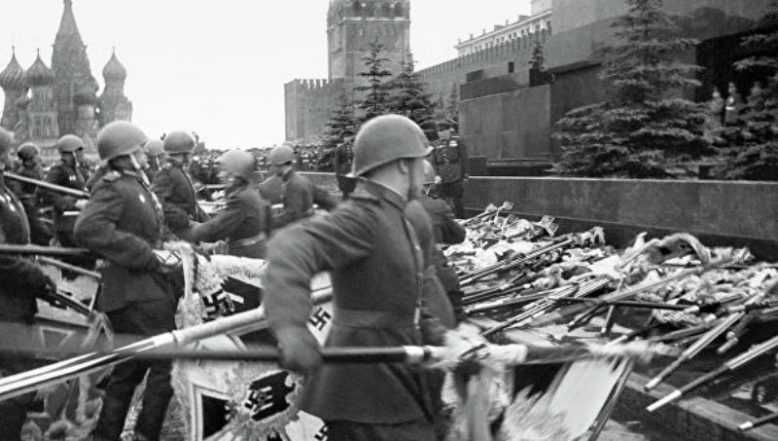
Парад Победы 24 июня 1945 года был не единственным в этом году
Столица Третьего Рейха пала на 17-й день штурма. 2 мая в 15:00 капитулировали остатки немецкого гарнизона.
4 мая 1945 года состоялся военный парад советских войск Берлинского гарнизона, двигавшихся торжественным маршем на площади у Бранденбургских ворот и Рейхстага. Солдаты и офицеры шли мимо развалин домов, превращенных гитлеровцами в опорные пункты.
Они маршировали в тех же гимнастерках, в которых штурмовали столицу Германии. Улицы города еще дымились от пожаров, на окраинах города постреливали ещё не сложившие оружие фашисты.
Принимал парад военный комендант Берлина генерал Н. Э. Берзарин.
После июньского мероприятия в Москве, приуроченного к победе над фашистской Германией, Георгий Жуков, вернувшись в Берлин, предложил там же провести парад союзных войск. Мероприятие назначили на 7 сентября, а участвовать в нем должны были главнокомандующие войсками Советского Союза, Соединенного Королевства, США, Французской Республики в Германии, а также сводный полк в тысячу человек от каждой союзной страны и бронетанковые части. Но накануне парада главнокомандующие союзников сообщили, что не смогут принять участие, и прислали своих представителей, а парад, так же как и в июне, принимал в итоге Георгий Жуков.
А 16 сентября еще один парад советских войск, посвященный победе над Японией, прошел в китайском Харбине. К тому же в самом начале осени – 3 сентября было так же, как и 9 мая, объявлено нерабочим днем. И если 9 Мая ознаменовало победу советского народа против немецко-фашистских захватчиков, то 3 сентября было назначено Днем Победы во Второй мировой войне.
Предполагалось, что этот праздник будет главным, а день приурочили к победе над Японией. 3 сентября более не праздновался и парадов в этот день более не было. Вскоре и 9 Мая сделали рабочим днем, так длилось до 1965 года.
9 мая 1965 года
Следующий парад, посвященный Дню Победы, состоялся 9 мая 1965 года. Именно тогда этот день был официально объявлен всенародным праздником и выходным.
В 1965 году Леонид Брежнев снова объявил 9 мая нерабочим днем. В том же году вновь был проведен военный парад, приуроченный к 20-летию Победы. А 2 года спустя, также 9 мая, была торжественно открыта Могила Неизвестного Солдата.
По Красной площади впервые пронесли Знамя Победы. Знаменосцем был Герой Советского Союза полковник Константин Самсонов (на фото в центре), ассистентами — Герои Советского Союза сержант Михаил Егоров (слева) и старший сержант Мелитон Кантария (справа), которые 1 мая 1945 года водрузили это знамя над Рейхстагом.
Только в 1965 году эти люди смогли принять участие в Параде Победы, хотя они были приглашены и на парад 1945 года, но элементарно не прошли проверку умения ходить в строю. А ведь тогда, в 1945 первоначально предполагалось, что именно знамя, водруженное над Рейхстагом, пронесут впереди всего Парада. В 1945 не получилось — они были солдатами, их задачей был бой, а не строевая подготовка. В 1965 — времени на подготовку было явно больше…
В параде приняли участие части Московского гарнизона и курсанты высших военных училищ и академий, почти треть участников парада составляли ветераны Великой Отечественной войны.
Парады 1985, 1990 годов
Очередной парад 9 мая был проведен к 40-летию Победы — в 1985 г. Помимо воинских частей и современной боевой техники, в нем принимали участие колонны ветеранов и боевые машины времен Второй мировой войны танки Т-34-85, самоходные артиллерийские установки СУ-100, гвардейские реактивные минометы БМ-13 «Катюша»).
Военный парад, посвященный 40-летию Победы советского народа в Великой Отечественной войне 1941-1945 годов.
Военнослужащие — участники исторической части парада — были одеты в форму времен Великой Отечественной.
Парад 9 мая 1990 года был последним в эпохе советского государства. В нем также принимала участие военная техника времен Великой Отечественной войны. Во время исторической части парада по Красной площади проехал тягач с макетом точной копии памятника Воину-освободителю, установленного в Трептов-парке в Берлине.
Далее на протяжении нескольких лет Парадов Победы в Москве на Красной площади не организовывалось.
Парады начиная с 1995 года
В 1995 году традиция масштабного празднования была возобновлена. Тогда парад ветеранов Великой Отечественной войны прошел на Красной площади, а военный парад – на Поклонной горе. С тех пор парад проводился ежегодно.
Бессменными атрибутами московского парада стали выступление президента РФ, мелодия «Славься» и принимающий парад Министр обороны РФ, который традиционно в 10 утра 9 мая выезжает на автомобиле из ворот Спасской башни. Еще одним символом Дня Победы стала георгиевская ленточка. Впервые акция, во время которой активисты раздавали всем желающим черно-оранжевые ленты, прошла в 2005 году.
В 2000 г. на параде пешим строем прошли ветераны Великой Отечественной войны. В 2005 г. их провезли по площади на 130 автомобилях, стилизованных под грузовики ГаЗ- АА («полуторки») 1940-х годов.
В 2005 г. на параде в честь 60-летия Победы в качестве гостей присутствовали ветераны вермахта, приехавшие вместе с канцлером Германии Герхардом Шредером. В том же 2005 г. возобновлено прерванное в 1957 г. участие авиации в парадах — над Красной площадью пролетели 4 истребителя МиГ-29, 5 истребителей Су-27 и 3 штурмовика Су-25.
Особенностью парада 2007 г. стало хоровое пение без музыкального сопровождения, в котором были задействованы 6 тыс. 637 военнослужащих.
В 2008 г. по Красной площади впервые с 1990 г. прошла тяжелая военная техника — танки Т-90, бронетранспортеры БТР-80, боевые машины пехоты БМП-3, самоходные артиллерийские установки «Спрут» и «Мста-С», различные зенитные системы («Тунгуска», «Тор», «Бук»), а также тактические («Искандер») и стратегические («Тополь») ракетные комплексы. До этого боевые машины не участвовали в параде из-за работ по реконструкции Манежной площади и восстановления Иверских ворот у въезда на Красную площадь.
В 2010 г. в параде на Красной площади впервые с 1945 г. приняли участие иностранные военные — из 13 стран, в том числе Великобритании, США, Франции, Польши и государств СНГ (по 75 человек от каждой страны). Всего в 2010 г. в Параде Победы участвовали 11 тыс. 300 солдат и офицеров, 161 единица военной техники, 127 самолетов и вертолетов.
В параде 2011 г. участвовало рекордное в новейшей истории России количество военнослужащих — почти 20 тыс. человек, а также 106 единиц военной техники и 5 вертолетов Ми-8.
9 мая 2012 г. по Красной площади прошли 14 тыс. военнослужащих и около 100 единиц военной техники. Впервые был продемонстрирован бронеавтомобиль «Рысь». В параде участвовали пять вертолетов Ми-8.
В 2013 г. в параде в честь 68-летия Победы участвовали 11 тыс. военнослужащих, свыше 100 единиц военной техники, в том числе впервые — бронетранспортеры БТР-82А. Парад военной техники завершил пролет 68 самолетов и вертолетов.
Парад Победы 2015 года на Красной площади, посвящённый 70-летию Победы в Великой Отечественной войне.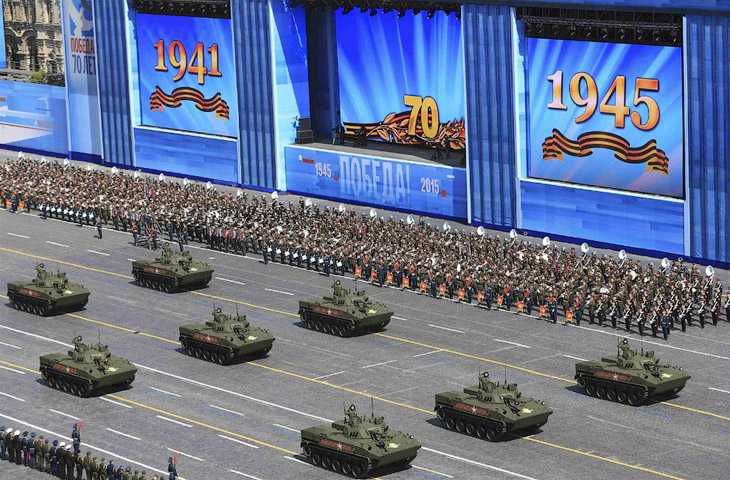
Парад завершился пролётом авиации. Пилотажные группы «Русские витязи» и «Стрижи» продемонстрировали знаменитый «кубинский бриллиант» в составе девяти истребителей Су-27 и МиГ-29.
В связи с растущей напряженностью в мире, парады приобрели яркие оттенки демонстрации военной мощи и политическое значение. С одной стороны это не есть хорошо, с другой — и без этого видимо никак.
В 2012 году в Томске впервые была проведена акция «Бессмертный полк», во время которой около 6 тыс. человек пронесли по городу фотопортреты участников Великой Отечественной войны. К 2014 году акция проводилась уже в 500 городах и семи странах. Сколько городов и стран присоединились в этом 2019 году к движению Бессмертный полк — точно не известно, понятно одно — их на порядок больше. Только количество стран идет уже на десятки.
Прямая трансляция Парада 9 Мая 2019 года с Красной Площади в Москве
Красная площадь является не только самым популярным и посещаемым туристами местом в столице России, визитной карточкой и сердцем нашей страны. Она уже давным-давно стала главным военным плацем Отчизны. Именно здесь проходили славные военные парады, пышность и мощь которых всегда вызывали не только гордость соотечественников за свою державу, но и страх у недругов и политических соперников.
Невзирая на смену правительств, социальных систем и даже названия страны, в строго установленные дни государственных праздников у стен Кремля многие десятки лет проводились красочные ритуалы с участием элиты армии и флота. Главным предназначением военного парада, помимо пышной феерии, является демонстрация готовности нашей страны в любой момент отразить военное вторжение врагов, заставить их понести суровую кару за посягательства на святую русскую землю.
История проведения военных парадов берет начало в середине 17-го века, когда торговая площадь, Торг, перед стенами Кремля еще не носила нынешнего названия. Тогда Торг был местом, где объявляли царские указы, совершались публичные казни, бурлила торговая жизнь, а по святым праздникам именно здесь устраивались массовые крестные ходы. Кремль в те времена имел вид хорошо укрепленной крепости с орудийными башнями и огромным опоясывающим его рвом, ограниченным с обеих сторон белокаменными стенами.
Красная площадь во второй половине XVII века, работа Аполлинария Васнецова
Словом «красная» на Руси в то время нарекали все красивое. Площадь с восхитительными шатровыми куполами на кремлевских башнях стала так называться при царе Алексее Михайловиче. К этому времени крепость уже утратила свое оборонное значение. Постепенно стало традицией для русских войск после очередного победоносного сражения с гордостью проходить по центральной площади мимо Кремля. Одним из самых потрясающих зрелищ древнего времени стало возвращение русской армии из-под Смоленска в 1655-ом году, когда сам царь шел впереди с непокрытой головой, неся на руках своего маленького сына.
Многие историки считают, что первым можно считать парад, состоявшийся 11 октября 1702-го года, после того, как войско во главе с Петром Великим возвратилось после взятия крепости Орешек (Нотебург). Мясницкую улицу в этот день покрыли красным сукном, по которому проехала золоченая карета царя, волоча по земле поверженные шведские знамена. Другая группа экспертов склонна утверждать, что первым является парад 1818-го года, состоявшийся в честь открытия известного всем гостям столицы памятника гражданину Минину и князю Пожарскому. На тот момент Красная площадь уже имела привычные для нас очертания и стала вполне пригодной для войсковых смотров. Защитный ров был засыпан, а на его месте возник бульвар. Напротив Кремлевской стены было построено здание верхних торговых рядов. Во время коронационных торжеств кортеж императора проходил через площадь, следуя к Спасским воротам для въезда в Кремль.
Более широкое распространение военные парады получили в конце 18-го века. В Петербурге они проводились традиционно два раза в год: зимой на Дворцовой площади, а весной на Марсовом поле. А в Первопрестольной шествия войск организовывались от случая к случаю и проходили на территории Кремля. Хотя бывали и исключения. Например, 30 мая 1912-го года, когда неподалеку от Храма Христа Спасителя проходило открытие памятника императору Александру III, торжественное шествие военных подразделений, возглавляемое лично Николаем II, состоялось возле нового монумента. Вслед за царем тогда проследовала рота дворцовых гренадеров и сводный пехотный полк, который является предшественником нынешнего Президентского полка в России. Затем, отдавая честь царю, прошли в шлемах с орлами и белых элитных кителях кавалергарды, выполняющие почетную функцию императорской охраны. Последний московский парад с участием Николая II состоялся 8 августа 1914-го, то есть спустя всего неделю после начала Первой мировой войны. В честь дня рождения государя военный смотр проходил в Кремле, но на Ивановской площади.
Николай II принимает парад во время церемонии открытия памятника Александру III
Вскоре после отречения Николая II от престола весной 1917-го года, когда власть была передана Временному правительству, 4 марта состоялся смотр революционной армии под управлением командующего войсками Московского гарнизона полковника Грузинова. Вся Красная площадь и прилегающие к ней улицы были заняты праздничной толпой, над которой курсировали аэропланы. По площади двигался нескончаемый поток вышагивающих стройными рядами людей в военных шинелях с поблескивающими штыками. Именно таким запомнился очевидцам первый парад в истории новой России.
В марте 1918-го года после того как власть захватили большевики и всеобщая эйфория буржуазных революционных преобразований сменилась политическим хаосом, братоубийственной войной и полным развалом экономики, высшее руководство переехало из Петрограда в Москву. С тех пор Красная площадь становится главным местом проведения всех государственных торжеств, а Кремль – постоянной резиденцией правительства страны.
Когда на кремлевских стенах, Никольской и Спасской башнях еще были видны следы боев ноября 1917-го, у стен Кремля среди свежих братских могил революционеров была установлена трибуна для парада в честь празднования 1 мая весной 1918-го. Сооружение из дерева в виде прямоугольника стало своеобразным памятником жертвам борьбы за «светлое будущее». В тот день колонны демонстрантов, состоящие из красноармейцев и гражданских лиц, начали свое движение от Исторического проезда к Храму Василия Блаженного. Первый парад частей Красной Армии, в котором согласно официальному заявлению участвовало около тридцати тысяч человек, состоялся вечером того же дня на Ходынском поле, а руководил им комиссар по военным делам Лев Троцкий. На том параде не обошлось без казусов: полк латышских стрелков, которые тогда использовались для охраны правительства, в полном составе покинул место проведения парада, выразив этим свое недоверие Троцкому.
Несмотря на первоначально принятую большевиками декларацию об отказе от имперских традиций, военные смотры и шествия не потеряли актуальности. Следующее торжественный проход войск состоялся в честь первой годовщины Октября и уже на Красной площади. К 7 ноября 1918-го года центральная площадь страны была спешно приведена в порядок, а памятное шествие приветствовал лично вождь пролетариата Владимир Ульянов-Ленин. Необходимо отметить, что первые парады постреволюционной России мало напоминали военные шествия Царской армии, они больше походили на народные шествия с участием военных.
В.И.Ленин произносит речь на Красной площади в день празднования 1-й годовщины Великой Октябрьской социалистической революции. Москва, 7 ноября 1918 года
С тех пор парады стали проходить по различным поводам. Например, в марте 1919-го состоялось шествие, посвященное московскому конгрессу Третьего Интернационала. А на первомайском параде в том же году по Красной площади впервые вслед за колоннами проезжал танк. 27 июня 1920-го года проходил парад в честь конгресса Второго Интернационала, который был организован уже более профессионально. Интересный вид имела центральная трибуна, которая была похожа на пункт наблюдения на вершине холма, а военные формирования продвигались не хаотически, а стройными рядами. 1 мая 1922-го года в регламенте военного парада появилась новая церемония, связанная с принятием военной присяги. Данная традиция была сохранена вплоть до 1939-го года. Подобно парадам императорской армии на первых постреволюционных шествиях расчеты передвигались длинным строем по две шеренги. Двигаться четкими рядами по разбитой каменной мостовой в таком порядке было достаточно сложно.
Следующие существенные изменения облика Красной площади произошли после смерти Ленина, первого руководителя Страны Советов, в 1924-ом году. Напротив Сенатской башни была выстроена временная усыпальница Вождя революции. Через четыре месяца на ее месте появился деревянный мавзолей с трибунами по бокам. Именно с этих трибун отныне все руководители страны стали приветствовать проходящих во время шествий демонстрантов. А у входа в мавзолей появляется пост №1, на котором постоянно дежурят курсанты военного училища.
23 февраля 1925-го года Михаил Фрунзе впервые осуществлял не обход, а объезд войсковых построений, сидя верхом на коне.
23 февраля 1925-го года Михаил Фрунзе, сменивший Троцкого на посту руководителя, впервые осуществлял не обход, а объезд войсковых построений, сидя верхом на коне. Последним парадом с участием этого героя гражданской войны стало первомайское праздничное шествие 1925-го года, на котором впервые были даны орудийные залпы салюта из пушек, установленных внутри Кремля. Ворошилов, приступивший после Фрунзе к обязанностям принимающего парад руководителя, также объезжал войска на коне. С 1 мая 1925-го года представители различных родов войск были одеты на параде в однообразные гимнастерки, и уже не наблюдалось той пестроты в обмундировании, которая присутствовала ранее. На общем фоне белыми бескозырками выделялась только рота балтийских моряков и колонна высшей школы военной маскировки. Помимо этого пехотные формирования теперь проходили в новом «шахматном» порядке. Вслед за ними двигались велосипедисты-самокатчики, кавалерия и, наконец, бронетехника, представленная бронеавтомобилями и танками. С этого дня и вплоть до наших времен массовое прохождение военной техники при проведении парадов стало обязательным пунктом. Данный первомайский парад отличился еще одним новшеством, а именно участием авиации. Во время шествия над площадью нестройным клином пролетели восемьдесят восемь аэропланов.
07.11.1927 г. Площадь еще без брусчатки — она появится между 1930-1931 гг, когда второй деревянный мавзолей Ленина заменят на железобетонный с облицовкой гранитом. Центральной трибуны на Мавзолее тоже нет, до этого советские вожди стояли на небольшой трибуне сбоку. Столб с репродукторами — остаток трамвайной линии, которая провели здесь в 1909 году. Со столбов только убрали ажурные подвески для проводов.
Отличительной особенностью парада 7 ноября 1927-го года стало то, что его принимало гражданское лицо, председатель Центрального исполкома Михаил Калинин, хотя командованием парада занимался Председатель Реввоенсовета Ворошилов. На этом праздничном шествии не было броневиков и танков, так как обстановка в стране была накалена до предела. Находящийся на вторых ролях Сталин опасался военного переворота, так как авторитет Троцкого в войсках был еще достаточно высок. Зато в параде принял участие сводный Северо-Кавказский кавалерийский полк, который с гиканьем промчался по площади в черных бурках.
В параде 1 мая 1929-го года Красная площадь в последний раз предстала в своем старом виде с совершенно разбитой мостовой и неуместным деревянным мавзолеем среди каменных стен. Стоящие посреди площади фонарные столбы значительно ограничивали ширину проходящих колонн и затрудняли прохождение техники. Вследствие плохого состояния брусчатки перед каждым парадом ее приходилось посыпать песком, чтобы облегчить движение военной техники и снизить скольжение лошадиных копыт. В этом первомайском параде по Красной площади впервые прошла бронетанковая техника отечественного производства, но на машинах отсутствовали боевые орудия, место которых заняли зачехленные макеты. Оснастить технику оружием попросту не успели. Но на параде 7 ноября все боевые машины уже имели полноценное штатное вооружение.
Первомайский парад 1930-го года проходил в условиях, когда большая часть площади была ограждена забором, за которым ударными темпами возводился новый мавзолей Ленина из камня. Реконструкция завершилась к 7 ноября того же года. Площадь была замощена прочнейшей брусчаткой из диабаза, а величие ей теперь добавлял новый мавзолей, облицованный красным гранитом. Трибуны в то время располагались только по бокам от усыпальницы. При съемке этого парада на кинокамеры впервые записывался живой звук.
От парада к параду постоянно увеличивалась численность его участников и военной техники. Проблема была лишь в том, что узкие Воскресенские ворота Китай-города ограничивали проезд боевых машин. В 1931-ом эти ворота были, наконец, снесены, а загораживающий проход памятник Минину и Пожарскому был перенесен к Храму Василия Блаженного. В 1936-ом был снесен и Казанский собор, а Васильевский спуск очистили от застроек. Сгоряча чуть было не убрали исторический музей и Храм, но благоразумие взяло верх, и бесценные памятники остались на своем месте.
Традиция внеочередных военных парадов четко просматривалась и в 30-ых годах. Памятный парад 9 февраля 1934-го, приуроченный к XVII съезду партии, поражал своей масштабностью. В нем участвовало сорок две тысячи военнослужащих, из которых двадцать одна тысяча были пехотинцами, а тысяча семьсот всадниками. В тот день по центральной площади страны проследовали пятьсот двадцать пять танков, а сам парад длился более трех часов! Смотр показал, что за пятилетний период техническая оснащенность Красной Армии многократно возросла, превратив ее в грозную, хорошо подготовленную силу, что и было отмечено присутствующими иностранными дипломатами и корреспондентами. «Таймс» писала, что Советская Армия действительно показала первоклассную дисциплину и организацию, хотя указала на факт вывода из строя одного танка, флотского пулемета и прожектора во время шествия. Подобные конфузы, конечно, иногда случались. На случай непредвиденной поломки техники были даже разработаны подробные планы по ее быстрой эвакуации подальше от глаз наблюдателей. Однако на параде в 1932-ом одним иностранцем были сделаны снимки произошедшего столкновения двух тачанок.
На параде войск Московского гарнизона. 1934 год.
В ответ на начало милитаризации Германии и изменение политической ситуации в Европе в 1935-ом году Сталин решает продемонстрировать всю мощь советских военных сил. В первомайском параде участвовало пятьсот танков, в воздух поднялось восемьсот летательных аппаратов, флагманом которых стал восьмимоторный «Максим Горький», сопровождаемый двумя истребителями. Вслед за ними в несколько ярусов пролетели бомбардировщики, которые буквально закрыли небо над площадью своими крыльями. Настоящий фурор вызвала пятерка появившихся в небе красных И-16. Снизившись почти до зубцов кремлевской стены, эти истребители с ревом пронеслись над зрителями. Согласно распоряжению Сталина каждый из пилотов этой пятерки получил не только денежную премию, но и внеочередное звание.
Поскольку в общую картину Красной площади уже совершенно не вписывались расположенные на башнях Кремля и исторического музея императорские орлы, то уже осенью 1935-го их заменили звездами, изготовленными из металла с уральскими самоцветами. Через два года эти звезды были заменены красно-рубиновыми с подсветкой изнутри. Кроме того, в конце 30-ых годов перед мавзолеем была установлена центральная трибуна, которая теперь возвышалась над надписью «Ленин», символично подчеркивая значимость людей, стоящих на ней.
Первомайский парад 1941-го года стал последним мирным шествием довоенной страны. В сложившихся в Европе условиях демонстрация мощи СССР имела особое значение, особенно если учесть, что среди иностранных представителей находились и высшие чины Вермахта. Буденный считал, что от того насколько удачно Советы покажут свою мощь и подготовку, может зависеть будет ли Советский Союз втянут в противостояние с немцами. Огромное моральное напряжение приводило к тому, что некоторые участники просто теряли сознание, а потому почти у каждого имелся в кармане флакон с нашатырным спиртом. Произнесенная с трибуны речь Маршала Тимошенко имела четко прослеживаемую основную идею – стремление СССР к мирной политике. Новинкой данного парада стало участие мотоциклетных частей, которые только начинали формироваться в Красной Армии. Значительным был и показательный вылет новейших пикирующих бомбардировщиков. Однако согласно докладу одного из офицеров Вермахта после состоявшегося парада, «русский офицерский корпус, находился в плачевном состоянии и производил жалкое впечатление», а «СССР потребуется не менее двадцати лет для восстановления утраченного командного состава». На основании чего были сделаны изложенные умозаключения, можно только догадываться.
Парад состоявшийся 7 ноября 1941-го года.
Одним из самых памятных и значимых стал торжественный парад войск, отправлявшихся с Красной площади прямо на фронт, состоявшийся 7 ноября 1941-го года. В эти дни фронт максимально приблизился к сердцу нашей Родины и находился на расстоянии в семьдесят километров. Звезды башен Кремля были укрыты чехлами, а позолоченные купола собора закрасили в целях безопасности и маскировки. Вопреки стремлению Гитлера отметить годовщину Октября парадом немецких войск в центре Москвы, Советское руководство организовало свой парад, целью которого было внушить нашим соотечественникам уверенность и развеять обстановку хаоса и безысходности, которая царила на тот момент в столице.
Решение о проведении парада было озвучено накануне вечером 6 ноября лично Сталиным на торжественном заседании, которое началось через двадцать минут после отбоя воздушной тревоги, вызванной попыткой двух сотен немецких бомбардировщиков прорваться к столице. Подготовка к параду проходила в обстановке строжайшей секретности, а само мероприятие приравнивалось к военной операции. Для обеспечения безопасности начало парада было назначено на восемь утра, а все его участники инструктировались на случай объявления воздушной тревоги. Принимающим парад был заместитель Наркома обороны маршал Буденный, которого сопровождал командующий парадом генерал-лейтенант Артемьев.
Первый и единственный раз в тот день Сталин произнес речь с трибуны мавзолея, назвав своих соотечественников сестрами и братьями. Его полная патриотизма речь произвела ожидаемый эффект, вдохновив уходящих в бой воинов и жителей столицы на неизбежность нашей победы над агрессором. В торжественном параде 7 ноября 1941-го года принимали участие около двадцати восьми тысяч человек, а самыми многочисленными были войска НКВД в количестве сорока двух батальонов. Интересен тот факт, что начало парада не было зафиксировано на кинопленке, так как в целях секретности киношников не предупредили о предстоящем мероприятии. Операторы с камерами прибыли на площадь уже позднее, услышав трансляцию с парада по радио.
В том памятном параде в первый и последний раз принимали участие засекреченные ранее танки Т-60, Т-34 и КВ-1. В отличие от прочих торжеств боевая техника была снабжена боеприпасами на тот случай, если поступит приказ о выдвижении в сторону фронта, однако бойки все же были изъяты из орудий для безопасности и находились у командиров расчетов. После этого символического ноябрьского парада весь мир понял, что СССР никогда не покорится врагу. Памятная реконструкция этого шествия состоялась спустя семьдесят лет в ноябре 2011-го и с тех пор проводится ежегодно 7-го ноября.
Следующее торжество на Красной площади прошло лишь спустя три с половиной года 1 мая 1945-го, когда все уже жили ожиданием победы, а в глубине фашистского логова шли последние кровопролитные бои. Вплоть до 1944-го года на военных парадах исполнялся «Интернационал», который являлся гимном страны. На первомайском параде 1945-го впервые прозвучал новый гимн СССР. Спустя год Народный Комиссариат обороны будет переименован в Министерство обороны, а Красная Армия станет называться Советской.
Еще более торжественным и ликующим событием стал победный парад 1945-го. Решение о проведении праздника было принято руководством 9 мая, а через две недели был передан приказ командования о том, что каждый фронт должен выделить сводный полк численностью 1059 человек для участия в шествии. 19 июня в Москву самолетом было доставлено победоносно водруженное над Рейхстагом красное знамя. Именно оно было обязано присутствовать во главе колонны, а нести его должны были те, кто непосредственно водрузил знамя в Германии. Однако при подготовке к параду эти героические люди показали неудовлетворительные способности к строевой подготовке, и тогда Жуков отдал распоряжение о транспортировке знамени в музей Вооруженных Сил. Таким образом, в главном параде XX-го века, проходившем 24 июня 1945-го года, главный символ победы так и не принял участие. Он вернется на Красную площадь лишь в юбилейный 1965-ый год.
Принимал Парад Победы маршал Жуков в сопровождении своего адъютанта верхом на белом жеребце под проливным дождем, немного испортившим торжественную атмосферу события. Сам парад впервые был отснят на цветную трофейную пленку, проявлять которую пришлось в Германии. К сожалению, из-за искажений цветов фильм позже был переведен в черно-белый вариант. Последовательность следования сводных полков определялась порядком расположения фронтов при проведении военных действий к окончанию войны с севера на юг. Возглавлял шествие полк 1-го Белорусского Фронта, бойцы которого водрузили знамя в Берлине. А апофеозом праздника стало низложение вражеских немецких знамен у Мавзолея. Парад продолжался чуть более двух часов. Демонстрацию трудящихся Сталин распорядился исключить из программы праздника. Москвичи и фронтовики долго ждали самой речи руководителя страны, но Вождь так и не обратился к своему народу. Несколько фраз произнес с трибуны лишь маршал Жуков. Не было на празднике и символичной минуты молчания в память о погибших. Фильм о параде облетел всю страну и везде его просмотр проходил при полном аншлаге. Необходимо уточнить, что лишь спустя два десятилетия в 1965-ом году день 9 мая станет официальным праздником Победы.
12 августа 1945-го на Красной площади вновь состоялся парад, но это было шествие физкультурников, которое было характерным еще для 30-ых годов. Примечательным фактом данного события стало то, что на трибуне Мавзолея в первый и в последний раз стояли представители США. Масштабное событие с участием двадцати трех тысяч участников длилось пять часов, в течение которых продолжалось непрерывное движение колонн, а большая часть площади была покрыта специальным зеленым сукном. Полученные от спортивного парада впечатления заставили Эйзенхауэра сказать, что «эту страну невозможно победить». В эти же дни на японские города были сброшены атомные бомбы.
В 1946-ом остро поднимался вопрос о прохождении танков по Москве в связи с аварийным послевоенным состоянием домов, которые просто разрушались при движении тяжелой техники по улицам. Перед подготовкой к масштабному смотру танковой техники 8 сентября 1946-го года к мнению главного градоначальника прислушались, и теперь маршрут прохода машин разрабатывается с учетом состояния жилого фонда столицы.
1957 г.
С парада 1957-го года станет традицией демонстрация различных ракетных систем. В этот же год авиация не выступила на торжестве вследствие нелетной погоды. Участие пилотов в парадах на главной площади возобновится лишь через сорок восемь лет на майском параде 2005-го.
Начиная с первомайского парада 1960-го года, военные парады становятся своеобразным грозным символом противоборства двух политических миров. Данное торжество началось с вынесения Хрущевым, стоящим тогда у власти, решения об уничтожении самолета-разведчика U-2, ворвавшегося в небо над СССР и проследовавшего до Урала. Эмоциональный Никита Сергеевич воспринял такую наглость как личное оскорбление. Решительный ответ с помощью зенитного комплекса поставил крест на возможности мирно решить назревшие между Англией, США и СССР вопросы.
1967 г.
С 1965-го года, в течение последующих восемнадцати лет военные парады на Красной площади принимал Л.И. Брежнев. Порядок расположения главных лиц страны на трибуне мавзолея в те годы красноречиво говорил о предпочтениях в среде руководителей и об отношении первого лица к приближенным.
Парад 1 мая 1967-го, проходящий в год 50-летия Советской власти, отличался проведением театрализованного исторического шоу с участием колонн красноармейцев, переодетых в шинели образца Гражданской войны, комиссаров в кожаных куртках и перепоясанных пулеметными лентами матросов. После длительного временного перерыва на площади вновь появился эскадрон кавалеристов, за которым по брусчатке прогремели тачанки с пулеметами. Затем шествие продолжили бронемашины, имитирующие образцы начала 20-го века со встроенными пулеметами «Максим».
В 1968-ом году прошел последний первомайский военный парад. С этого года в празднование 1 мая по площади проходили лишь колонны трудящихся. А военную технику для обзора выводили на площадь лишь раз в году 7 ноября. В годы застоя, длившегося двадцать лет и приведшего к распаду СССР, после подписания договора о сокращении вооружений в 1974-ом году на Красной площади в последний раз народу были продемонстрированы межконтинентальные баллистические ракеты. В 1975-ом и 1976-ом годах в парадах не принимала участия бронетанковая техника и торжества занимали всего по тридцать минут. Однако 7 ноября 1977-го года танки снова появились на главном параде страны. А 7 ноября 1982-го Брежнев в последний раз появился на трибуне мавзолея.
Парад 7 ноября 1982-го
После смены нескольких руководителей 11 марта 1985-го года у власти оказался М.С. Горбачев. На параде в честь 40-летия победы 9 мая 1985-го, проходящего по уже привычному сценарию, в колонне ветеранов прошли не только русские воины, участники Второй мировой, но и поляки, а также ветераны из Чехии.
1990 г.
Последний парад Советской власти на Красной площади состоялся 7 ноября 1990-го, когда глава государства Михаил Сергеевич, подобно Сталину, произнес речь с трибуны Мавзолея. Однако его обращение к народу было полно тривиальностей и избитых фраз. Вскоре после этого произошел развал СССР с последующим разделением и дележом имущества армии…
Парады Победы в честь подвига русских людей в Великой отечественной войне стали проводиться лишь по юбилейным датам, они прошли в 1985-ом и 1990-ом годах. В период с 1991-го по 1994-ый год эта традиция была совершенно забыта. Однако в 1995-ом году в России появился приказ от 19 мая, согласно которому в честь 50-летия Великой победы возрождалась традиция проведения памятных торжеств и парадов в городах-героях, но при этом исключалось участие военной техники, наносившей большой вред их инфраструктуре. В том же году у Поклонной горы состоялись показательные выступления, где были продемонстрированы новые образцы боевых машин и техники. А по главной площади страны прошли немногочисленные колонны ветеранов войны.
Начиная с 9 мая 2008-го года, проведение военных парадов на Красной площади вновь стало регулярным, возобновившись спустя семнадцать лет. Сегодняшние парады значительно отличаются не только возросшими техническими возможностями и наличием массы красочных спецэффектов, но и беспрецедентным количеством задействованной техники, причем не только военной, но и съемочной, что позволяет показать событие в наиболее выгодных ракурсах и сделать крупные планы любого места или человека. Кроме того у трибун ныне устанавливается огромный экран, на который выводится живая картинка проходящего парада.
Источники информации:
-http://www.12min.ru/drugoe/parad-na-krasnoj-ploshhadi-ot-istorii-do-nashix-dnej.html
-http://www.tass-ural.ru/details/spravka_istoriya_voennykh_paradov_na_krasnoy_ploshchadi.html
-http://www.mosoblpress.ru/regions/23/mass_media/3/108/item104578/
-http://goup32441.narod.ru/files/ogp/001_oporn_konspekt/2006/2006-09-3.html
Самый первый Парад Победы на Красной площади прошёл 24 июня 1945 года. На Мавзолее солдат приветствовал Иосиф Сталин. Открывал парад маршал Георгий Жуков. По брусчатке прошло 35 000 человек. Знамёна немецких подразделений бросили к Кремлёвской стене. Первым туда упал штандарт личной охраны Гитлера.
Фото © ТАСС / Халдей Евгений
До 1965 года Парад Победы не проводился. 9 Мая даже не было выходным днём. Следующий раз победителей чествовали лишь в 1965 году. Традицию возродил новый глава страны Леонид Брежнев. Впервые в параде участвовали Егоров и Кантария, которые водрузили Красное знамя над Рейхстагом. В 1945-м их не пустили на площадь, так как солдаты плохо ходили строевым шагом.
Фото © Фотохроника ТАСС
И вновь 20-летнее молчание. Следующий Парад Победы состоялся лишь в 1985 году — на 40-летнюю годовщину Великой Победы. На параде совместили демонстрацию старой и новой советской боевой техники. Это был последний военный Парад Победы Советского Союза. Через шесть лет страны не стало.
Фото © ТАСС / Пушкарев Альберт
Традицию парадов возродили в 1995 году. Их стали устраивать ежегодно. Для страны это было не самое победное время, и таким образом власти пытались поднять моральный дух. Парад, как некогда и в СССР, разделили на части. По Красной площади прошла историческая техника. А вот современное вооружение демонстрировалось на Поклонной горе. Там для этого соорудили сцену.
Фото © ТАСС / Малышев Николай
В 2000 году состоялся последний пеший парад ветеранов войны. Пожилые участники боевых действий прошли в колоннах по Красной площади, как некогда шли в 1945 году.
Фото © ТАСС / Денисов Антон
В 2005-м ветеранов по Красной Площади провезли. В финале парада их усадили в грузовики, стилизованные под полуторки времён Великой Отечественной. В параде участвовало четыре тысячи ветеранов и семь тысяч военнослужащих. Кроме того, зрителям показали авиашоу: в небе пролетели девять самолётов.
Фото © ТАСС / Жуков Сергей
Празднование 65-летия Победы в 2010 году выглядело более масштабно. По площади прошло почти 12 тысяч солдат, 161 единица техники. А в небо на этот раз поднялось 137 самолётов и вертолётов. На трибуне присутствовали многие важные гости, например канцлер Германии Ангела Меркель и глава Китая Ху Цзиньтао.
Фото © ТАСС / Шарифулин Валерий
Самый масштабный парад в новейшей истории состоялся в 2015 году. По Красной площади прошло 15 тысяч человек. В небе пролетело 140 самолётов и вертолётов. Гостям показали 194 единицы боевой техники и её новейшие образцы, например танк «Армата».
Фото © ТАСС / АР / Ivan Sekretarev
Нынешний парад, видимо, запомнится тем, что он впервые с 1945 года пройдёт не 9 Мая, к тому же в условиях напряжённой эпидемиологической ситуации. Тем не менее по Красной площади пройдут 14 тысяч военнослужащих. А по количеству техники он превзойдёт все прочие. По брусчатке проедут 234 единицы боевых машин, в небе пролетят 75 самолётов и вертолётов.














